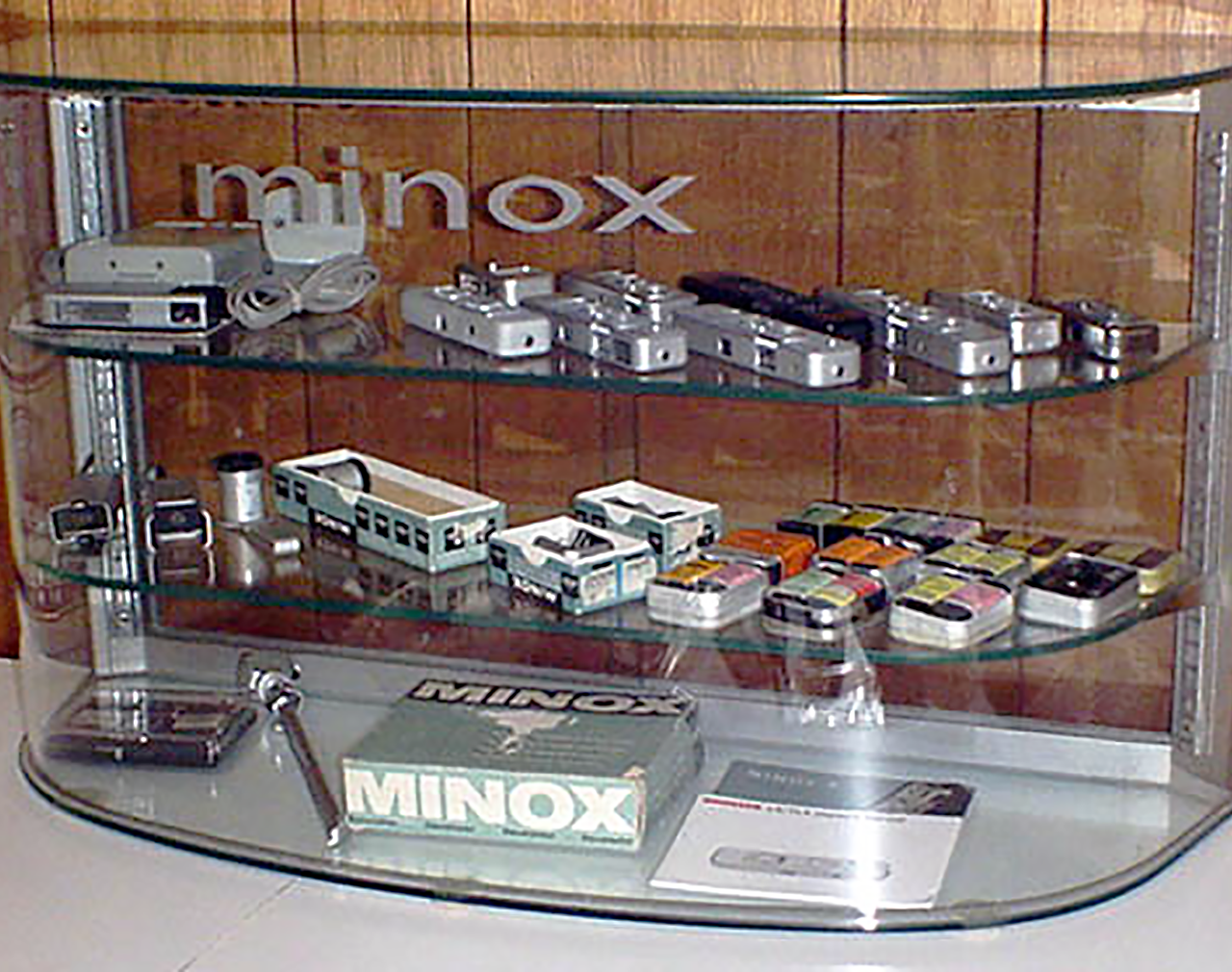Some of the following companies that manufacture(d) photographic material have already passed by in other parts of the site. Here you will find an overview of companies that marketed photographic material in the nineteenth and twentieth centuries. More is usually known about the best known or the most influential companies than about the lesser known ones; therefore they will be discussed more extensively than others.
The emphasis in this part of the site is more on the ups and downs of the company as such, while in other chapters the emphasis was on the product or on the man or woman who founded the company. The order of all companies is alphabetical.
Below are the names of the companies as will be discussed in this or any other chapter. By clicking on a name (so not on the bullet in front of it), you go directly to that part on this page where the manufacturer in question is located. Scrolling is also possible of course, but this service helps you to get to the desired manufacturer in question much faster.
Due to the fact that this introductory page has become much longer than originally planned and desirable due to the large number of manufacturers, we strongly advise you to use the name service below to go to the manufacturer of your choice on this or any subsequent page.
- General Introduction
- ADOX
- Agfa (see also Gevaert)
- Altissa
- Amaloco
- Ansco Camera Co (see also GAF)
- APM/APeM (see also Soho)
Amalgamated Photographic Manufacturers Ltd - Argus Camera Co, Ann Arbor Michigan
- Arsenal (see Kiev-Arsenal)
- Artima Export Ltd (see also Truvox)
- Asahi Pentax
- Bencini
- BOLCo and E Elliott Ltd
(abbrev. for The British Optical Lens Company) - Carl Braun Kamera-Werk
- Canon Inc.
- J.T. Chapman, Manchester
- The Chicago Cluster of Companies
(consisting of 56 companies ) - Chinon
- Concord Camera Corp.
- K.G. Corfield & K.G. Corfield (Sales) Ltd.
- Coronet Camera Company
- Cosina Company, Ltd.
- Dacora
- Dixons
- Durst
- EHO-Altissa company (See Altissa)
- E Elliott Ltd and BOLCo
(abbrev. forThe British Optical Lens Company) - Ellison Kamra
(see also QRS Devry Kamra Company) - ELOP
- Ensign Ltd.
(distribution Company of Houghton-Butcher) - Ernemann-Kamerawerke AG
- Expo Camera Company
- The FED Company
- Ferrania
- Fisher-Price
- Fodor
- Foitzik-Kamerawerke
- C.F. Foth
- Fototecnica
- Franka Kamerawerk –
- Fujica (Camera Division of Fujifilm)
- Fujifilm (brief history)
- Futura
- GAF (see also ANSCO)
(abbrev. for General Aniline & Film) - Louis Gandolfi
- Herbert George Company
- Gevaert Photo-Producten N.V. (see also AGFA)
- Girard et Cie
- GNOME
- GOERZ
- GOMZ (LOMO)
- Graflex (Folmer & Schwing)
- Great Wall Plastics Co
- W. Haking Enterprises Ltd.
- Hanimex
- Hasselblad
- Healthways
- Houghton–Butcher Manufacturing Co
(See also Ensign Ltd. and Ross-Ensign Ltd.) - R.F. Hunter Ltd.
- ICA AG
- Ihagee (Exakta)
- Ilford
- Imperial Camera Corporation
(see the Herbert George Company story ) - Jos-Pe
- Kamera-Werkstätten Guthe & Thorsch
- Keystone
- Kiev Arsenal
- KMZ
- Kochmann
- Kodak USA (incl. Australia, Canada, France, Germany & the UK)
- Konica-Minolta (Konishiroku)
(see also Minolta) - Kowa
- Krügener
- Kürbi & Niggeloh (Bilora)
- Kyocera (Yashica, Contax)
- Lancaster
- Leitz
- Lensless Camera Manufacturing Company
- Linhof
- Lipca (see also Richter-Tharandt)
- LOMO (see GOMZ)
- Loreo
- Mamiya
- Meopta Optotechnica
- Mimosa AG
- Minolta (see also Konica-Minolta)
- Minox Company
- Miranda (Orion)
- MMZ-BeLomo
- Motodori (Condor)
- Dr. August Nagel Kamera Werke
- Neidig Kamerawerk
- Nemrod-Metzeler (See Healthways)
- Nettel
- Nikon Company
- Nimslo Corporation (see also Nishika)
- Nishika Optical Systems (see also Nimslo)
- Noblex (See also K-W Guthe & Thorsch)
- Olympus Company
- ORION (see Miranda)
- ORWO
- Ottico Meccanica Italiana (OMI)
- Paterson Products Ltd.
- VEB Pentacon Dresden
- Pentax (See Asahi Pentax)
- Petri
- Photavit (Bolta)
- Plaubel
- Polaroid
- Photo Porst
- Karl Pouva – VEB Fototechnik Freital (see also Woldemar Beier)
- Purma Cameras Ltd.
- QRS Devry Kamra Company (see also Ellison Kamra)
- Foto-Quelle
- Rectaflex
- VEB Rheinmetall Büromaschinenwerk
- Richter-Tharandt (see also Lipca)
- Ricoh
- Rollei Germany
- Rollei Singapore
- Ross-Ensign
(continuation from Ensign Ltd.) - Ro-To Company
- Sea&Sea-Sunpak
- Shanghai Seagull
- Sida-Fotofex
- Sigma
- Soho Ltd (see also APM)
- Standard Cameras
- Steinheil
- Stenopeika
- Thornton-Pickard
- Topcon (Tōkyō Kōgaku)
- Tougodo Company
- Traid Corporation
- TRUVOX (see also Artima Export)
- Tura AG
- Universal Camera Corp.
- Vivitar
- Voigtländer
- Vredeborch
- Welta
- Werra (C. Zeiss Jena)
- Wirgin
- Kamera-Fabrik Woldemar Beier (see also Karl Pouva)
- Hermann Wolf GmbH
- Wünsche
- Yashica (see also Kyocera)
- Zeiss Ikon AG
- Zion
- Zunow (Teikoku Kōgaku)
FOUNDERS: Mamiya Seiichi and Sugawara Tsunejirō
1940: Mamiya Kōki Seisakusho, Mamiya Optical Works; 1950: Mamiya Camera Company, Ltd.; 1950: Mamiya Kōki Kabushiki Kaisha (Mamiya Optical Co., Ltd.); in 2006, Mamiya sold all its camera activities to an IT company, Cosmo Digital Imaging; the company now operates as Mamiya Digital Imaging Co.
COMPANY ADDRESSES:
1940: Tokyo, Hongo.
Mamiya is a Japanese company that manufactures high-end cameras and other related photographic and optical equipment. With headquarters in Tokyo, it has two manufacturing plants and a workforce of over 200 people.

Typical Japanese landscape with old Mamiya logo.
MAMIYA AFTER WORDWAR II
The first post war production of Mamiya cameras was sold entirely to Allied Forces personnel, not to the Japanese public, and a great many of the original Mamiya-6 folders found their way to both the USA and UK.
Over the course of the next 8 years, the Mamiya Six would be upgraded several different times, adding features like a rangefinder, dual 6×6 and 6×4.5 format, better shutters, and better lenses.
Immediately following WWII, Mamiya faced many production problems. Shutters and lenses were in short supply. Manufacturers began to make their own to meet demand. Unable to buy a sufficient supply of shutters and lenses from Chiyoda, their former supplier, Mamiya purchased a factory in Setagaya (Tokyo) to manufacture shutters and lenses for themselves.
Mamiya began to make its own Stamina shutters and Neocon (‘New Con[struction) lenses from 1947 in the Setagaya plant. In 1950, the Setagaya plant became the depending company Setagaya Kōki K.K. making the shutters and lenses. Setagaya Kōki was again merged into Mamiya Kōki in 1963.
However, Mamiya was very aggressive in pursuing the “top exporter” goal. By 1950, the company was incorporated as the Mamiya Camera Company, Ltd. By the mid 1950s, Mamiya would become one of the premiere Japanese camera makers. By 1951, it was listed on the Tokyo Stock Exchange and by May 1956, Mamiya was exhibiting cameras at the prestigious Photokina international show in Cologne, Germany.
 In May 1940 inventor Mamiya Seiichi and investor Sugawara Tsunejirō founded Mamiya Kōki Seisakusho, (Mamiya Optical Works). It was based in Tokyo, Hongo, and its first camera was the Mamiya Six, a 6 x 6 folder with coupled rangefinder that was focused by moving the film plane.
In May 1940 inventor Mamiya Seiichi and investor Sugawara Tsunejirō founded Mamiya Kōki Seisakusho, (Mamiya Optical Works). It was based in Tokyo, Hongo, and its first camera was the Mamiya Six, a 6 x 6 folder with coupled rangefinder that was focused by moving the film plane.
There were many versions in the Mamiya Six series, but it was the only Mamiya model for eight years. Mamiya saw immediate success upon the release of its camera, and was one of the few optical companies that continued to grow during World War II.
After the release of the first model of the Mamiya Six, the company continued to thrive, expanding production facilities in February 1942 and again, to three times the size, in February 1944, then employing 150 staff. By March 1944 a secondary factory was opened at Tokyo University for the manufacture and assembly of lenses. The Mamiya facilities in Tokyo were destroyed during WWII, and it was necessary to rebuild the entire company.
As early as October 1945, a month after Japanese surrender, Mamiya was the first Japanese company to receive an order to resume full-scale production of the Mamiya Six by the office of General Douglas MacArthur during the Allied occupation of Japan following World War II, in January 1946 at new facilities in Tokyo.
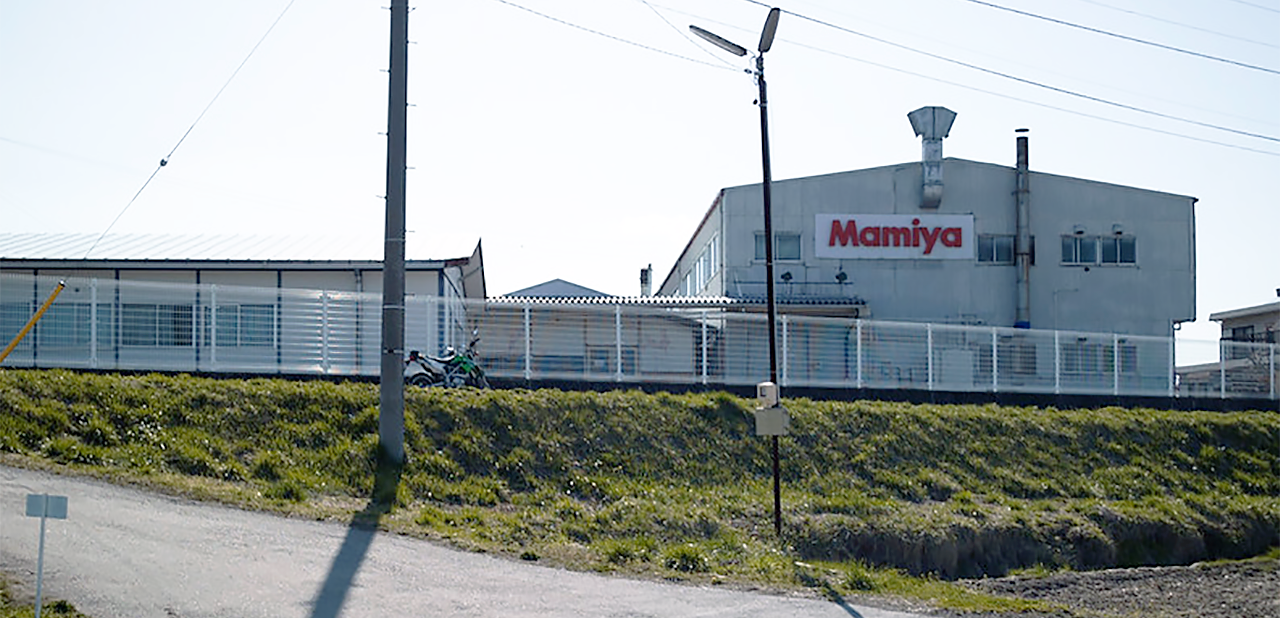
There is virtually nothing on the internet in terms of images from the 20th century of the Mamiya company. This is the only one I could find. It concerns the Mamiya Digital Imaging Co.,Ltd. saku factory.
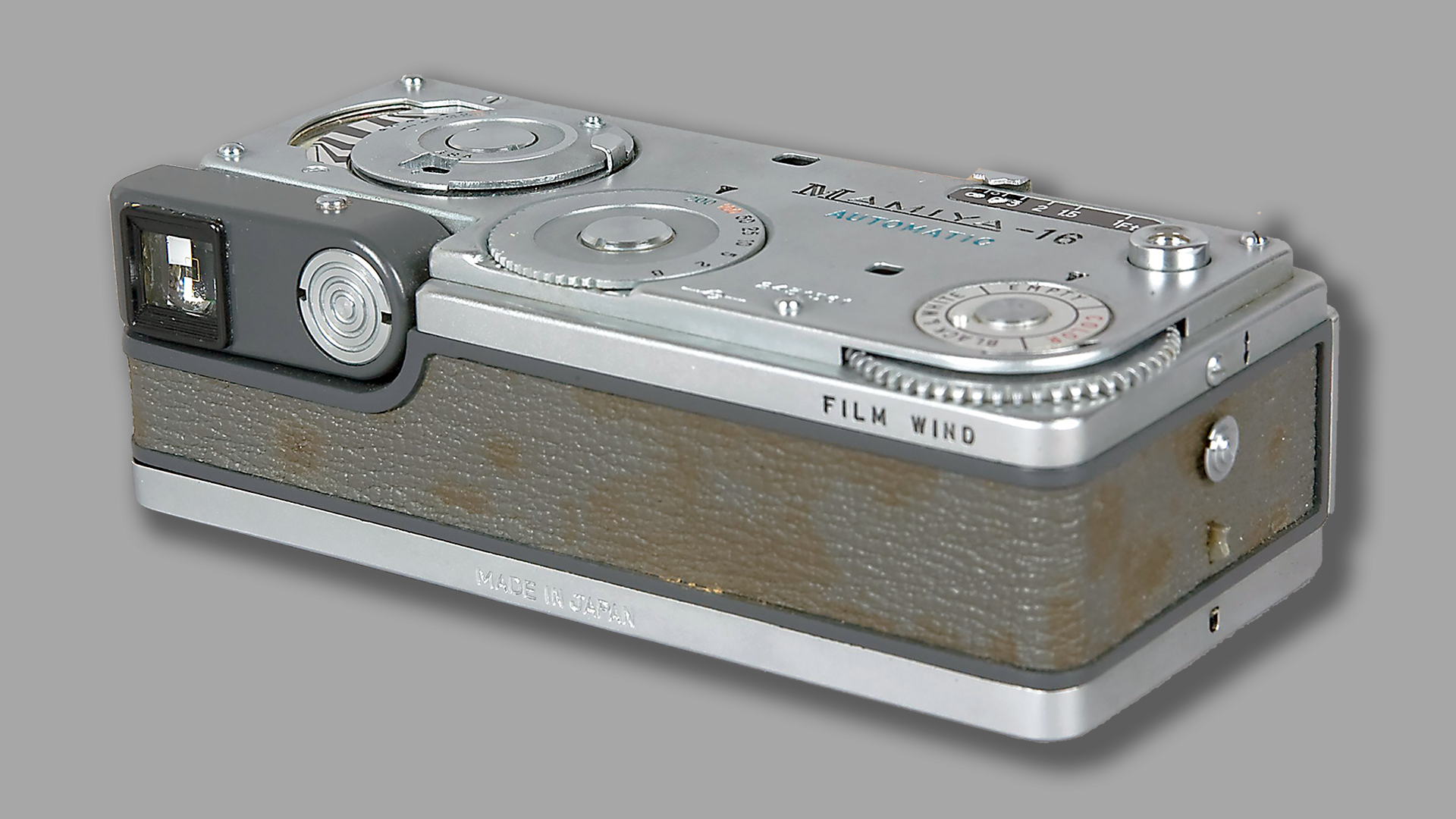
The Mamiya 16 Automatic camera is a good example of mid 20th century Japanese sub-miniature camera design. Mamiya were in the business of designing and manufacturing sub-miniature cameras from 1949 to 1962. The cameras they produced were well regarded for their features and ease of use. This Mamiya 16 was designed and made in 1959.
MAMIYA in the 70s and 80s
The RB67 Professional 6×7 SLR in 1970, the Mamiya M645 4.5×6 SLR in 1975 and the RZ67 Professional 6×7 SLR in 1982 confirmed Mamiya’s orientation towards the medium format professional market. Mamiya made a last attempt towards the amateur market at the end of the 1970s with some rangefinder and point and shoot 35mm cameras, together with their continuing series of 35mm SLRs.
In 1984, plans for the expansion of Mamiya’s popular Z-series of 35mm cameras were halted when Mamiya’s main international distributor, Osawa & Company (formerly Bell & Howell Japan) its sole overseas distributor and 10% stakeholder of Mamiya, declared bankruptcy. It was Japan’s third largest corporate bankruptcy since the end of World War II and caused significant disruption to Mamiya product distribution, creating severe financial difficulties. About a week later, Mamiya itself declared bankruptcy, which had a crushing, effect on the many companies that were affiliated with it.
Camera production continued at Mamiya factories only with the support of the Japanese government and the Cosmo 80 Group, one of Japan’s leading computer programming companies. Mamiya continued to manufacture their profitable medium-format SLRs (the fabulous Mamiya 645 Super was released to the market in 1985), but by June 1984 all Mamiya 35mm camera production had ceased.
In February 1988, Mamiya completed its reorganization. However, those years of financial woe forever ended Mamiya’s 35mm camera production and terminated a number of its medium format offerings (such as the Rapid Omega). Soon after reorganization, the highly acclaimed Mamiya-6 and Mamiya-7 medium-format SLR cameras were introduced.
Diversification
From 1948 the Mamiya range became more diversified, with the introduction of the Mamiyaflex series of 6×6 TLRs in 1948, the Mamiya 35 series of 35 mm fixed lens rangefinders in 1949 and the Mamiya 16 series of 16 mm film sub-miniature cameras in the same year. Together with the Mamiya Six, these four series were the basis of the Mamiya range throughout the 1950s. In 1950, the company name was changed to Mamiya Kōki Kabushiki Kaisha (Mamiya Optical Co., Ltd.). The last Mamiya Six version appeared in 1958.
In 1957 Mamiya introduced two innovative designs, the Magazine 35, a 35 mm camera with interchangeable backs, which only met a limited success, and the Mamiyaflex C, a 6×6 TLR with interchangeable lens pairs, that would be the first of a long series.
The first Mamiya 35 mm SLR was the Prismat, launched in 1960. The same year Mamiya introduced the Mamiya Press, a medium format press camera inspired by some Linhof models. Mamiya dropped the 35 mm rangefinders around the mid 1960s, and the Press, the Mamiya C and the 35mm SLRs formed the range at the end of the 1960s.
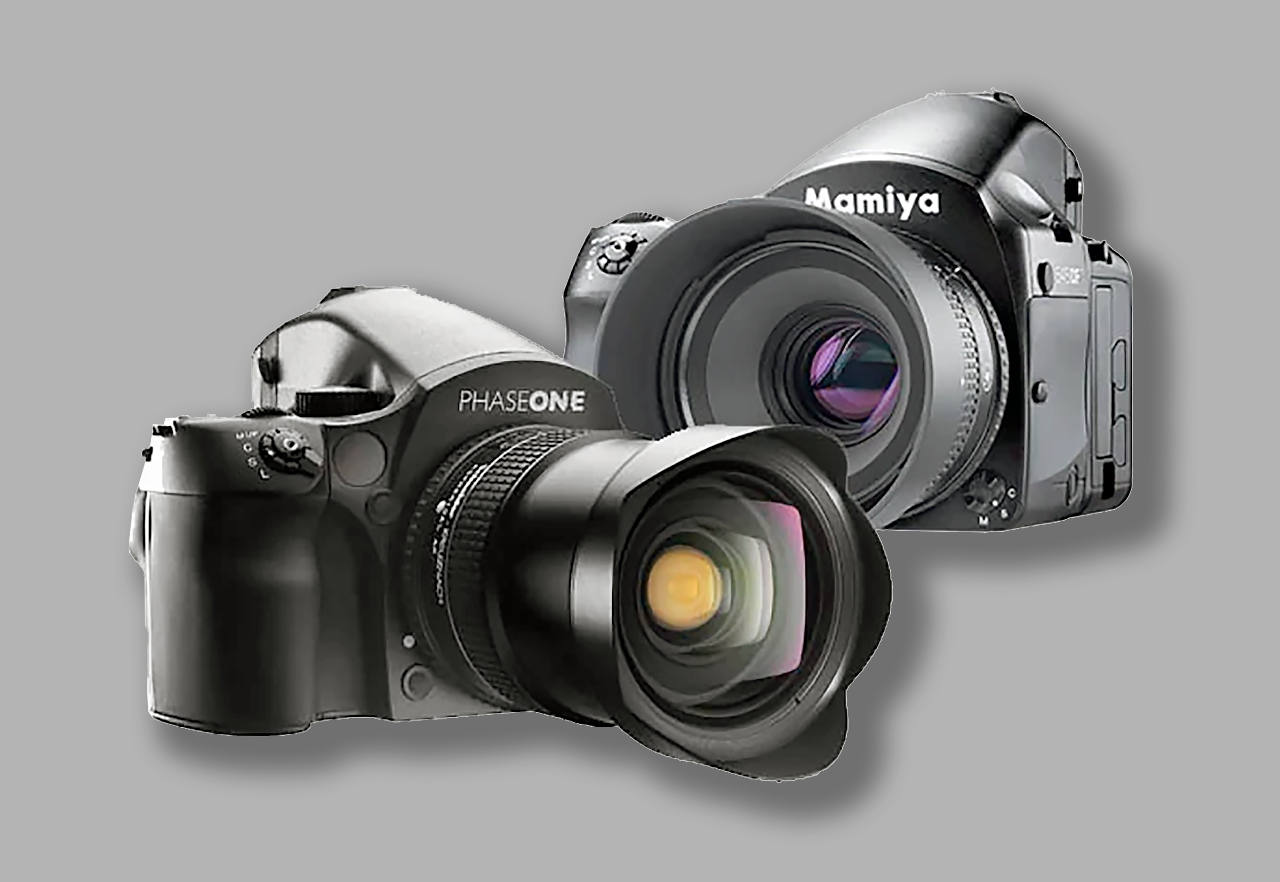
Phase One announced that it has acquired Mamiya and its medium format camera factories in Japan. The move will give the Danish Phase One more muscle in the medium format photography market.
Phase One became a 45% owner of Mamiya Digital Imaging back in 2009, gaining insight into the Japanese company’s camera and lens engineering and production. By purchasing the entire company, Phase One will be taking complete control over Mamiya’s design and development for medium format cameras, shutters, and lenses.
Tsunejiro Sugawara died in April 1988, shortly after Mamiya’s successful financial reorganization. In January 1989, Seichi Mamiya, the engineer who designed their first camera, co-founded the company and gave it its name, also passed away.
During the 1990s, the first digital backs began to be available (mostly from electronics companies, not camera makers. Mamiya introduced the autofocus 645 AF 4.5×6 SLR in 1999, and made this compatible with third-party digital backs as the 645 AFD in 2001.
Mamiya collaborated with the Leaf Company; the DL28 ‘camera system’ is the Mamiya 645 AFDIII with Leaf’s Aptus-II 6 28-MP back. Mamiya offered their own 22-MP ZD digital backs (using sensors made by the Canadian firm Dalsa) and the integrated Mamiya ZD 22 “digital medium format camera” in 2005. Nevertheless, Mamiya’s traditional market was increasingly taken by makers of smaller-format digital SLRs, especially Nikon and Canon.
In 2006, Mamiya sold all its camera activities to an IT company, Cosmo Digital Imaging; the company now operates as Mamiya Digital Imaging Co. Two more models of the 645 AFD have been produced.
Mamiya collaborated with Phase One, and in 2009 Phase One made a significant investment in Mamiya.
As at summer 2011, the Mamiya global website describes Mamiya as ‘a Phase One company’; the Mamiya USA site uses instead the slogan ‘powered by Leaf and Phase One’ (Leaf was also bought by Phase One).
The 645 DF body (essentially the 645 AFDIII but dedicated to digital) can be seen branded as either a Mamiya or Phase One product, while the Phase One 645 AF is identical to the Mamiya 645 AFDIII, and both are available.
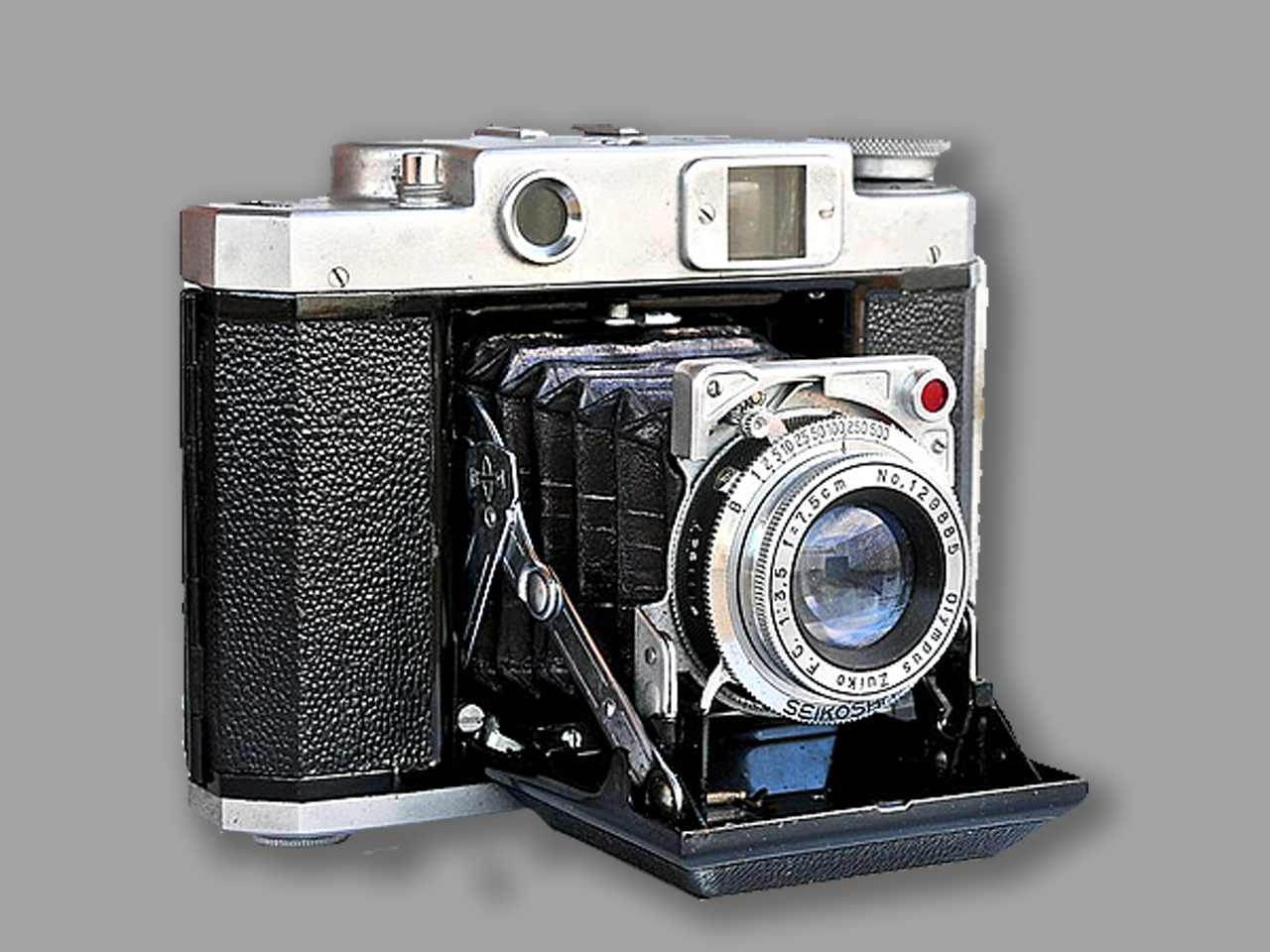
Mamiya’s first product was the medium-format 120 film folder Mamiya-6. A fascinating feature of this vintage folder is the way it focuses. The lens and bellows do not move while focusing – the film plane does! Well made and highly successful, it was the predecessor of Mamiya’s first 35mm camera, the Mamiya 35-I, which debuted in 1949.
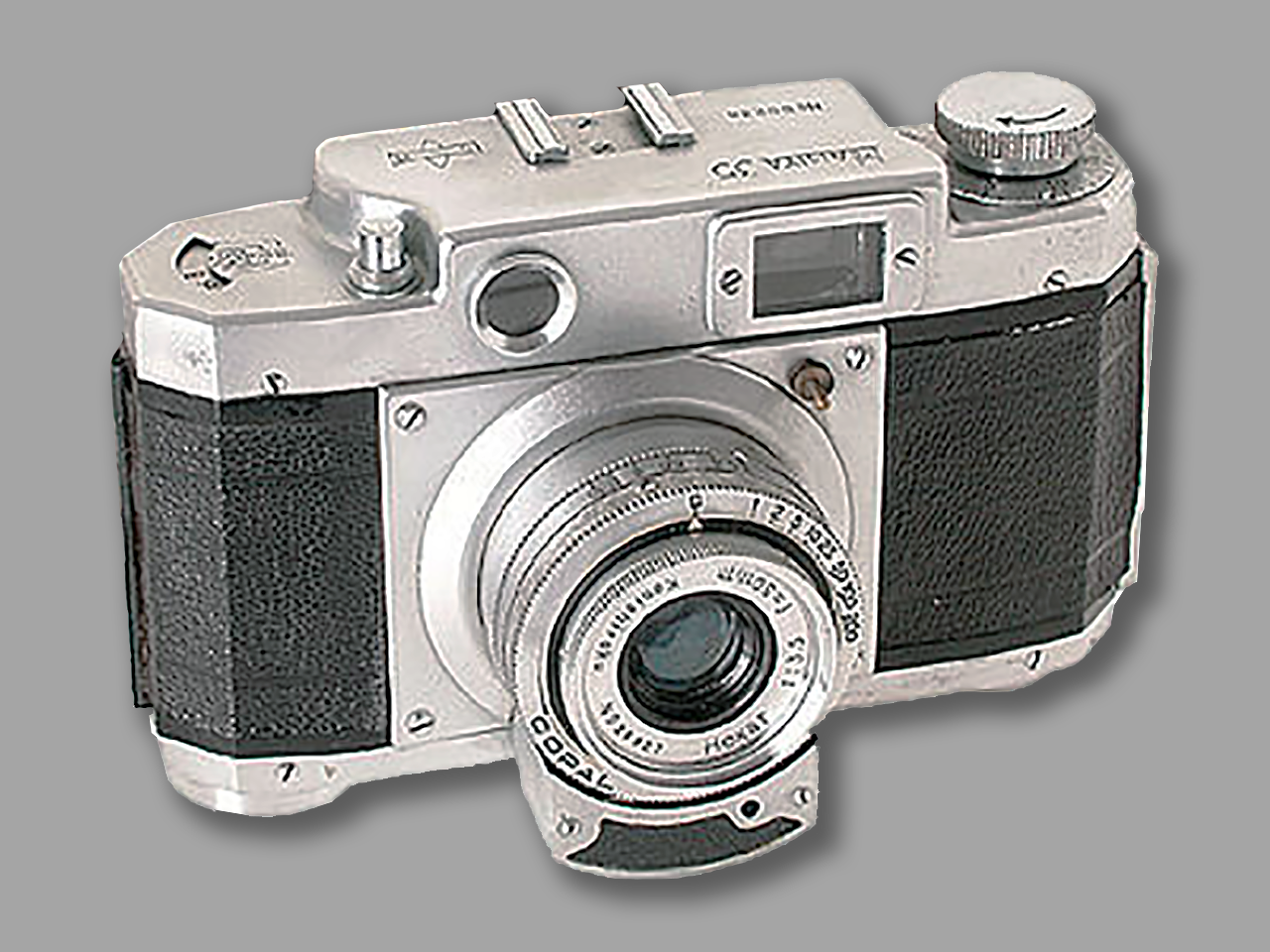
The Mamiya 35-I was the first Japanese camera to automatically cock a leaf shutter as the film was wound, and it had a fixed 5cm f/3.5 Hexar lens in a Copal B shutter, with speeds from 1 to 1/200. It adopted the unique backfocusing arrangement of the Mamiya-6, in which the lens did not move during focusing. However, problems developed in keeping the film flat in a 35mm format, and the 35-I was eventually abandoned.
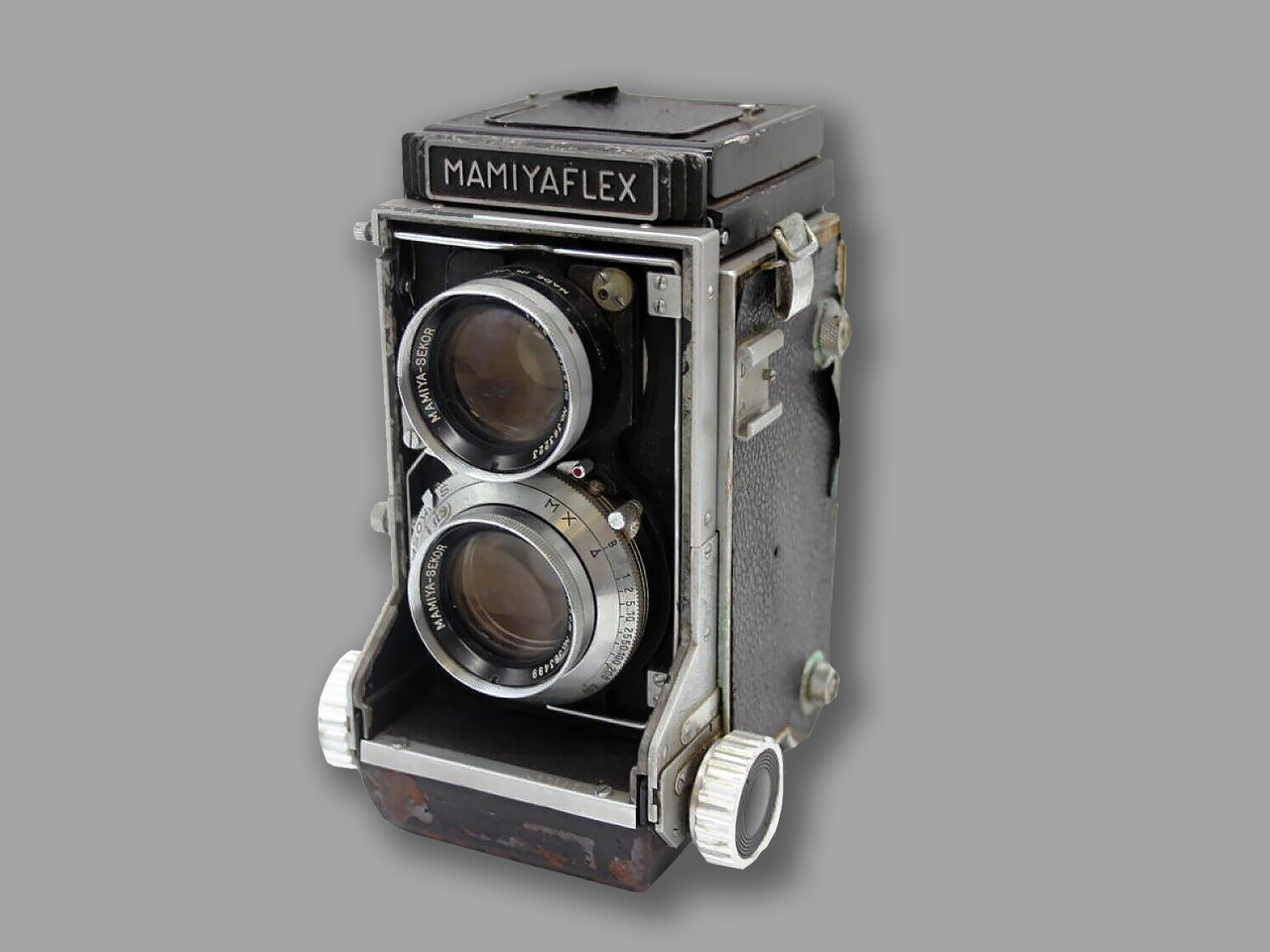
The Mamiya C series was the third series of TLR cameras made by the company. In the early 1950’s A and B series TLR cameras were also based on fixed lens designs. This was followed by the C series which began in 1956 starting with the Mamiyaflex C. One notable distinction of the C series is the fact that they can use interchangeable lenses.
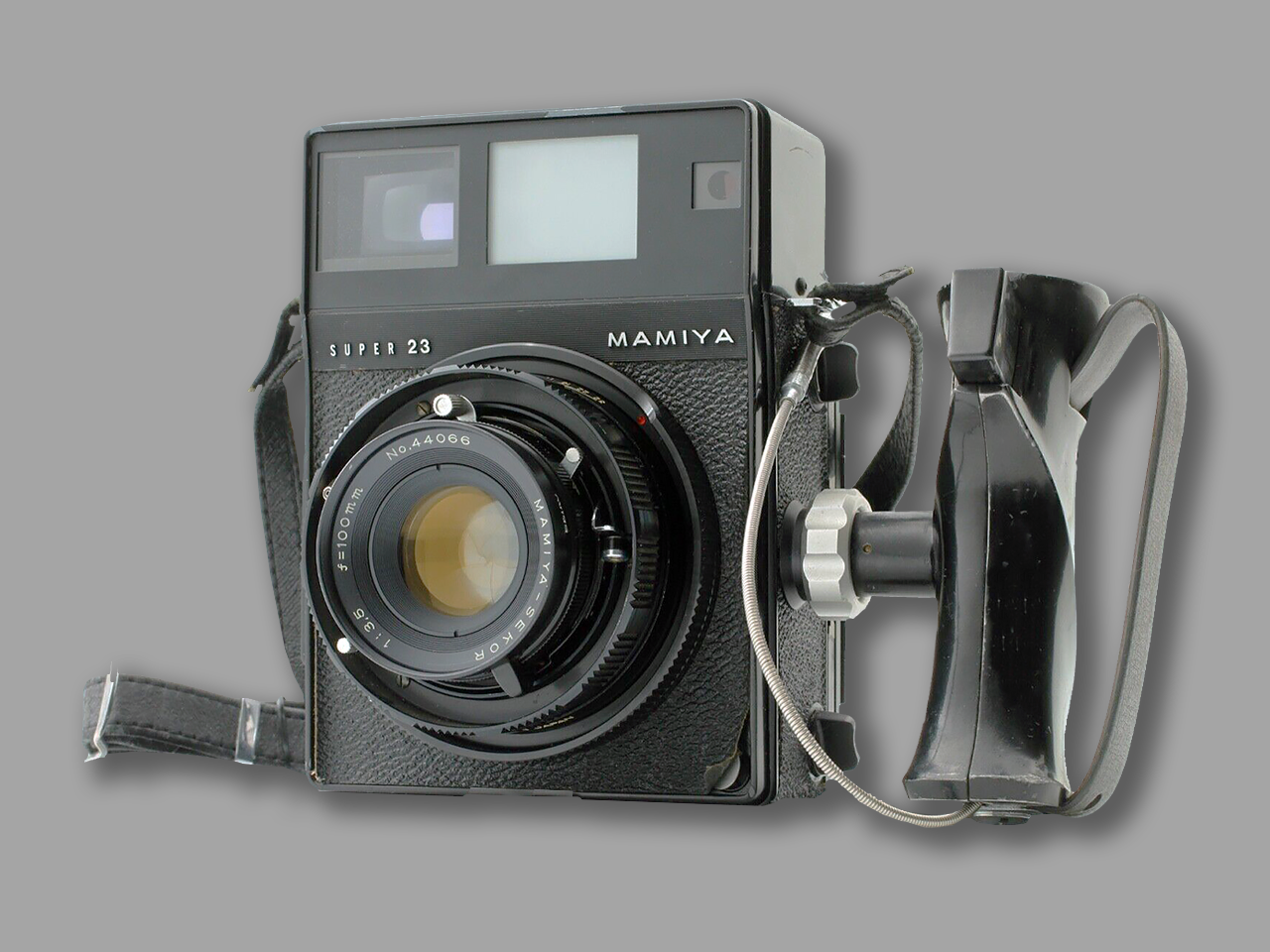
The Mamiya Press is a line of medium-format rangefinder system press cameras manufactured by Mamiya. The first model was introduced in 1960, and the final model was discontinued in the 1970s. It was targeted at the professional press photography market, and a wide array of accessories was offered. Introduced in August 1967, the Super 23 was the first major revision in the series.
16mm format
- Mamiya 16 Automatic
- Mamiya 16 (1949)
- Mamiya Super 16 (1953)
- Mamiya Super 16 II (1957)
- Mamiya Super 16 III (Tower 16) (1958)
- Mamiya 16 Automatic (Revue 16 Automatic) (1959)
- Mamiya 16 Deluxe (1961)
- Mamiya 16 EE Deluxe (1962)
126 format
- (Argus 260 Automatic) (1964)
- (Keystone K1020) (1966) — fixed-lens single lens reflex
35 mm Rangefinder format
- Mamiya 35 I (1949)
- Mamiya 35 II (1955)
- Mamiya 35 III (1957)
- Mamiya Magazine 35 (1957)
- Mamiya Wide (1957)
- Mamiya Elca (1958)
- Mamiya Crown (1958)
- Mamiya Metra (1958)
- Mamiya S (1958)
- Mamiya Wide E (1959)
- Mamiya Auto Metra (1959)
- Mamiya Metra 2 (1959)
- Mamiya Auto Metra 2 (1959)
- Mamiya Sketch (1959) — square image format (24mm × 24mm)
- Mamiya S2 (1959)
- Mamiya Ruby (1959)
- Mamiya Auto Deluxe (1960)
- Mamiya Ruby Standard (1961)
- Mamiya M3 (1961)
- Mamiya EE Super Merit (Mamiya Vulcan, Honeywell Electric Eye 35R, Mansfield Eye-Tronic R) (1962)
- Mamiya 4B (Rank Mamiya) (1963)
- Mamiya Super Deluxe (1964)
- Mamiya Myrapid (1965) — half-frame
- Mamiya 135 (1977)
35mm Fixed-lens SLR
- Mamiya Auto-Lux 35 (1961)
- Mamiya Prismat Family (1962)
- Mamiya Prismat 528TL (1967)
- Mamiya Prismat 528AL (1975)
35mm ZM Single lens reflex
- Mamiya/Sekor 500DTL
- Mamiya Prismflex (c. 1952) — prototype
- Mamiya Pentaflex (c. 1955) — prototype
- Mamiya Prismat (1960) — Exakta bayonet mount
- Mamiya Prismat NP (Sears 32A, Tower 32B, Sears 32B) (1961) — Exakta bayonet mount
- Mamiya Prismat PH (Tower 37, Tower 37A, PCA V-90) (1961) — Exakta bayonet mount
- Mamiya Prismat WP (1962) Argus Bayonet mount
- Mamiya Prismat WT (1962) Argus Bayonet mount
- (Nikkorex F, Ricoh Singlex, Nikkor J) (1962) — Nikon F-mount
- Mamiya Prismat CPH (1963) — Exakta bayonet mount
- Mamiya Prismat CWP (Mamiya Prismat CP) (1964) — Exakta bayonet mount
- Mamiya/Sekor 500TL (1966) — M42 lens mount
- Mamiya/Sekor 1000TL (1966) — M42 lens mount
- Mamiya/Sekor 500DTL (1968) — M42 lens mount
- Mamiya/Sekor 1000DTL (1968) — M42 lens mount
- Mamiya/Sekor 2000DTL (1969) — M42 lens mount
- Mamiya/Sekor AutoXTL (1972) — Mamiya XTL bayonet mount
- Mamiya X-1000 (1974) — Mamiya XTL bayonet mount
- Mamiya MSX 500 (1974) — M42 lens mount
- Mamiya MSX 1000 (1975) — M42 lens mount
- Mamiya DSX 500 (1975) — M42 lens mount
- Mamiya DSX 1000 B (1975) — M42 lens mount
- Mamiya NC-1000 (1978) — Mamiya NC bayonet mount
- Mamiya NC-1000s (1978) — Mamiya NC bayonet mount
- Mamiya ZE (1980) — Mamiya Z bayonet mount
- Mamiya ZE-2 (1980) — Mamiya Z bayonet mount
- Mamiya ZE-X (1981) — Mamiya Z bayonet mount
- Mamiya ZM (1982) — Mamiya Z bayonet mount
- Mamiya ZF (c. 1983) — prototype
35mm ViewfindeR
- Tower 41 (Mamiya Automatic 35 EEF)
- Mamiya Mammy (1953) — zone focus system
- Mamiya Speed Shot Special (a.k.a. Mamiya Pistol Camera) (c. 1954) — half-frame; rare police model; not sold to public
- Mamiya Automatic 35 EEF (Tower 39, Tower 41) (1961) — zone focus system
- Mamiya EE Merit (Honeywell Electric Eye) (1962) — zone focus system
- Mamiya 135 EF (1979) — zone focus system
- Mamiya 135 AF (1980) — auto-focus
- Mamiya U (1981) — zone focus system
- Mamiya 135 EF2 (1982) — zone focus system
- Mamiya M (1982) — auto-focus
- Mamiya U Auto Focus (1983) — auto-focus
- Mamiya M Time Memory (1983) — auto-focus
6×4.5cm format manual focus
- The M645 (discontinued) was manufactured from 1975 to 1987 — the first model and the launch of the Mamiya 645 system
- The M645 1000S (discontinued) was manufactured from 1976 to 1990 — added a 1/1000 second shutter speed, self-timer and a depth-of-field preview lever
- The M645J (discontinued) was manufactured from 1979 to 1982 — a stripped down version of the M645
- The Mamiya 645 Super (discontinued) was manufactured from 1985 to 1993 — a new camera design with removable film backs
- The Mamiya 645 Pro (discontinued) was manufactured from 1993 to 1998 — minor updates to the Mamiya 645 Super
- The Mamiya 645 Pro-TL (discontinued) was first released in 1997 — minor updates to the Mamiya 645 Pro
- The Mamiya 645E (discontinued) was first released in 2000 — entry-level model with a non-interchangeable back and finder
6×4.5cm format auto focus
- Mamiya 645AF (1999) — the first autofocus model
- Mamiya 645AFD (2001) — added communication interface for digital backs
- Mamiya 645AFD II (2005) — minor updates to the 645AFD
- Mamiya 645AFD III (Phase One 645AF) (2008) — minor updates to the 645AFD II
- Mamiya 645DF (Phase One 645DF) (2009) — digital-only (no film backs) supports Leaf shutter lenses, vertical grip and user firmware upgrades.
- Mamiya 645DF+ (Phase One 645DF+) (2012-current) — Faster auto focus compared to DF and automated live view handling with compatible digital backs.
6×4.5cm format ZD series
- Mamiya ZD (2004) — fixed-back medium-format DSLR
6×7cm format
- Mamiya RB67 Pro-SD
- Mamiya RB67 Professional (1970) — mechanical 6 cm × 7 cm SLR medium-format camera
- Mamiya RB67 Professional S (1974) — minor changes
- Mamiya RB67 Professional GL (1982) — special edition of the Pro-S
- Mamiya RB67 Professional SD (1990) — new, larger lens throat; older lenses require an adapter
- Mamiya RZ67 Professional (1982) — electronic 6 cm × 7 cm SLR medium-format camera
- Mamiya RZ67 Professional II (1995) — upgraded electronics
- Mamiya RZ67 Professional IID (2004-2014) — added communication interface for digital backs
- Mamiya 7 (1995–1999) — electronic 6 cm × 7 cm rangefinder camera
- Mamiya 7 II (1999-2011) — added multi-exposure capability and other minor improvements
6×6cm format Twin-lens reflex
- Mamiyaflex Junior (1948)
- Mamiyaflex Automat A (1949)
- Mamiyaflex I (1951)
- Mamiyaflex II (1952)
- Mamiyaflex Automat B (1954)
- Mamiyaflex Automat A II (1955)
- Mamiyaflex Automat B II (1956)
- Mamiyaflex Automat A III (1956)
- Mamiyaflex C Professional (1956)
- Mamiyaflex PF (1957) police model
- Mamiyaflex C2 Professional (1958)
- Mamiya C3 Professional (1962)
- Mamiya C33 Professional (1965)
- Mamiya C22 Professional (1966)
- Mamiya C220 Professional (1968)
- Mamiya C330 Professional (1969)
- Mamiya C330f Professional (1975)
- Mamiya C220f Professional (1982)
- Mamiya C330s Professional (1983)
6×6cm format Rangefinder
- Mamiya Six I (1940)
- Mamiya Six I A (1941)
- Mamiya Six III (1942)
- Mamiya Six II (1943)
- Mamiya Six II A (1943)
- Mamiya-6 IV (1947)
- Mamiya-6 V (1953)
- Mamiya-6 K (1954)
- Mamiya-6 IV B (1955)
- Mamiya-6 Automat (1955)
- Mamiya-6 K II (1956)
- Mamiya-6 IV S (1957)
- Mamiya-6 P (1957)
- Mamiya-6 Automat 2 (1958)
- Mamiya 6 (1989) — electronic 6 cm × 6 rangefinder camera
- Mamiya 6 MF (1993) — added multi-format back feature
6×9cm format UNIVERSAL
- Mamiya Press (1960)
- Mamiya Press G (1963)
- Mamiya Press S (1964)
- Mamiya Press Standard (1965)
- Mamiya Press Super 23 (1967)
- Mamiya Universal Press (1969)
- (Polaroid 600/600SE) — similar to the Mamiya Universal, but with different lens and back mounts (note: not part of the 600 series consumer line)
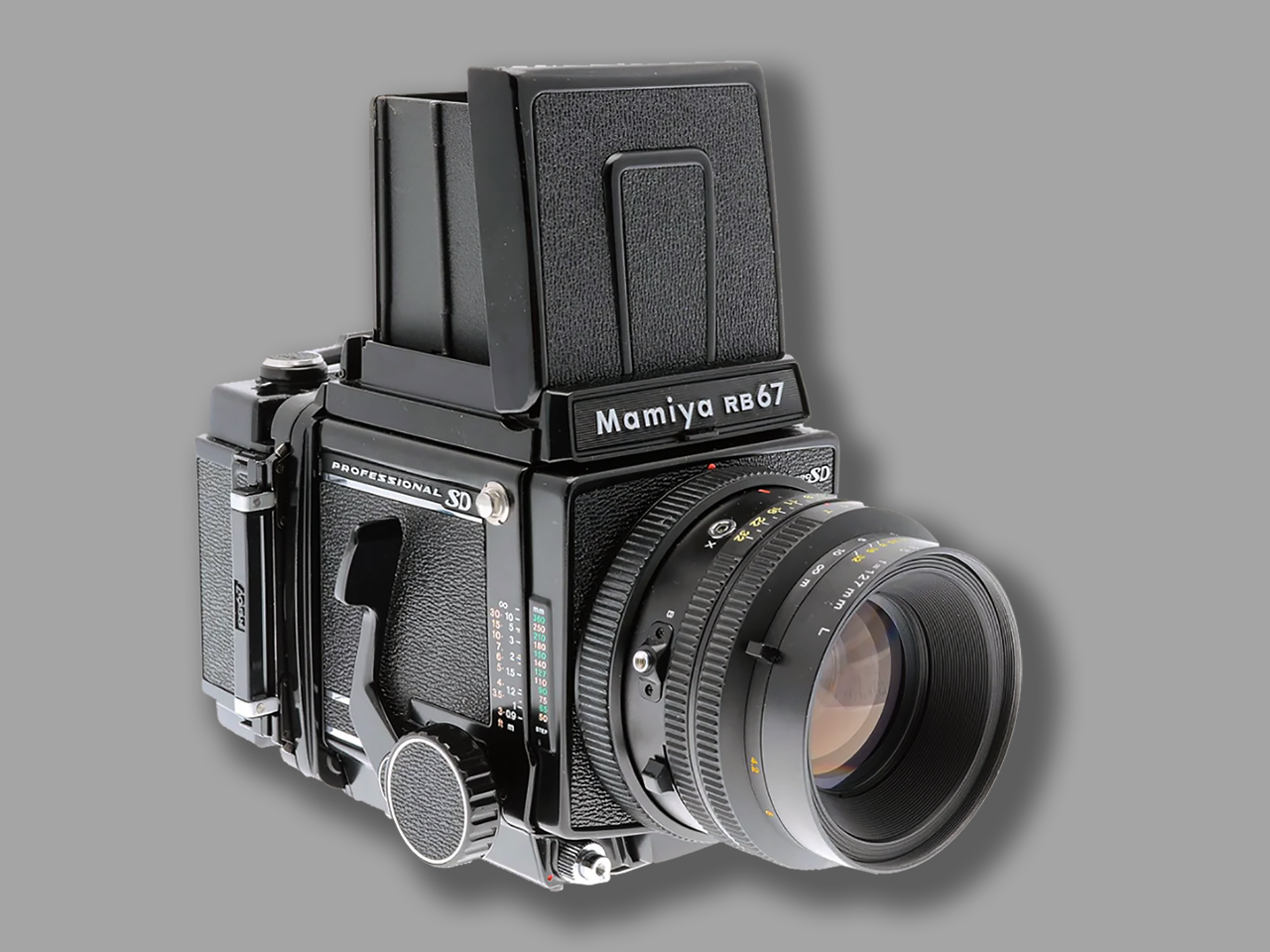
The RB67 was originally designed to supplement the Mamiya C series 6×6 TLR system and the multi-format Mamiya Press rangefinder camera system (6×4.5, 6×7, 6×9, others) but has surpassed them in popularity. Back adapters for using Mamiya Press roll film and instant film backs are also available. Due to its heavy weight (almost 2kg for the body alone) the RB67 is often said to be unsuitable for use hand-held use.
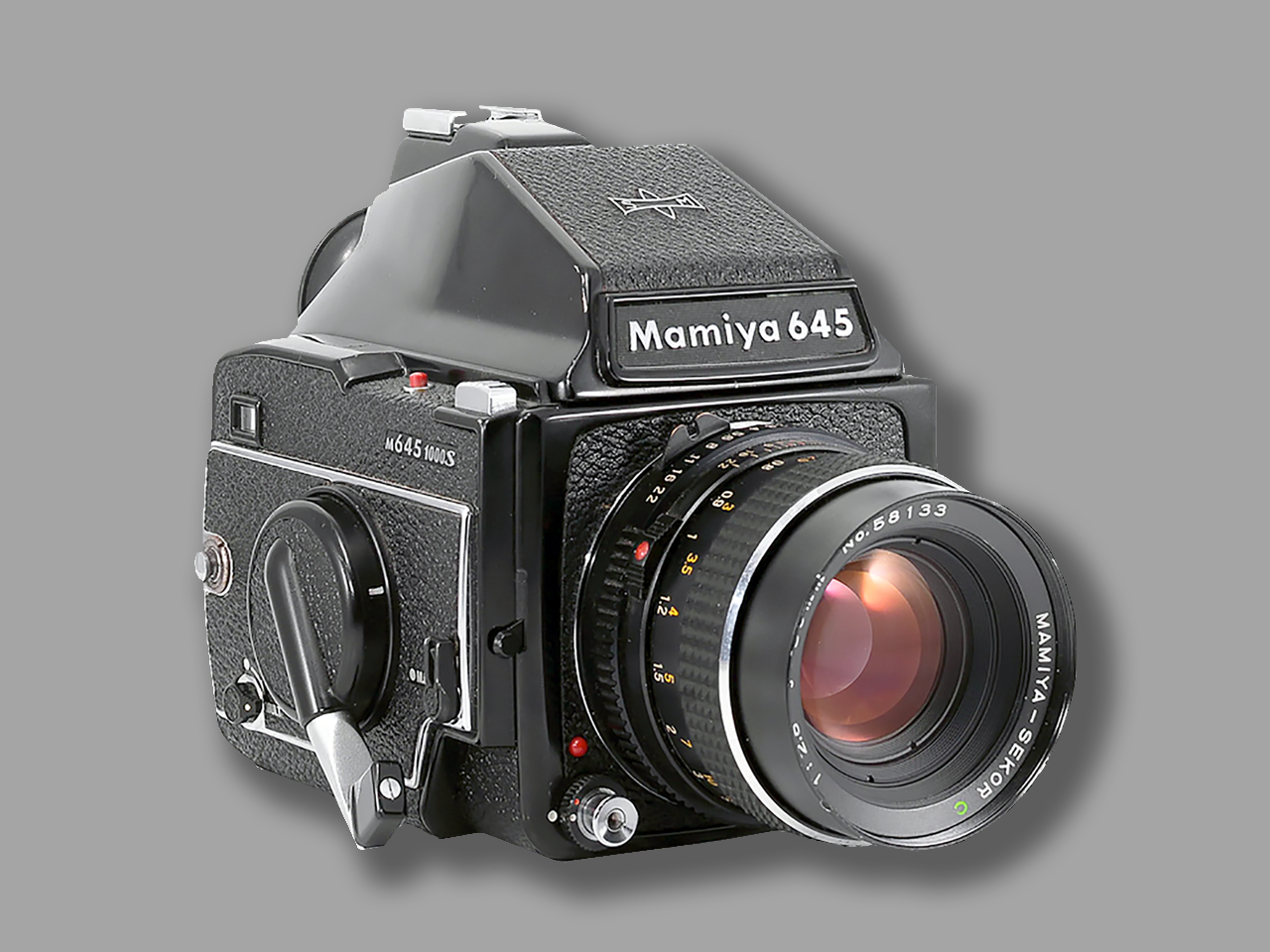
The Mamiya M645 is the first series of 4.5×6 SLRs. It has an electronic focal plane shutter. The finder and screens are interchangeable, but there is no magazine back, only pre-loadable film inserts. This made it easy to preload onto less expensive film magazines. Up to 15 frames can be captured onto a 120 roll film. All the M645 models share the same accessories (finders, screens, lenses, grips and inserts). The lenses and inserts (but not the viewfinders) can also be attached on later manual-focus cameras such as the M645 Super.
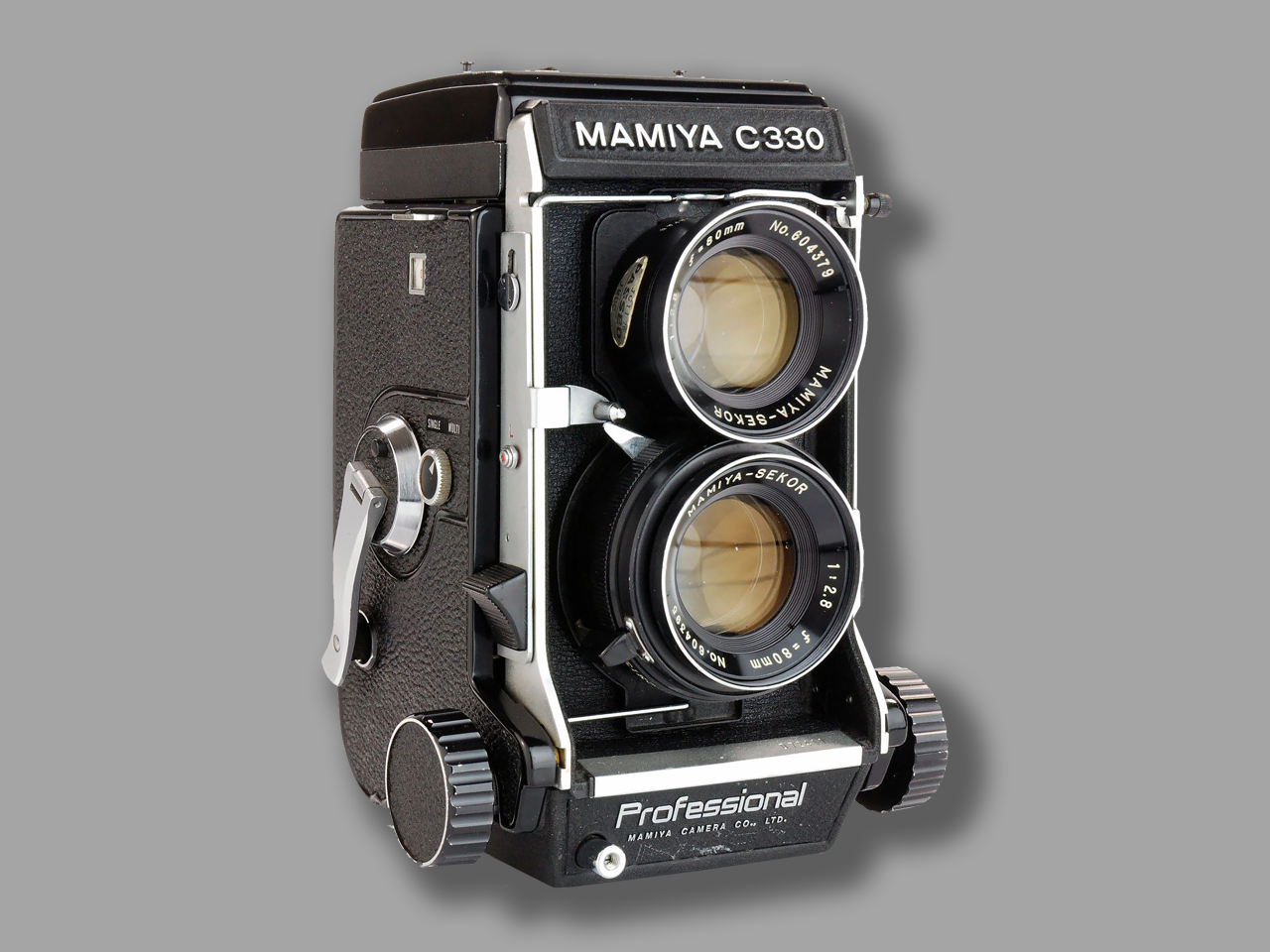
The C330 was released in 1969 as part of the Mamiya C series of interchangeable lens medium format TLR cameras. It is an improved version of the Mamiya C33.
Similar to other models in the series, it supports interchangeable finder viewing system allowing options such as a chimney style magnifier, eye level prism and the traditional waist level finder. A new feature of the C330 is interchangeable focusing screens. There are six additional types of screens available.
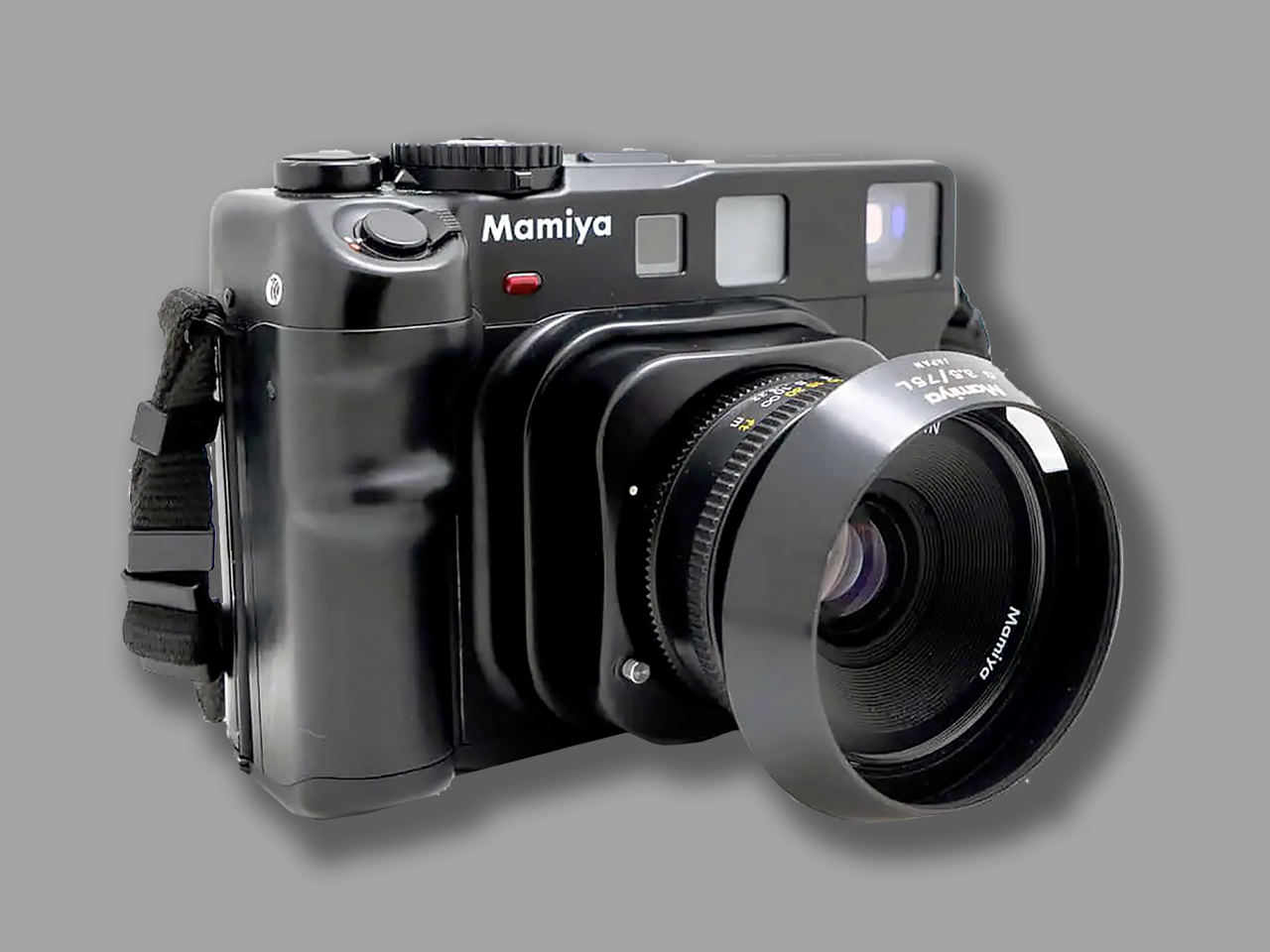
The Mamiya 6 system, introduced in May 1989, is a 6×6 cm rangefinder camera taking 120 and 220 film with three interchangeable lenses of 50mm, 75mm and 150mm. The Mamiya 6 does the same thing as a Hasselblad system with 50, 80 and 150 lenses, just that this Mamiya weighs much less, is much easier and faster to use and makes sharper images due to the silent and vibration free electronic leaf shutters and rangefinder-design lenses.
FOUNDER: Dipl.Ing. Alois Benes
MEOPTA
1933: Optikotechna Přerov; 1946: Meopta (Mechanická optická výroba – mechanical optical manufacturing); 1991: Meopta Přerov, s.p.; 2003: Meopta-Optika a.s.; 2006: Meopta-Optika, s.r.o..
COMPANY ADDRESS:
1933: Přerov.
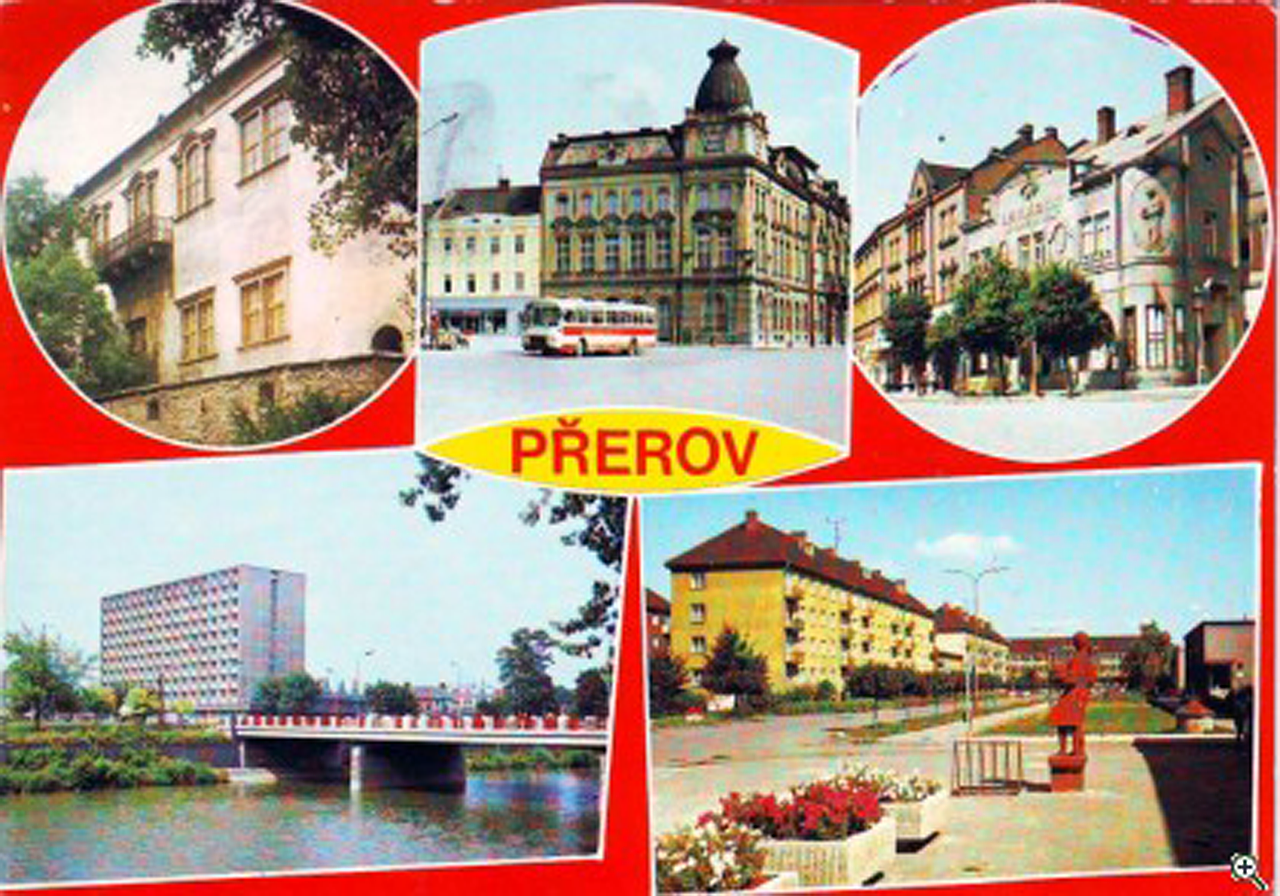
THE REAL START …
Meopta Přerov traces its roots back to the year 1933 when Optikotechna Company was established in Přerov. Initially, Optikotechna produced lenses and condensers but quickly expanded its product line to include enlargers, composite lenses, single optics, binoculars, riflescopes, slide projectors and of course the well known Flexaret range of cameras. After 1935, Meopta Optikotechna became a subsidiary of Zbrojovka Brno and a major supplier of military optics for the Czechoslovak Army.
By 1936, Optikotechna established new facilities to accommodate the rapid expansion of its operation necessary to meet the growing demand for its products. Optikotechna enjoyed a thriving consumer goods business until German forces seized the company in 1939.
Optikotechna was then forced to immediately cease consumer goods production in order to supply military optical equipment for the German army. From 1939 until the end of the war, the company produced nothing but military optical equipment that included rangefinders, periscopes, binoculars and riflescopes.
beforehand …
 It was the year 1849 when, in Wetzlar, Germany, Carl Kellner, a young mechanic and self-taught mathematician, founded his “Optisches Institut” (Optical Institute), where he produced glasses and telescopes.
It was the year 1849 when, in Wetzlar, Germany, Carl Kellner, a young mechanic and self-taught mathematician, founded his “Optisches Institut” (Optical Institute), where he produced glasses and telescopes.
Shortly thereafter, in 1851, Kellner published an optics treatise titled “Das orthoskopische ocular, eine neu erfundene achromatische Linsencombination” (Ocular orthoscopy, a recently invented combination of achromatic lenses). The ocular was capable of rendering an image with the correct perspective, free of the distortions typical of other microscopes at that time.
His invention was a success among scientists, and the Optical Institute began the production of microscopes that stand out for their quality and precision.
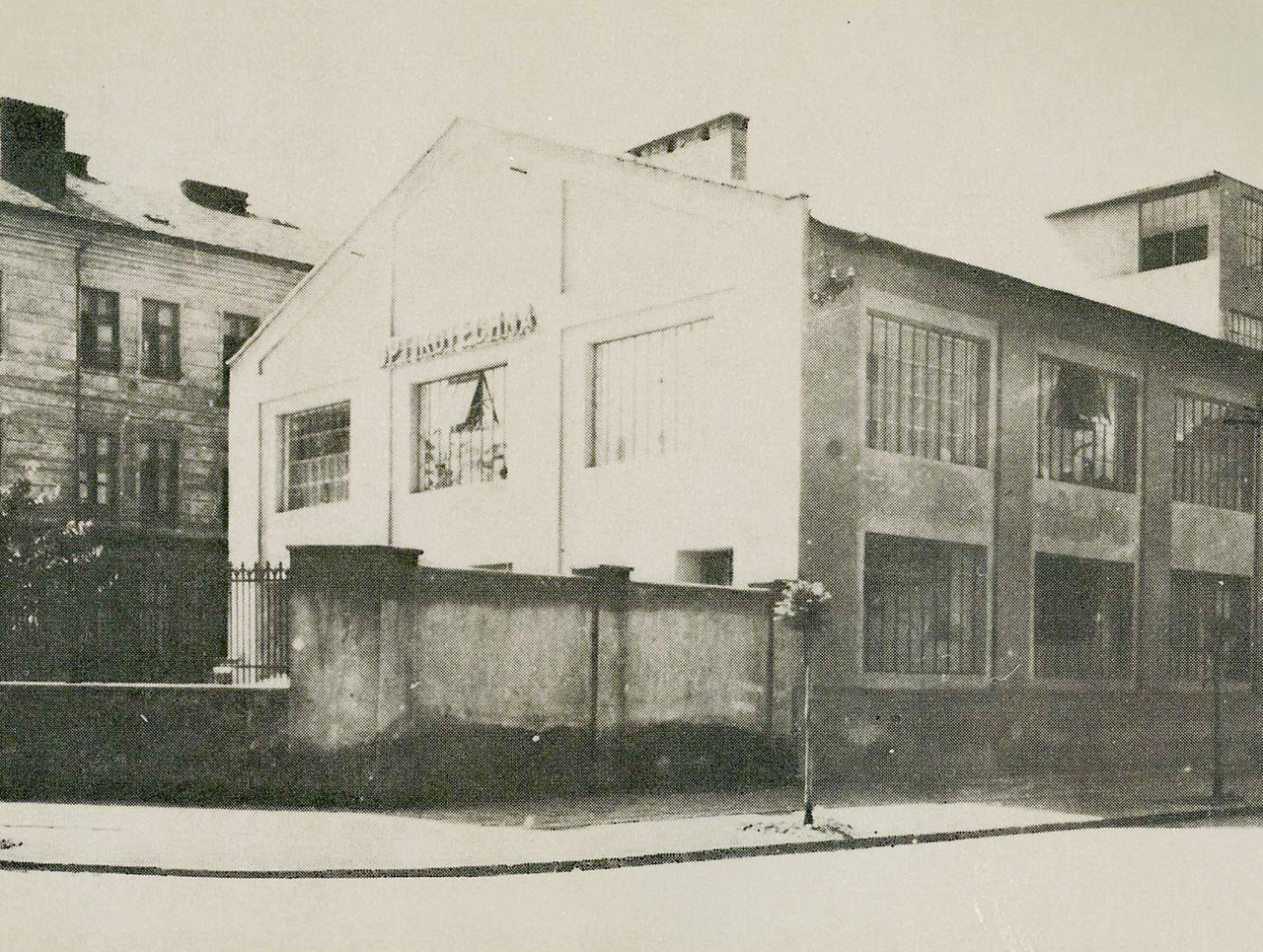
The Optikotechna Přerov factory in 1933.
AFTER WORLDWAR II …
After the war, the remaining company was renamed Meopta (an acronym for Mechanická optická výroba – mechanical optical manufacturing) and established new facilities to accommodate the rapid expansion of its operation. A number of new and exciting products were designed and developed which helped to establish quickly an excellent reputation for the new Meopta brand in world markets. Apart from military products, the company became one of the world’s major manufacturers of cinema projectors between 1947 and 1970.
However, in 1971 production was again refocused primarily on military products and continued this way until it was abruptly ended after the dissolution of Warsaw pact in 1989. At which time the sale of military products, which represented about 75% of Meopta´s business, was reduced to zero and forced the company to refocus mainly on civilian applications.
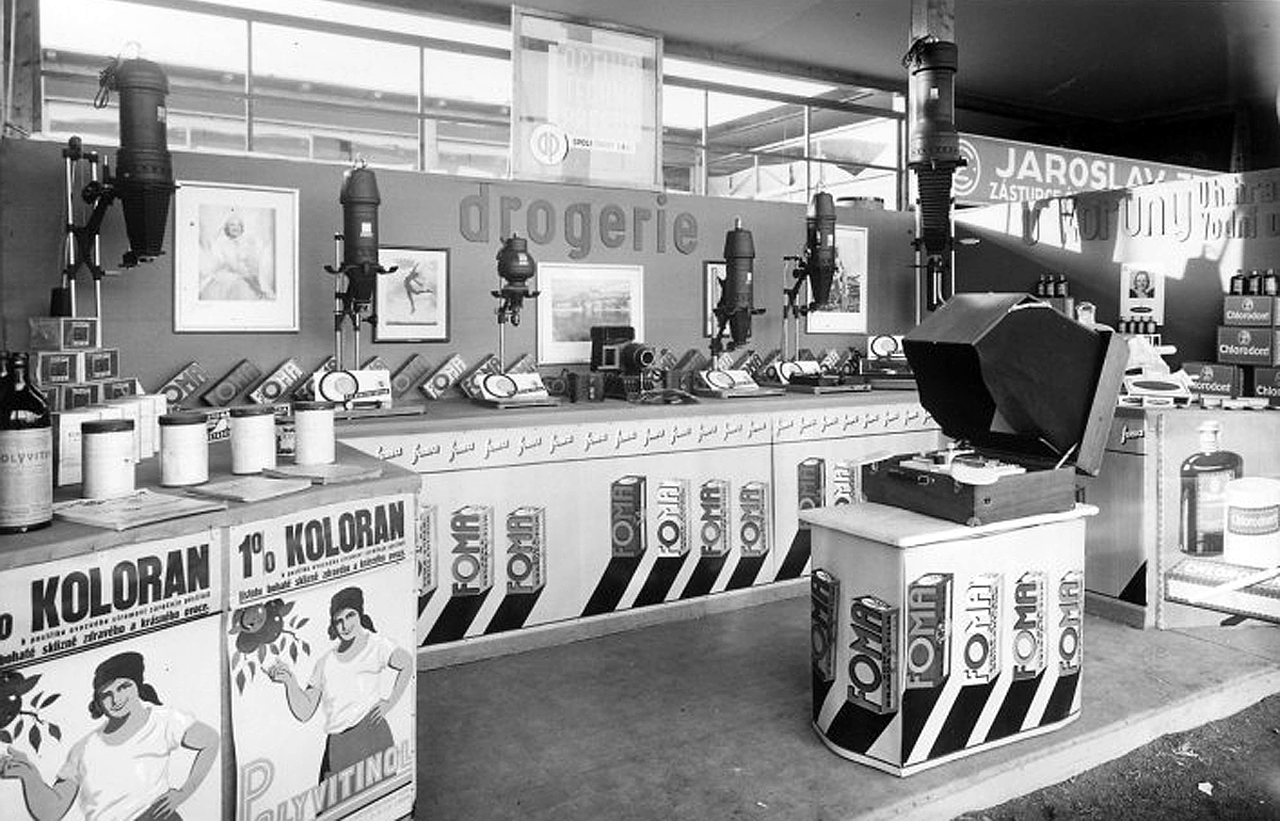
The Meopta showroom
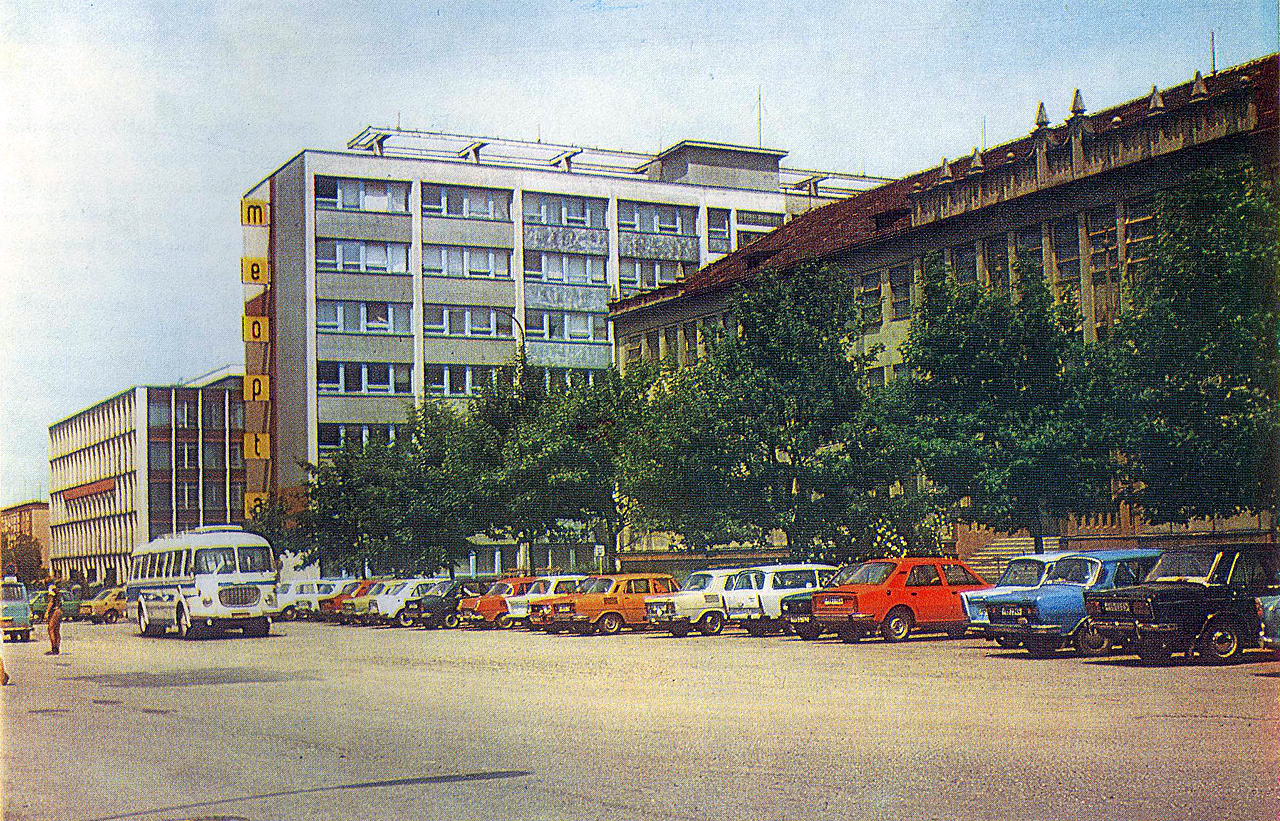
The Meopta Company building after the war.
Becoming a private company
In 1991, Meopta completed its first step toward privatization when it was established as a joint stock company. The company was formed by a single act in accordance with the founding plan of the state enterprise Meopta Prerov, s.p. On March 21, 1991, Meopta was registered in the companies register at the District Court in Ostrava.
Meopta then occupied a 135 000 m2 site. This is built up areas yield 77 000 m2 on floor space, including 26,000 m2 of manufacturing area which include state-of-the-art, high quality, air-conditioned, dust free environments.
Next, the company was privatized in 1992. Its majority owners are a Czech family, consisting of three brothers and their parents. The three brothers had been active soldiers of the 1st Czechoslovak Army Corps and were decorated for their war duty. Together with their parents they immigrated to the United States in 1946 to flee from the rising power of communists in the Soviet Union liberated and dominated Czechoslovakia.
Meopta U.S.A.
Meopta U.S.A., Inc. is a separate company that was founded by the same Czech-American family in New York in 1960 under the name Tyrolit Company, Inc. At that time, its main business was selling grinding wheels in US and Canada. Tyrolit gradually changed its focus to manufacturing various optical products and was renamed to Meopta U.S.A., Inc. in 2005
The Meopta team (2400 employees) of today is poised to utilize its extensive experience in research, design, development and production to provide superior service on many different levels from raw concept to finished goods.
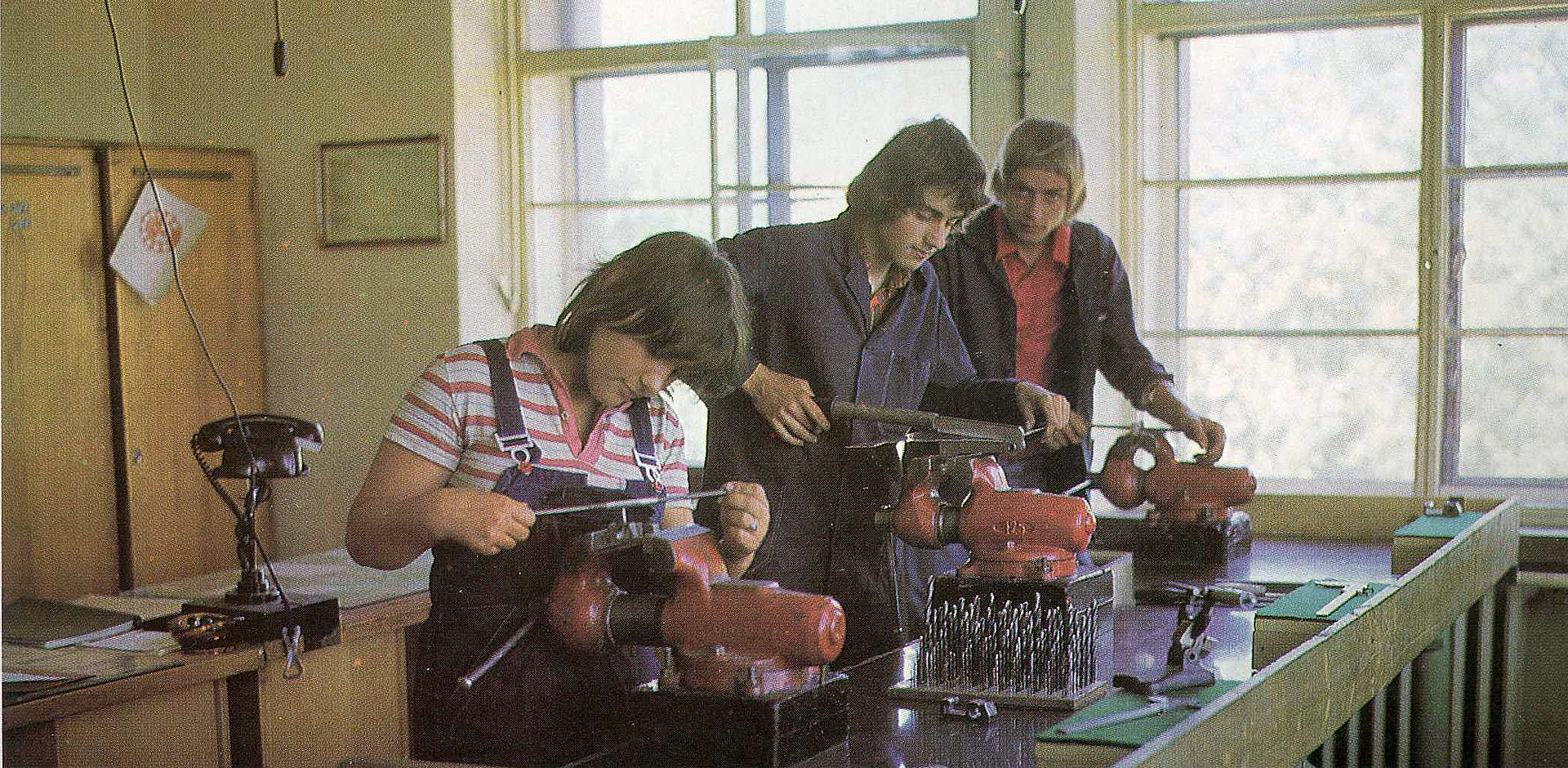
Production workers in Meopta’s construction department.
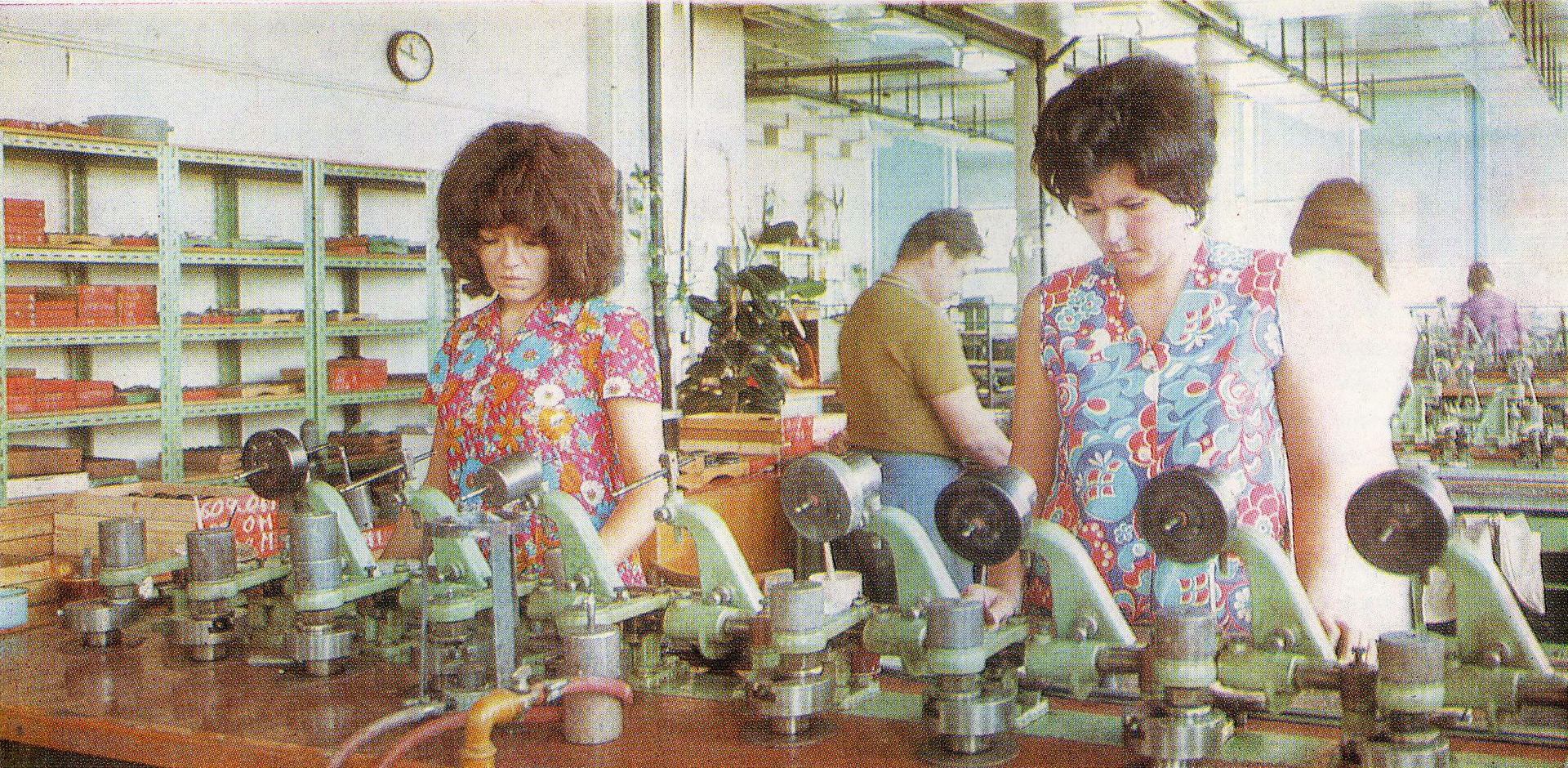
At Meopta not only photographic products were made.
product diversification
Today, military equipment constitutes about 10% of company’s production, with 20% of its turnover being generated mainly by optics for sports and hunting applications.
70% Being generated by production of optics for cinema and other projectors, optical tools for microprocessors manufacturing quality control, as well as optics for healthcare which are used in various applications such as RTG or mammography.
In 2003 the Meopta companies merged to one organization and business organisation again. This resuted in 2006 to the amendment in legal form of the company from Meopta-Optika a.s. to Meopta-Optika, s.r.o.
The company provided a.o. following products:
120 film TLR
- Kamarad I (Bradac Brothers)
- Kamarad II (Bradac Brothers)
- Autoflex (Bradac brothers, later Optikotechna)
- Optiflex (Luxurious model, Optikotechna, later Meopta)
- Flexette (Bradac brothers, later Optikotechna)
- Flexaret I (Bradac brothers, later Optikotechna)
- Flexaret II (3 types exist, type 2 with frame counter is very rare, Optikotechna, later Meopta)
- Flexaret IIa (made as cheaper alternative to III)
- Flexaret III
- Flexaret IIIa (same as the III but with a Flash Synchro Shutter)
- Flexaret IV
- Flexaret IVa (can take 35mm insert)
- Flexaret V
- Flexaret Va (extra winding knob added to rewind 35mm film)
- Flexaret VI (early version in black skin, later version in grey skin)
- Flexaret Standard (most commonly in black skin but also exists in grey skin)
- Flexaret VII (grey skin only, can also use 6×4.5 or 24×24 masks and has double exposure option)
- Flexaret VIIa (silver distance scale, no double exposure button)
Large format
- Magnola (13x18cm)
- DFP
TLR Prototypes
- Flexaret Astro (based on VI, factory focused to infinity, only B time shutter)
- Flexaret Reporter (for fast shooting)
- Flexaret 12-24 (1970s prototype)
- Flexaret VII (fast advance like Reporter model, possibility to use Praktisix pentaprism)
- Flexaret Vb (bayonet filter mount, dark green skin)
- Flexaret V with exposure meter (with rolleiflex style side focussing)
- Flexaret II for oscillograph (also 3×5 format and counter window for 24 frames)
- Flexaret IV ŠKOLNÍ PŘÍSTROJ (for schools)
- Stereo Flexaret (used by J. Hanzelka)
- Flexarex (interchangeable lenses, 70mm film)
120 film Folding
- Milona
120 film Panoramic
- Pankopta
32×45 film
- Meta
35mm Cameras
Interchangeable lens
- Opema I/II
- Optina
35mm Cameras
Fixed lens
- Spektaretta (as Optikotechna)
- Optineta
- Etareta
- Opema 95
- Axoma 96
- Cola (Formerly V. Kolar)
Stereo Cameras
- Stereo 35
16mm Subminiature
- Mikronette (as Optikotechna)
- Mikroma
- Mikroma II
1.5mm subminiature
- Milox
16mm Stereo
- Stereo-Mikroma
- Stereo-Mikroma II
ENLARGERS
- Agrand 10×12,5
- Agrand 9×12
- Axomat Ia
- Axomat II
- Axomat 3
- Axomat 4 & 4a
- Axomat 5 & 5a
- Colombo
- Ideal
- Laborant
- Magnitarus 13 x 18
- Magnitarus 10 x 15
- Magnifax II
- Magnifax 3 & 3a
- Magnifax 4
- Meogrand
- Multifax
- Mignoret
- Mikromax
- Opemus 4 x 4
- Opemus 6 x 6
- Opemus IIa
- Opemus III
- Opemus 4
- Opemus 5
- Opemus 6 & 6a
- Opemus 7
- Opemus Standard
- Opemus Standard 2
- Proximus
- Proximus 2
MEOPTA FACTORY Pictures
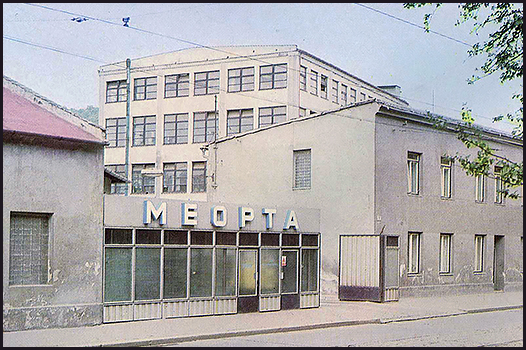
Meopta factory after WWII
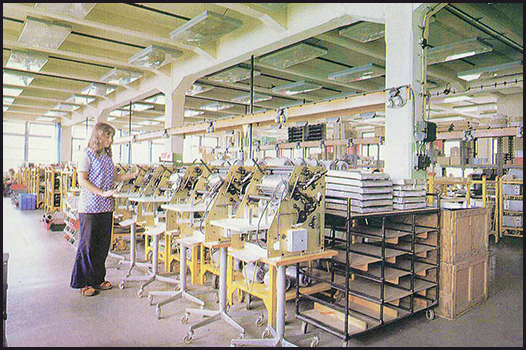
Production workers in Meopta’s departments.
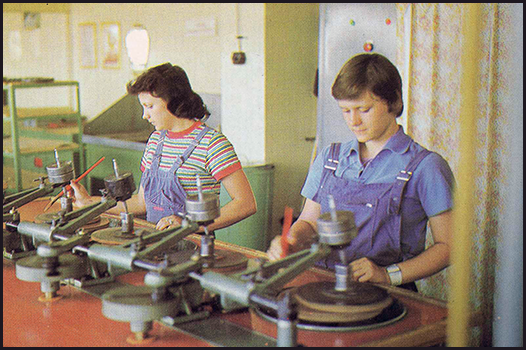
Production workers in Meopta’s departments.
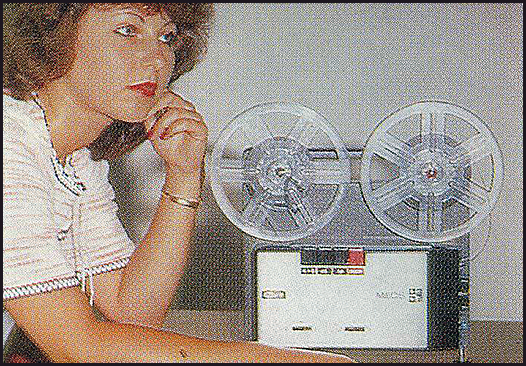
This website is not actually concerned with it, but we still place a picture of a projector here as a tribute to the Meopta company.

FOUNDER: Heinrich Stolle
COMPANY NAMES:
1893: Rheinische Emulsions-Papierfabrik Heinrich Stolle; 1902 merged with Dr. Opitz & Co., Munich; 1913: Mimosa AG, Dresden; 1949: VEB Mimosa Dresden; 1957: VEB Fotopapierwerke Dresden; 1990: the company was privatized after the German reunification; unfortunately the company was liquidated in 1991.
1948: Mimosa AG – From Hamburg to Hannover and from there to Kiel; the actual state of that company is unknown.
1947: CAWO Photochemisches Werk GmbH
COMPANY ADDRESSES:
1893: Cologne; 1904: Hepkestraße, Ecke Bärensteinerstraße, Dresden; 1910: Eibenstocker Straße 86; 86a, Gruna (Dresden); 1943: An der Mimosa 2, Dresden; 1947: CAWO Photochemisches Werk GmbH – Steingriffer Straße 2-6, Schrobenhausen.
Until World War II, the Mimosa Company was a well -known manufacturer of photographic materials, for example of films, but especially photo paper. In 1939 alone, 8 million m² were produced. After the short “camera phase” (1948 – 1952), Mimosa mainly made photo papers from 1957 as “VEB Photopapierwerk Dresden”. Restructured, the work existed until 1990. In 1991 the end was there: after 1 year of privatization the liquidation took place.

The blooming Mimosa Pudica
In late 1945 the Russian occupying forces fired both managers (who had left Dresden in May 1945). The Soviet government of East Germany allowed Mimosa to restart photo paper production with Mr. von Dobschinsky again in the lead and, once the company became state owned, with von Dobschinsky as custodian.
In 1949 the company became “VEB Mimosa Dresden”. However, between 1948 and 1957, the factory at Dresden was run by the East-German industries but did not produce papers, only cameras and equipment. In 1957 the firm at Dresden was re-named VEB Fotopapierwerke Dresden and produced also papers again, but not with the trade sign Mimosa.
Between 1946 and 1950 Mimosa produced the shutters Velax and Corona mainly for its own camera production. That part of the factory was taken over by Zeiss Ikon in 1950. In 1947 the company was directed to make cameras. This became a successful project, lead by Robert Graichen.
The “Mimosa” (1948) and later the “Mimosa II” (1949) were very compact full-featured 35mm viewfinder cameras. The original version of 1948 of this compact, yet boxy 35mm viewfinder camera had a fold-up viewfinder on top of the camera; but the Mimosa II introduced in 1949 incorporated the finder into the camera body. The Mimosa II continued to be built by VEB Zeiss Ikon until 1951.
In 1893 a photo paper factory was founded in Cologne, Germany. After several financial failures the “Rheinische Emulsions-Papierfabrik Heinrich Stolle” bought this company.
 A blooming mimosa twig was the company’s symbol. In 1902 the company merged with Dr. Opitz & Co., Munich, becoming a stock market company. In 1904 it moved to Dresden, there successfully making photo paper and dry plates. In 1913 the company was renamed to “Mimosa AG, Dresden”.
A blooming mimosa twig was the company’s symbol. In 1902 the company merged with Dr. Opitz & Co., Munich, becoming a stock market company. In 1904 it moved to Dresden, there successfully making photo paper and dry plates. In 1913 the company was renamed to “Mimosa AG, Dresden”.
Before and after WWI Mimosa bought several other companies. From 1905 to 1930 its production of photo paper rose from 25,000 square metres to 7,310,000 square metres. The company also made other film products.
In the era of the Nazi “3rd Reich“ the company’s Jewish employees, including most of the directors, were forced to leave; the owners of the company then appointed Dr. Weidner and Mr. von der Osten new directors. During WWII more than half of the production was changed to war relevant material, and the factory director von Dobschinsky was sent to a concentration camp.
Even though during the Destruction of Dresden the factory had not been bombed severely, Dr. Weidner and Mr. von der Osten, in fear of the incoming Russian soldiers, had already moved assets of the company to the western part of Germany trying to re-establish the company’s base in Hamburg.
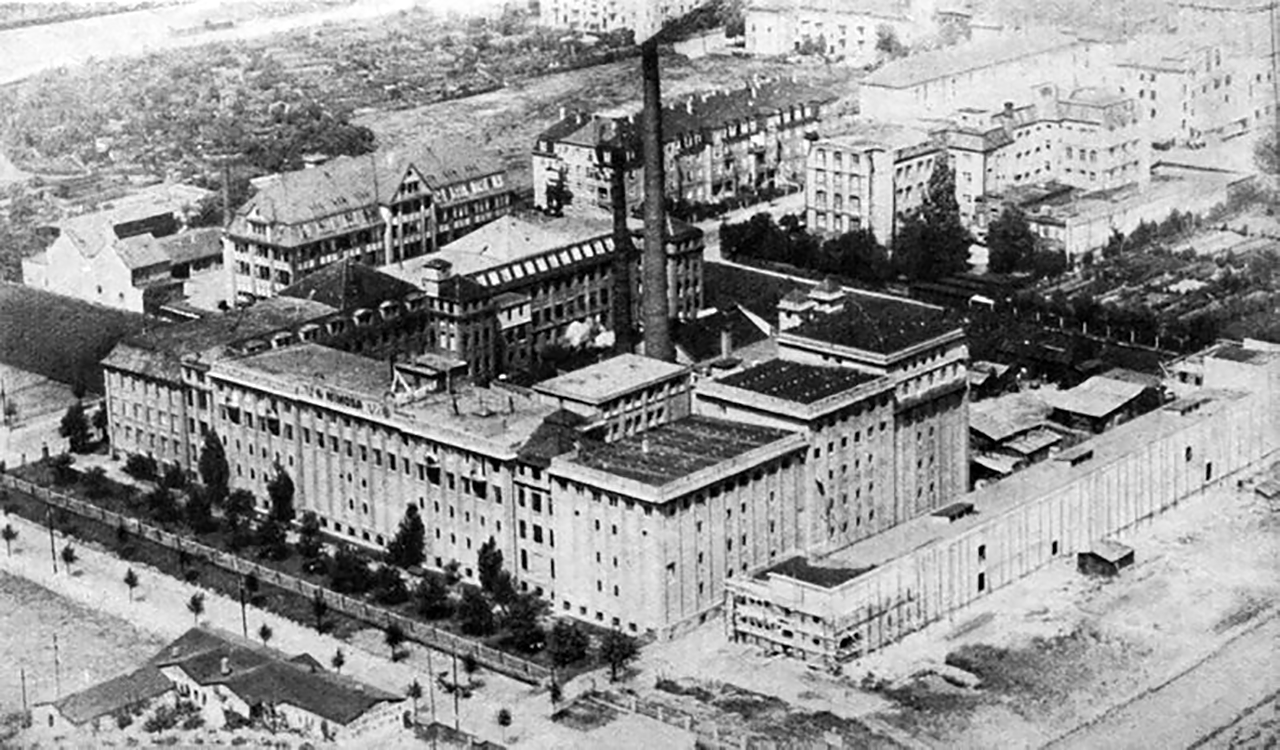
The stately building ensemble of the Mimosa factory in an aerial photo from the first half of the 1950s.
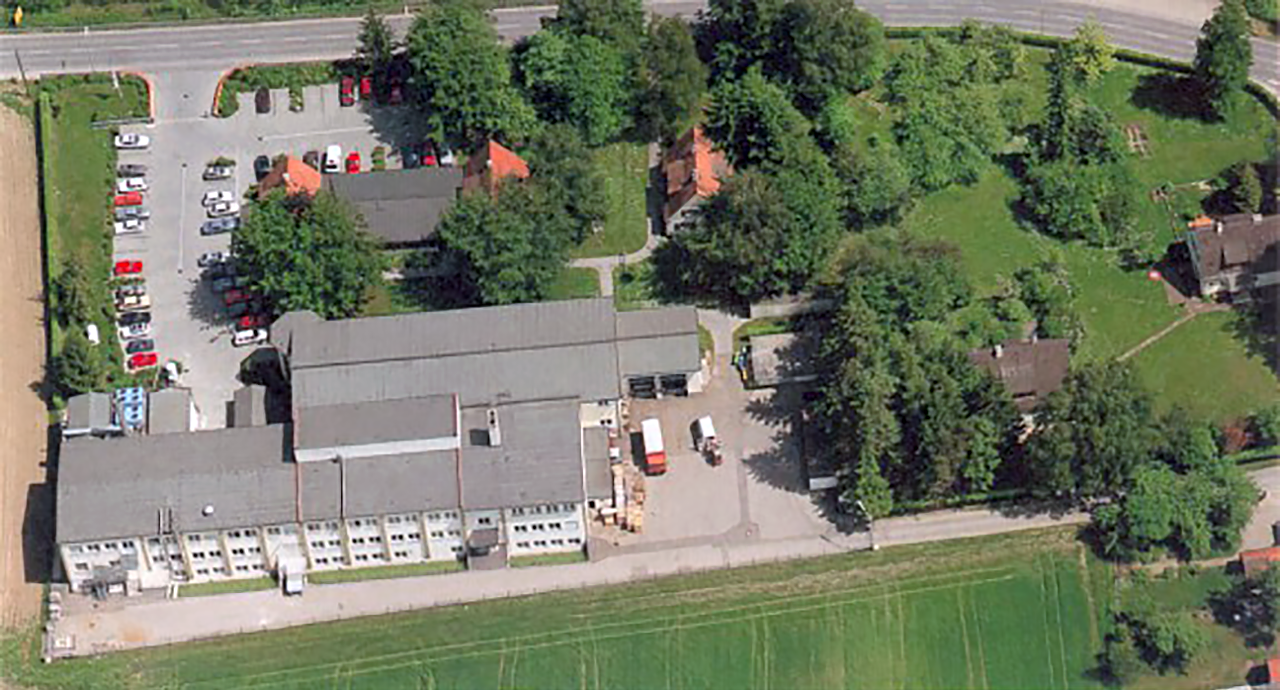
CAWO Photochemisches Werk GmbH in an aerial photo.
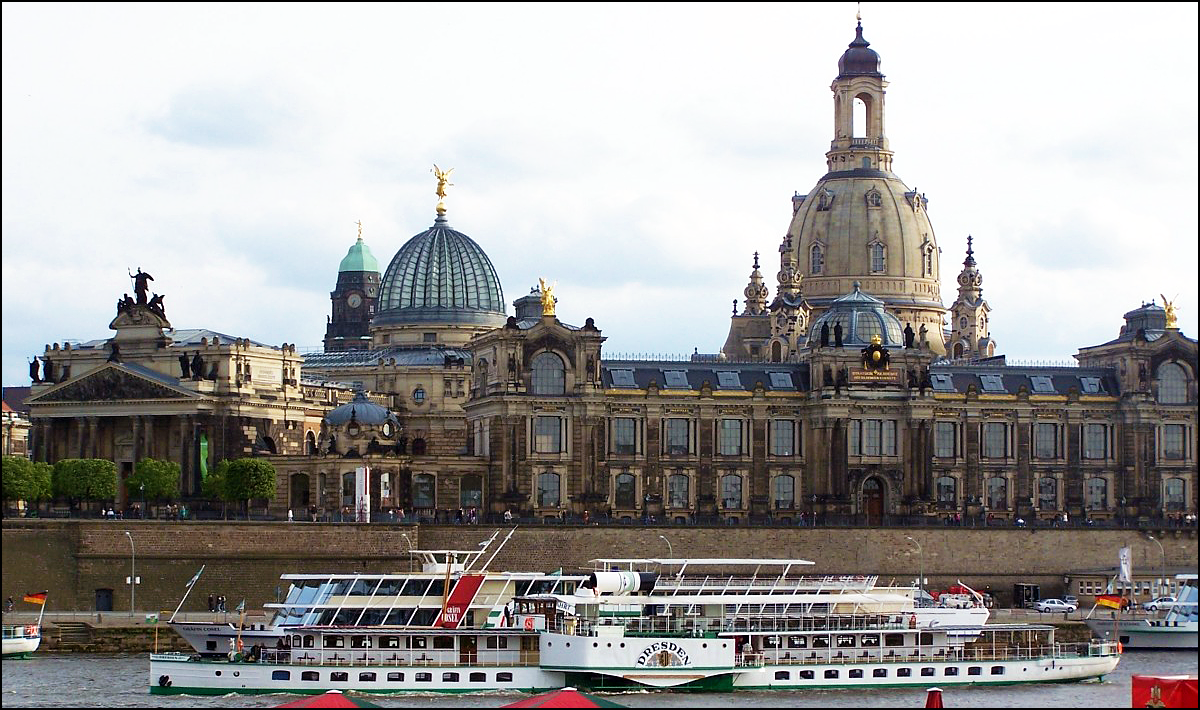
Well known in the nineteenth century as a manufacturing centre for albumin and collodion papers, in the twentieth century Dresden was primarily recognized for its optics and photographic camera equipment. The companies Mimosa AG, Vereinigte Fabriken Photographischer Papiere AG, and Zeiss Ikon were all headquartered in Dresden, a hub of art and music and a gateway to Russia, Czechoslovakia, and Poland.
Accessible by one of the first modern railways (the Dresden-Leipzig corridor, established around 1849), the city also had direct lines to Berlin and Nuremberg and other terminal tracks coming in from the West. The clean water needed for the manufacturing process was available in ample supply, as were the chicken egg whites needed to make albumin paper.
The availability of this ingredient, a by-product of the many pasta factories in and around Dresden in the mid-nineteenth century, was likely a decisive factor in the choice of the city as a location for photochemical companies, which went on to produce photographic paper of all kinds and of excellent quality. Their success attracted many other firms to Dresden.
From 1954 to 1990 the company continued solely with the production of photo paper, the other product lines being taken over by Zeiss Ikon. After the German reunification in 1989, the company was privatized in 1990. Unfortunately the company was liquidated in 1991.
Meanwhile after WWII, a new photo paper and film factory “Mimosa AG” was launched in 1948 in West Germany. It moved from Hamburg to Hannover and from there to Kiel. Several lawsuits were fought with the East German “VEB Mimosa”. The actual state of that company is unknown.
Dr. Weidner and Mr. von der Osten meanwhile founded a new company “CAWO Photochemisches Werk GmbH” in 1947 with employees from the former Mimosa producing first photo papers and film then switching over to the field of medical x-ray. CAWO nowadays has a name with worldwide recognition in radiography.
- Dry plates
- Photographic papers
- Celluloid films
- 35mm compact cameras
Mimosa I, II (1949) & II (1951)
- Velax & Corona Shutters
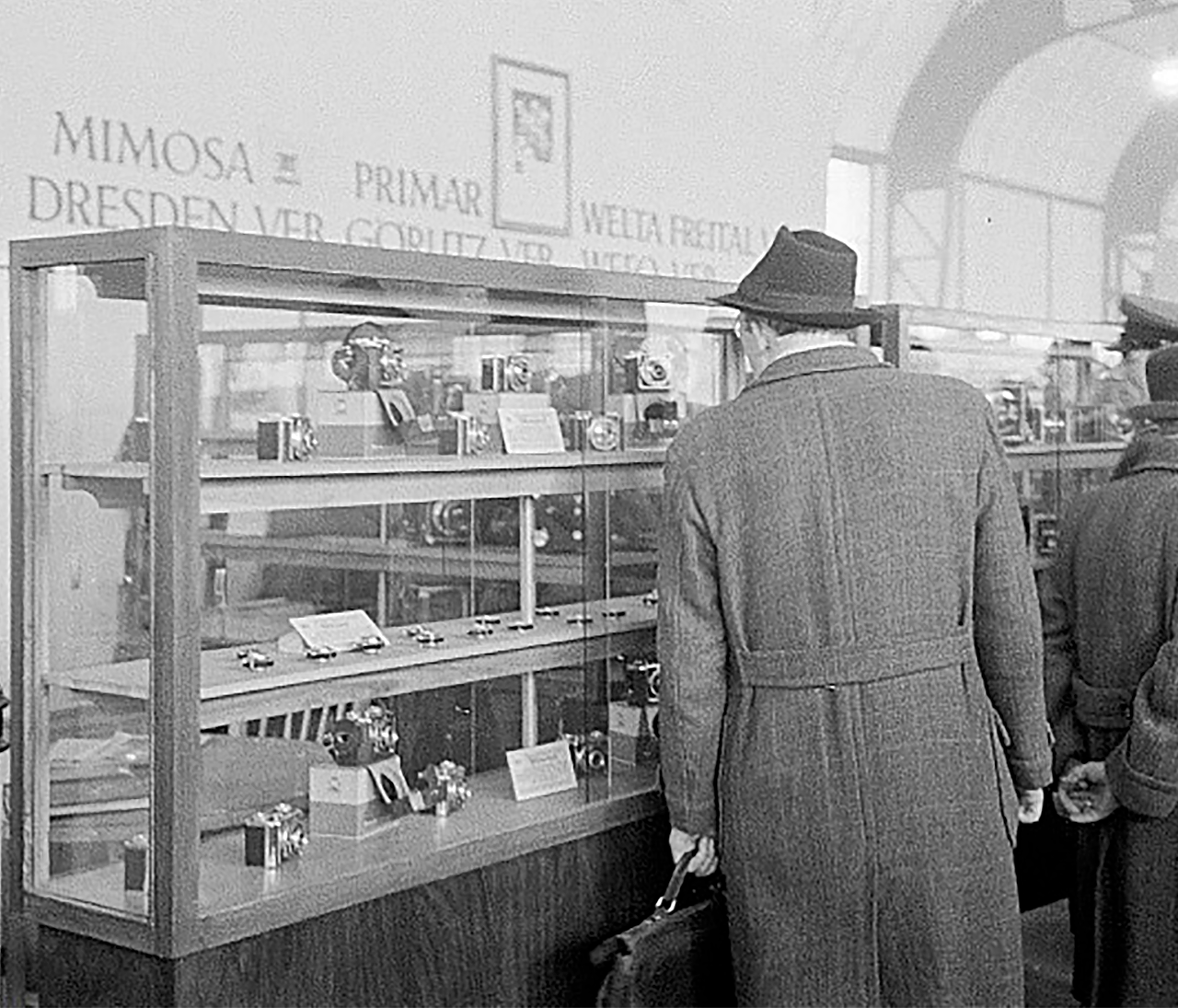
Visitors in front of showcases at the booth of VEB Mimosa Dresden
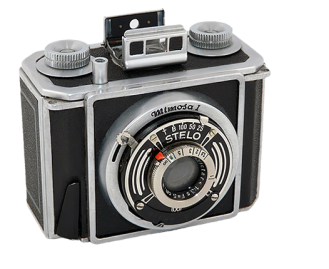
- 5 cm 1:2.9 Meyer Trioplan, Ludwig Meritar or Victar lens
- Scale focus using lens front element
- Compur-Rapid, Prontor II, or Stelo shutter
- black back-release lever
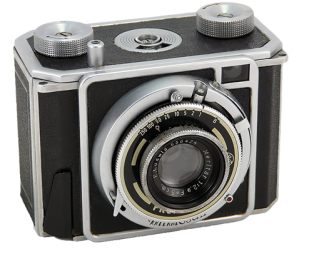
- 5 cm 1:2.9 Meyer Trioplan, Ludwig Meritar lens
- Scale focus using lens front element
- Mimosa Velax or Prontor-S shutter
- black back-release lever
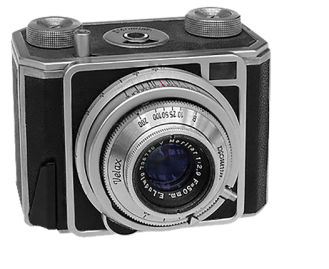
- Helical focus mount
- 5 cm 1:2.9 Meyer Trioplan, Ludwig Meritar lens
- Mimosa Velax or Prontor-S shutter
- black or silver back-release lever
Under the responsibility of Robert Graichen, the 35mm camera Mimosa I was created in 1948, followed by the Mimosa II in 1949. The Mimosa cameras (especially the Mimosa I) belonged to the rare Dresden cameras, not least because of their short construction time and small numbers.
The Mimosa I, built in only small numbers (about at most 2,500 to 3,000 cameras) included a.o. the following versions:
- • with Stelo lock and Ludwig Meritar lens 2.9/5 cm
- • with Vario lock and Meyer Trioplan 2.9/50
- • with Gauthier Prontor II bolt or Compur Rapid bolt with Meritar or Trioplan 2.9/50, preferably for export
On the picture is an early Mimosa I equipped with a simple “Stelo” automatic shutter made by Tharandt.
Because of the cuboid shape of the case, the Mimosa was also called “the briquette”. The die-cast aluminum body is very small, so at first you wouldn’t think it’s a 24x36mm camera.
The outer dimensions of the housing (without the lens) are only 95 mm wide x 65 mm high x 55 mm deep.
While the Mimosa I still had a folding viewfinder, the Mimosa II was equipped with a telescopic viewfinder. Interestingly, the Mimosa II was built in the same production facilities as the Mimosa I, but later as a Zeiss-Ikon camera until around 1951/52.
The Mimosa cameras were proof that it was possible to “build around the film cartridges” an extremely small camera. In terms of body width, it was undoubtedly one of the smallest 24x36mm cameras at the time.”
There were several different versions of the Mimosa II produced (about 20,000 pieces) from 1949-1951/52, some in very small series:
- • with and without strap carrying loops
- • with snail gear focusing
- • with lens focusing
- • with Stelo lock 1/25-1/100s
- • with Velax shutter 1/10s-1/200s
- • with Prontor-S shutter 1s-1/200s
- • with Erison Freital Anastigmat Erisar 2.9/5cm
- • with Meyer Trioplan lens 2.9/50mm
- • with Ludwig Meritar lens 2.9/50mm
- • with bare or black rear panel release lever or combinations thereof
FOUNDING DATE: 1928
FOUNDER: Kazuo Tashima
1928: Nichi-Doku Shashinki Shoten (Japan-Germany Camera Company); 1937: Chiyoda Kogaku Seiko Kabushiki Kaisha (Chiyoda Optics and Fine Engineering Limited); 1962: Minolta Camera Co., Ltd.; 1994: Minolta Co., Ltd.; 2000: Minolta forms a partnership with Konica Corporation; 2003: Konica Minolta Electronics Co., Ltd.; 2006: The merged company closed down its photo imaging division, which produced colour film, colour paper, photo chemicals and digital minilab machines.
COMPANY ADDRESSES:
1879: Nihonbashi district of Tokyo; 1902: Rokuosha Factory in Shinjuku, Tokyo.
Minolta manufactured cameras from 1929 to 2003. It produced cameras for many film formats, from 16mm film to medium format. Most branches of the company were related to optics: the copier branch, the exposure meter branch, etc. Minolta was succeeded by Konica Minolta after the merger with Konica in 2003.
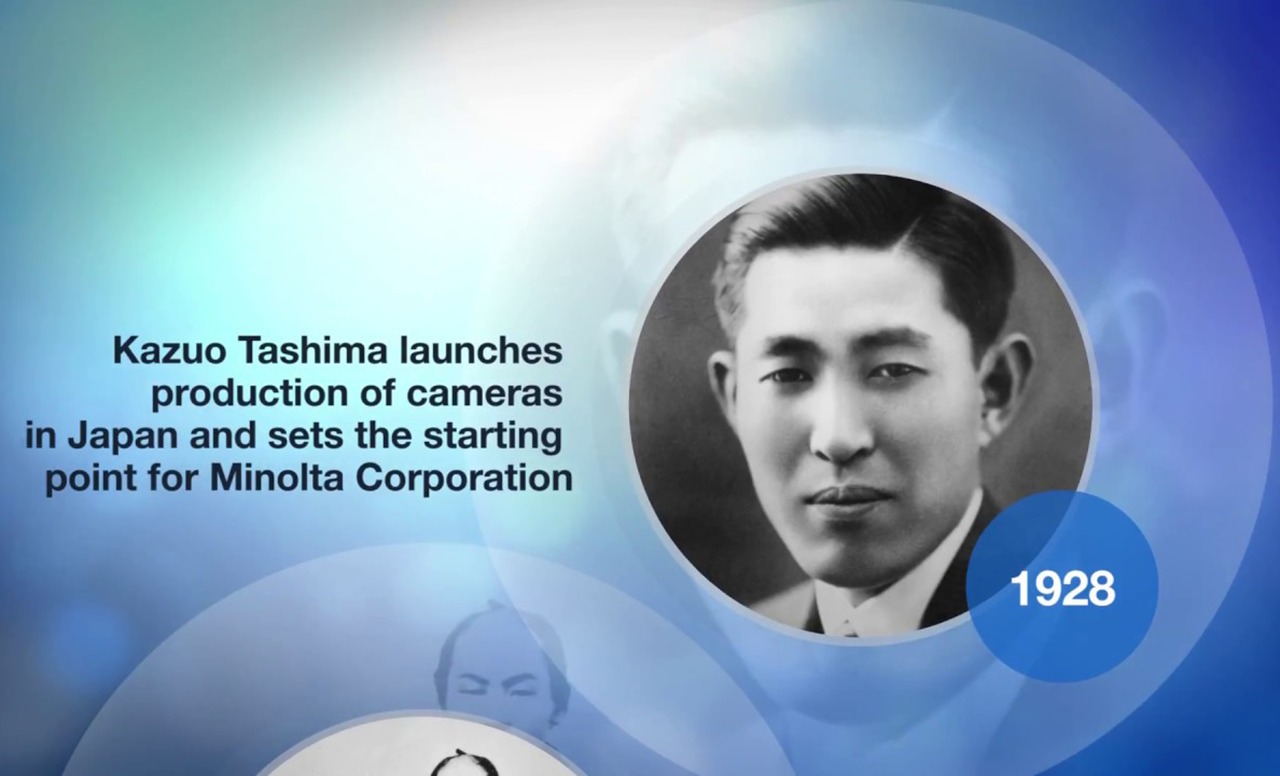
MINOLTA IN THE 30S
A new model introduced in 1933 first carried the Minolta brand name, which Tashima created. The name sounds like the Japanese word minoru-ta, which means ripening rice field. The term reminded Tashima of a proverb his mother frequently used, “The ripest ears of rice bow their heads lowest,” meaning that the more successful one becomes, the humbler one must be. The name, however, also has a Western meaning, as an acronym for Machinery and Instruments Optical by Tashima.
In 1934 the company began to sell the Minolta Vest, the product that made its reputation. Like other camera companies, Minolta used sheepskin to make a flexible camera bellows.
When a shortage of imported sheepskin threatened production, the company developed the first rigid bellows of synthetic resin for the Minolta Vest. The innovation made the Vest easier to focus and less expensive. For the first time, a Minolta product was successful outside of Japan.
The Vest’s success made expansion possible. Tashima built new production facilities, including a factory devoted to lens production at Sakai. His emphasis on innovation led to the development of the first twin-lens reflex camera in Japan, the Minolta Flex, in 1937.
That same year, Tashima reorganized and incorporated the company and renamed it Chiyoda Kogaku Seiko Kabushiki Kaisha (Chiyoda Optics and Fine Engineering Limited) to reflect its broader focus.
Minolta began modestly in 1928 when 28-year-old Kazuo Tashima agreed to represent his father’s import-export company, Tashima Shoten, on a government-backed trade mission to Paris to promote Japanese silk. In Paris Tashima toured a factory that specialized in high-grade optics, and decided he could produce similar equipment in Japan profitably.
Japanese businessmen, including Tashima’s father, opposed the idea of producing optical equipment domestically. Unable to start his new venture as a part of Tashima Shoten, Tashima borrowed money from his father’s chief clerk and went into business on his own.
Tashima opened shop on November 11, 1928, calling his venture Nichi-Doku Shashinki Shoten (Japan-Germany Camera Company). The name reflected the company’s reliance on German technology and expertise.
Partners Willy Heilemann, an importer of German items in Kobe, and Billy Neumann, a German engineer with a background in optical instruments, brought state-of-the-art German technology to the new firm. By March 1929 the staff of about 30 was producing each day one bellows camera, called the Nifcalette with imported lens and shutter. Within three months, production had grown to 100 cameras a month. A year later the Great Depression hit Japan hard, bringing labour strife and strikes. Nevertheless, Tashima promoted development of new camera models as the Depression intensified, and introduced several models in 1930 and 1931.
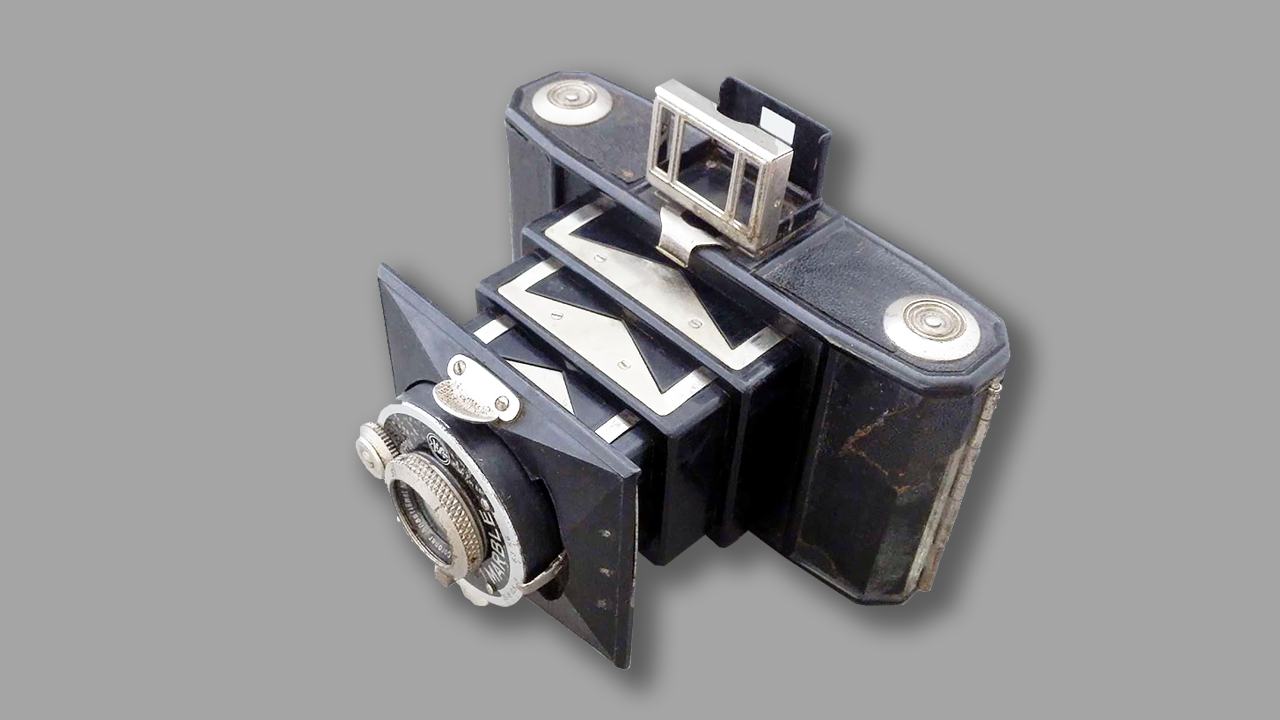
The Minolta Vest Camera.
Producing Binoculars and Other Optical Products During WorldWar II
In September 1940 Japan joined Germany and Italy in the Tripartite Pact, which divided Asia and Africa into spheres of influence. Japan’s was to be Southeast Asia. As it became clear that war was ahead, Japanese military planners determined to develop precision optical equipment for range finding, navigation, and bombing aids.
During World War II, when the U.S.military used electronics to track enemy ships and aircraft, the Japanese chose optics. Chiyoda Kogaku Seiko produced high-powered binoculars and other optical instruments with wartime uses. Demand was so high that it opened the Itami plant in 1942 solely to manufacture optical glass.
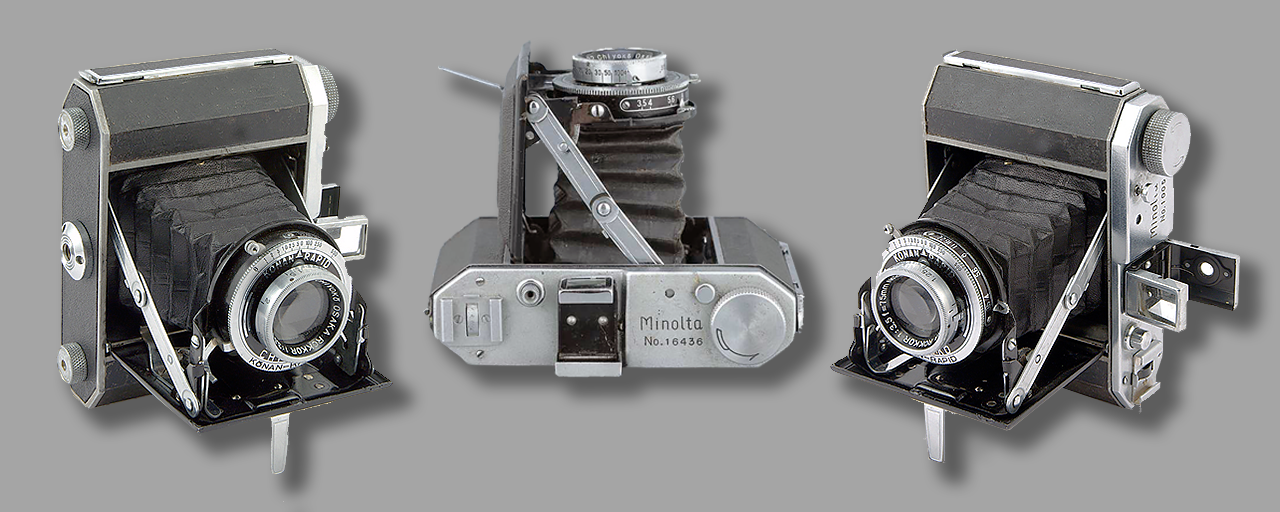
Left view, top view and right view of the Semi Minolta IIIa. The Semi Minolta III 4.5×6 folding camera was the first camera sold by Chiyoda Kōgaku after the war, and was an evolution of the Semi Minolta II. Its body is similar to the late Semi Minolta II but it has a more modern finish with auto-stop film advance and an exposure counter.
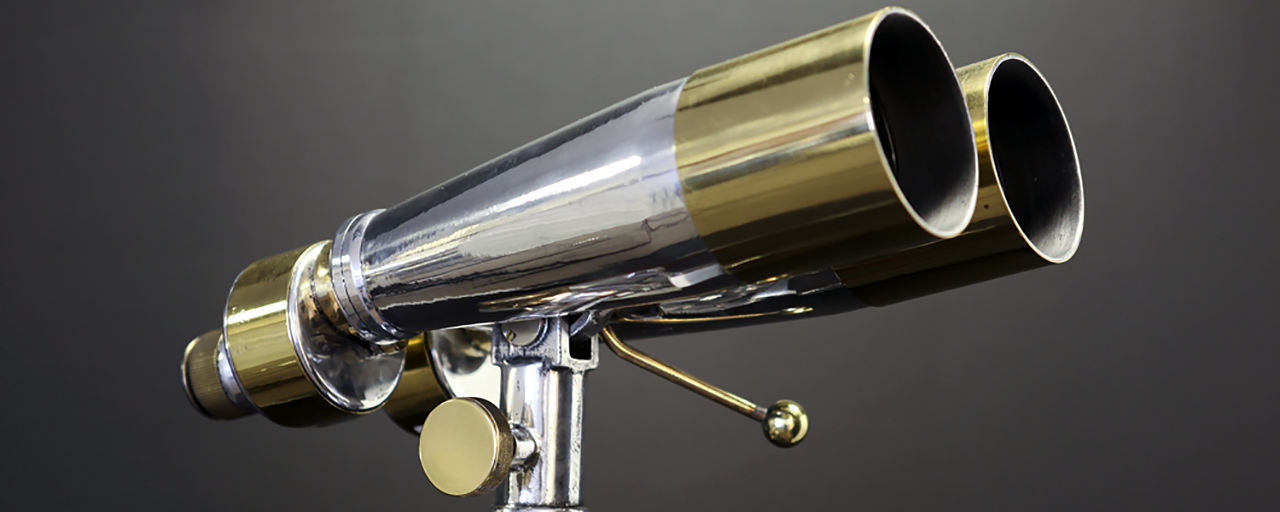
Binoculars for the war.
Restoring the economy
Japan ultimately was devastated by the war. One of the primary goals of the Allied occupation forces was the restoration of Japan’s economy. That helped Tashima, who was just as determined to put Minolta back on its feet. Employees dug through the company’s bombed-out factories to salvage parts. In 1946 the company produced Japan’s first post-war camera, the Semi III.
Since the Japanese camera industry’s major pre-war competitors, the Germans, had been ruined during wartime bombing – while the Japanese developed their own optical industry – worldwide markets first opened to the Japanese in the post-war years. The Minolta Semi III was the first camera to be exported after the war, with a shipment of 170 cameras in 1947.
Also that year, Chiyoda Kogaku Seiko became the first company to produce coated lenses in Japan, and in 1948 it began to design and produce a camera to compete with the industry standard, the Leica 35 millimetre. Chiyoda Kogaku Seiko designed a new sand-cast body in which lenses could be changed, with a hinged back cover to make film loading easier. The new Minolta 35 included a faster f2.8 lens and more-dependable flash photography.
Expanded Exports Starting in Mid-1950s
The Company still had to contend with its poor image in overseas markets. Japan had copied German lens technology, and the made-in-Japan label still implied goods of inferior quality. Other Japanese camera firms changed that perception.
Takeshi Mitarai of Canon – then known as Precision Optical – persuaded U.S. occupation forces to stock his cameras in military stores. U.S. servicemen stationed in the East took their cameras home, and Japanese-made cameras soon came to stand for high-quality lenses. That new reputation was reinforced industry-wide when U.S. photographers assigned to the Korean War began to use Nikon cameras; they claimed that their Nikon lenses were superior to the Leicas they were accustomed to using.
Chiyoda Kogaku Seiko began exporting to the United States in 1955 through an agreement with the American firm FR Corp. The company introduced another breakthrough, the achromatic double-coated lens, in 1956, giving the company entry into the European market beginning late in 1957.
Also in 1958, Chiyoda Kogaku Seiko introduced its first single-lens reflex (SLR) camera. When interchangeable lenses came into use in the early 1950s, the rangefinder posed problems: the photographer saw the same image no matter what lens was used, instead of seeing what the camera would actually photograph. The difference between the two images could be substantial.
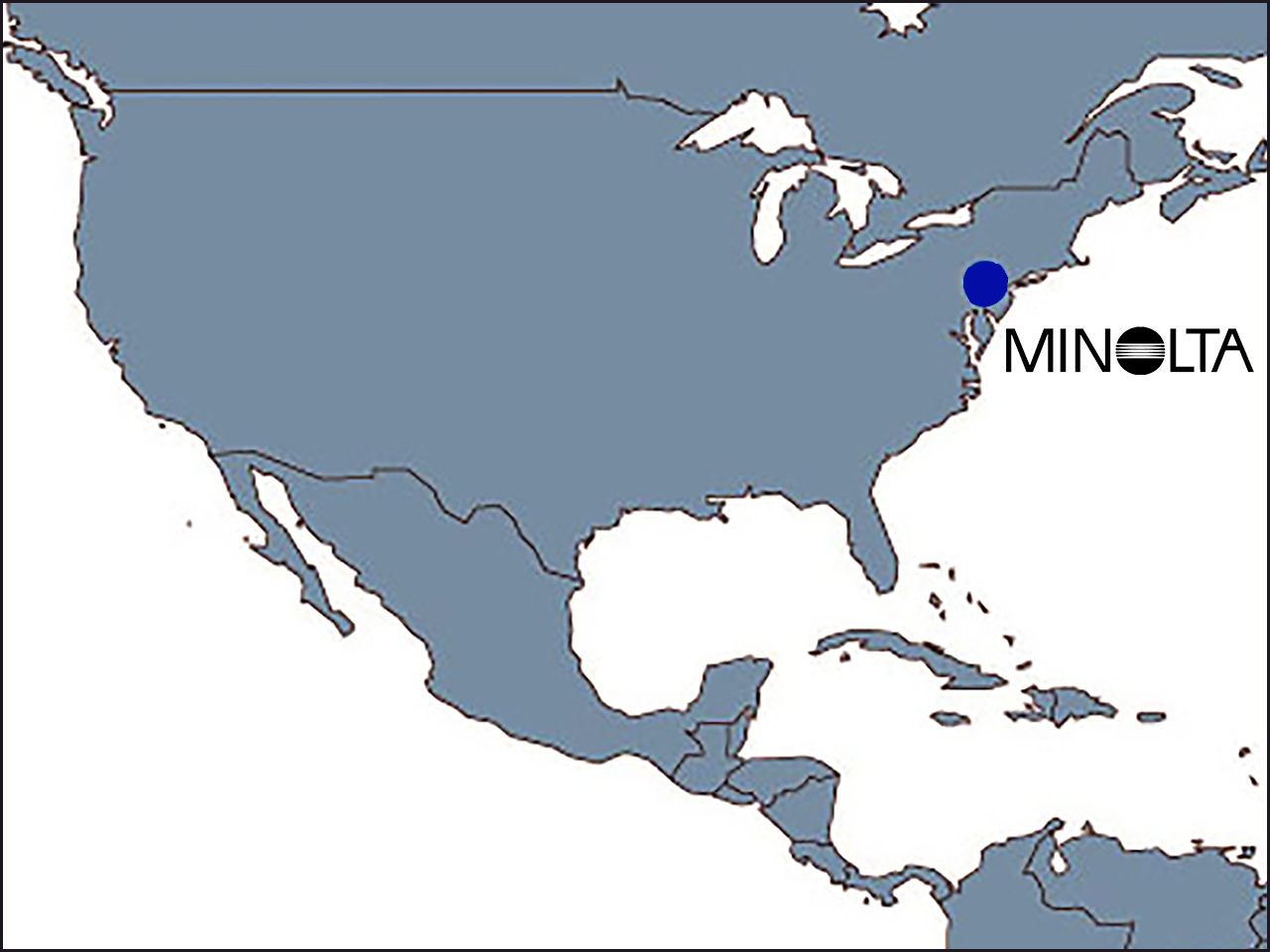
The first American subsidiary is established in Philadelphia, USA. In 1952, Konica Camera Company, an American distributor of Konica (named Konishiroku Photo Industry Co., Ltd. at the time) was opened in Philadelphia, USA to facilitate distribution of products. This was followed by the establishment in the same city of an American subsidiary, Koniphoto Corporation in September 1956 to reinforce import and after-sales services.
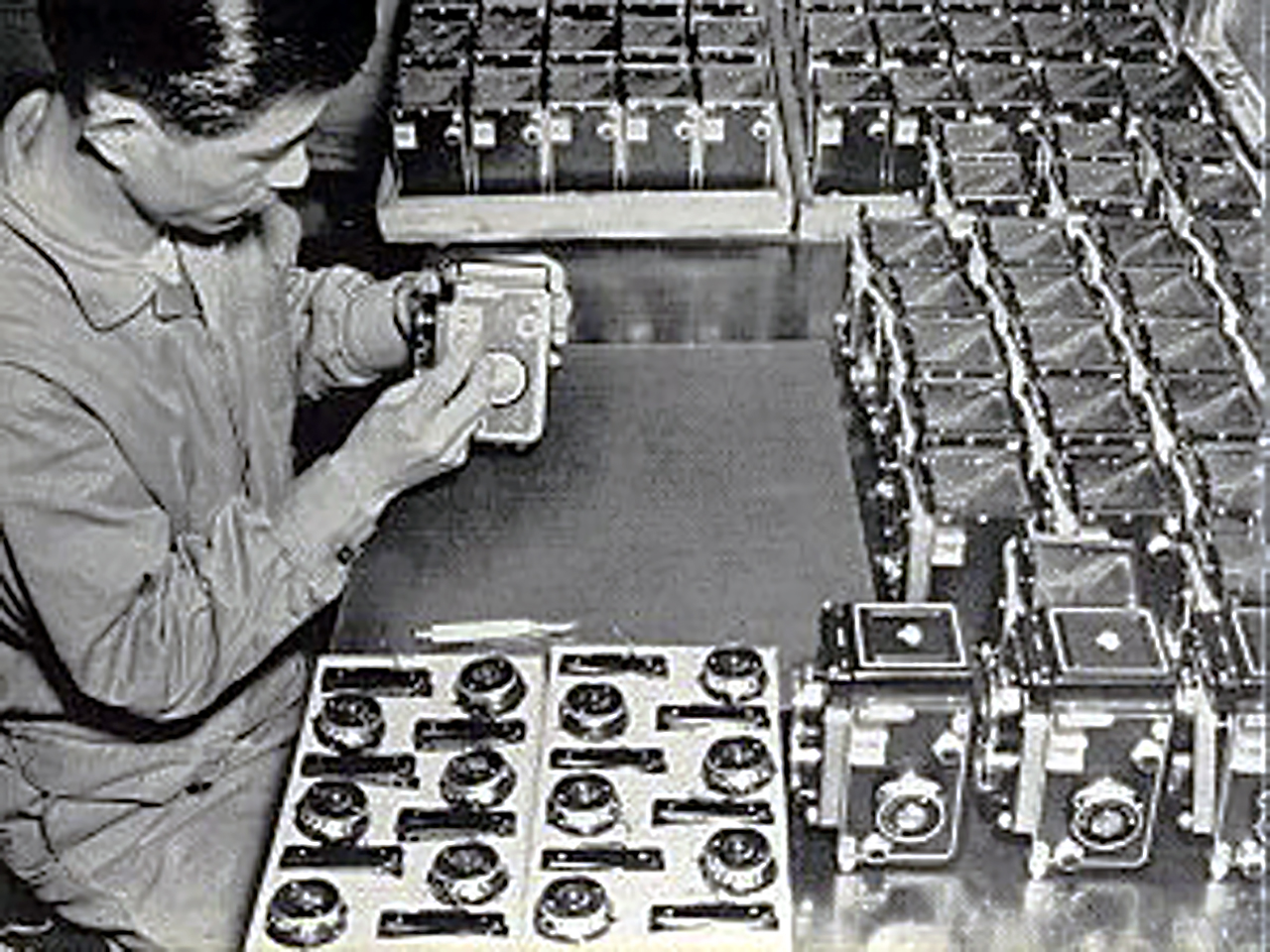
Assembly of the Minolta Autocord in the fifties.
PRODUCTS OF THE FIFTIES & SIXTIES
By the mid-1950s the major Japanese camera companies were developing the more convenient SLRs, and Chiyoda Kogaku Seiko introduced its version, the SR-2, in 1958. Its major competitor was Nikon’s SLR, also introduced in 1958, which was recognized as the best of the SLRs at the high end of the market.
Chiyoda Kogaku Seiko opened its first overseas subsidiary, Minolta Corporation, in New York City in 1959. Shortly thereafter, in mid-1962, Chiyoda Kogaku Seiko changed its own name to Minolta Camera Co., Ltd.
 In the 1960s the company continued improving its camera line. It introduced the Uniomat, with a programmed shutter, in 1960, which led to fully programmed auto-exposure in the Hi-Matic. In 1962 John Glenn chose the Hi-Matic to take the first photos of earth from space.
In the 1960s the company continued improving its camera line. It introduced the Uniomat, with a programmed shutter, in 1960, which led to fully programmed auto-exposure in the Hi-Matic. In 1962 John Glenn chose the Hi-Matic to take the first photos of earth from space.
In 1966 Minolta introduced its longest-running camera line, the SR-T series, which was produced continuously until 1981. These cameras featured through-the-lens light metering, using a patented light compensator to improve exposure in backlit photos. These new products made Minolta more competitive in Europe, so Minolta opened a European subsidiary, Minolta Camera Handelsgesellschaft, in Hamburg in 1965.
Diversification in the 1960s and 1970s
More importantly Minolta diversified. In 1960 the company entered the office copying market-an area that would prove as successful as cameras-when it produced the Copymaster.
 Minolta continued to develop its links with the U.S. space program, developing the Minolta Space Meter, a state-of-the-art technology for measuring exposures, for the first manned orbit of the moon, the 1968 Apollo 8 mission.
Minolta continued to develop its links with the U.S. space program, developing the Minolta Space Meter, a state-of-the-art technology for measuring exposures, for the first manned orbit of the moon, the 1968 Apollo 8 mission.
The meter was used on nine more Apollo missions, including the mission that landed a man on the moon in 1969.
The company introduced a single-lens reflex camera using cartridge film in 1976, but despite a $2 million U.S. advertising campaign the product was unsuccessful. Other camera developments were more successful.
In 1977 Minolta produced one of the first “smart” cameras. Its XD Series cameras had the first system to override user aperture settings in poor lighting.
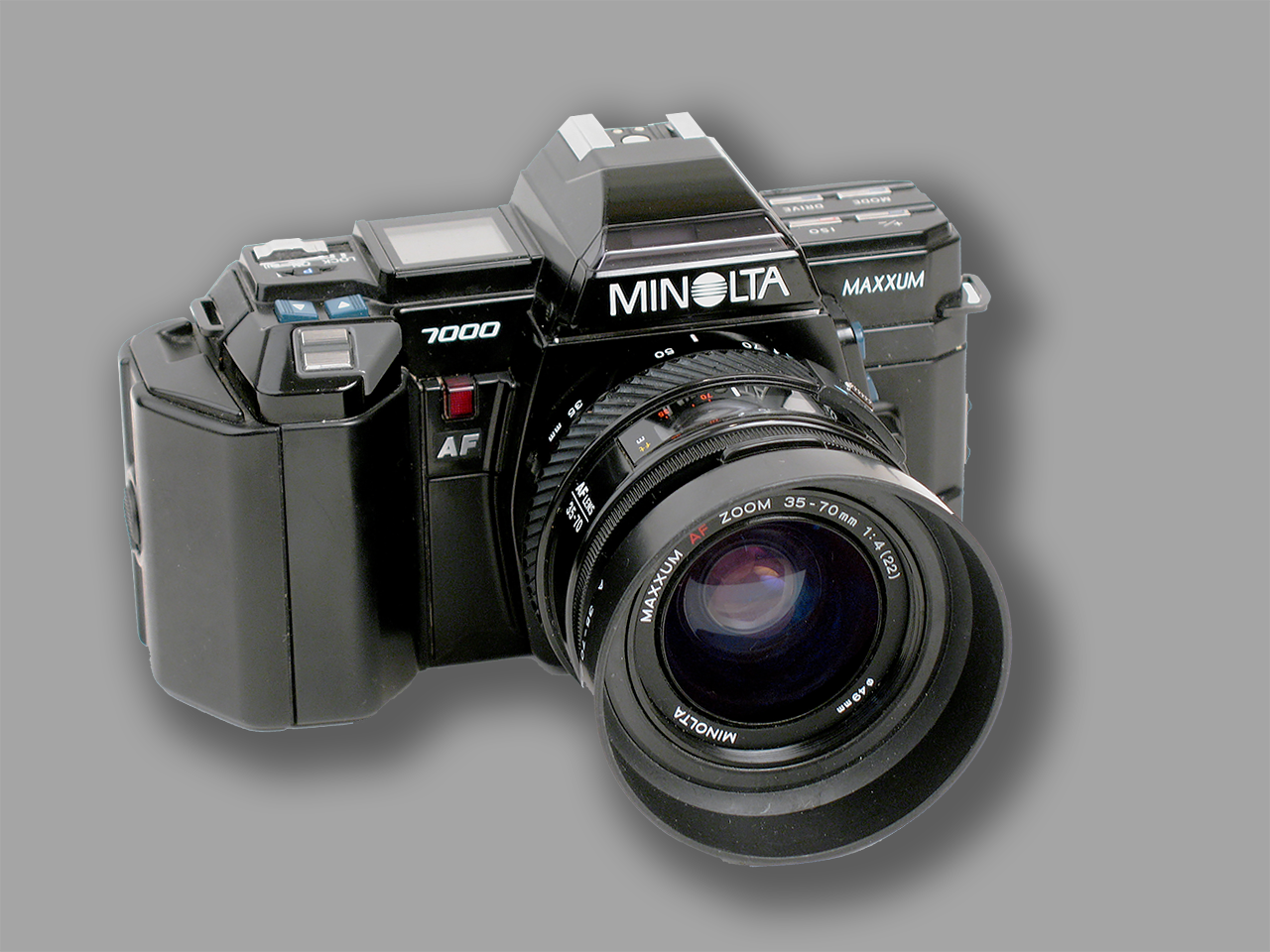
The Minolta MAXXUM 7000 (7000 AF in Europe and α-7000 in Japan) 35 mm SLR camera was introduced in February 1985. It was the first camera to feature both integrated autofocus (AF) and motorised film advance, the standard configuration for later amateur and professional single lens reflex cameras.
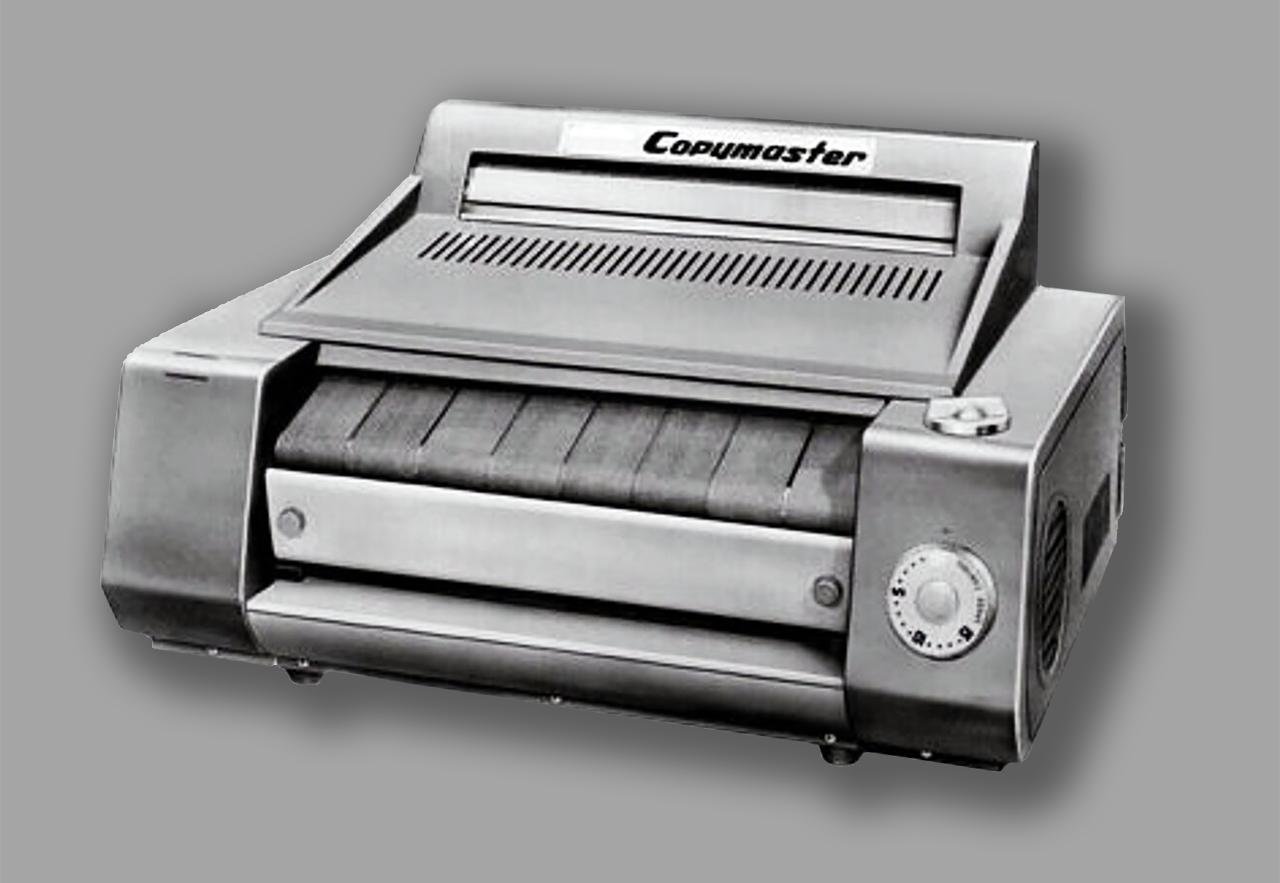
Minolta (named Chiyoda Kogaku Seiko at the time) set about development of optical equipment, particularly copiers, leveraging their technical expertise in camera products, and completed the first copier, Minolta Copymaster, a wet-process diazo copier, in 1960.
Redefined Corporate Image in the 1980s
 Minolta responded by redefining itself. It adopted a new logo in 1981 to reflect its broader purpose, and redefined its mission as processing light and images in all types of environments.
Minolta responded by redefining itself. It adopted a new logo in 1981 to reflect its broader purpose, and redefined its mission as processing light and images in all types of environments.
In 1983 Tashima, who had run the company since he founded it, left active management. Tashima relinquished the presidency to his son, Hideo Tashima, and became chairman of the board, the position he held when he died in 1985.
In the 1980s new camera technology brought the company the most attention. In 1985 Minolta unveiled its Maxxum, a SLR 35-millimetre camera with an autofocusing system. The Maxxum became a successful competitor to the less-expensive non-SLR cameras, such as Canon’s Snappy and AE-1.
A U.S. advertising campaign costing over $15 million and technological advances that made the Maxxum the European Camera of the Year for 1985 aided its success. The Maxxum challenged Canon’s pre-eminence in the 35-millimetre market, but it was not long before Minolta’s Japanese competitors struck back with autofocus cameras of their own.
Canon improved on the Maxxum by building the focusing system into the lens itself instead of housing it in the camera body with a mechanical link to the lens, as Minolta had done. Canon’s advance made focusing faster, but its camera was more expensive than the Maxxum.
Difficult Times in the Early 1990s
Minolta suffered through a prolonged downturn in the early 1990s, with a number of developments contributing to the malaise. First, the camera market had become even more competitive in the late 1980s with the introduction of the first 35mm disposable camera, the QuickSnap from Fuji Photo Film, in 1987 and the first super-compact camera, Konica’s Big Mini, in 1989.
More convenient and less expensive than the bulky, feature-packed cameras offered by Minolta, Canon, and the other major camera makers, the new smaller models quickly caught on–with Fuji seemingly coming out of nowhere to attain the top spot in cameras by 1992.
During the same period, video cameras–or camcorders–became increasingly affordable and further eroded the sales of the traditional cameras Minolta specialized in.
A second factor in Minolta’s difficulties–although it affected the company’s financial results in only one year, 1992-was the lawsuit filed by Honeywell Inc. in 1987 against Minolta.
Honeywell had won approval for several patents relating to autofocus technology, which it had intended to use in its own 35mm camera but eventually abandoned the effort in the mid-1970s. When autofocus SLR cameras gained great popularity in the mid-1980s, Honeywell prepared lawsuits against nearly all the major camera makers.
Minolta eventually settled with Honeywell out of court in 1992, agreeing to pay ¥16.9 billion (U.S.$125.1 million) for infringing patent rights. After posting a net loss of ¥2 billion in 1991, Minolta lost ¥36.1 billion in 1992 thanks in part to the settlement.
The third factor in the overall decline was the prolonged Japanese recession of the early 1990s, which hurt domestic sales, and the appreciation of the yen. Minolta’s net sales declined for three straight years, starting in 1992. Although the company’s losses narrowed each year, Minolta would not return to profitability until 1996.
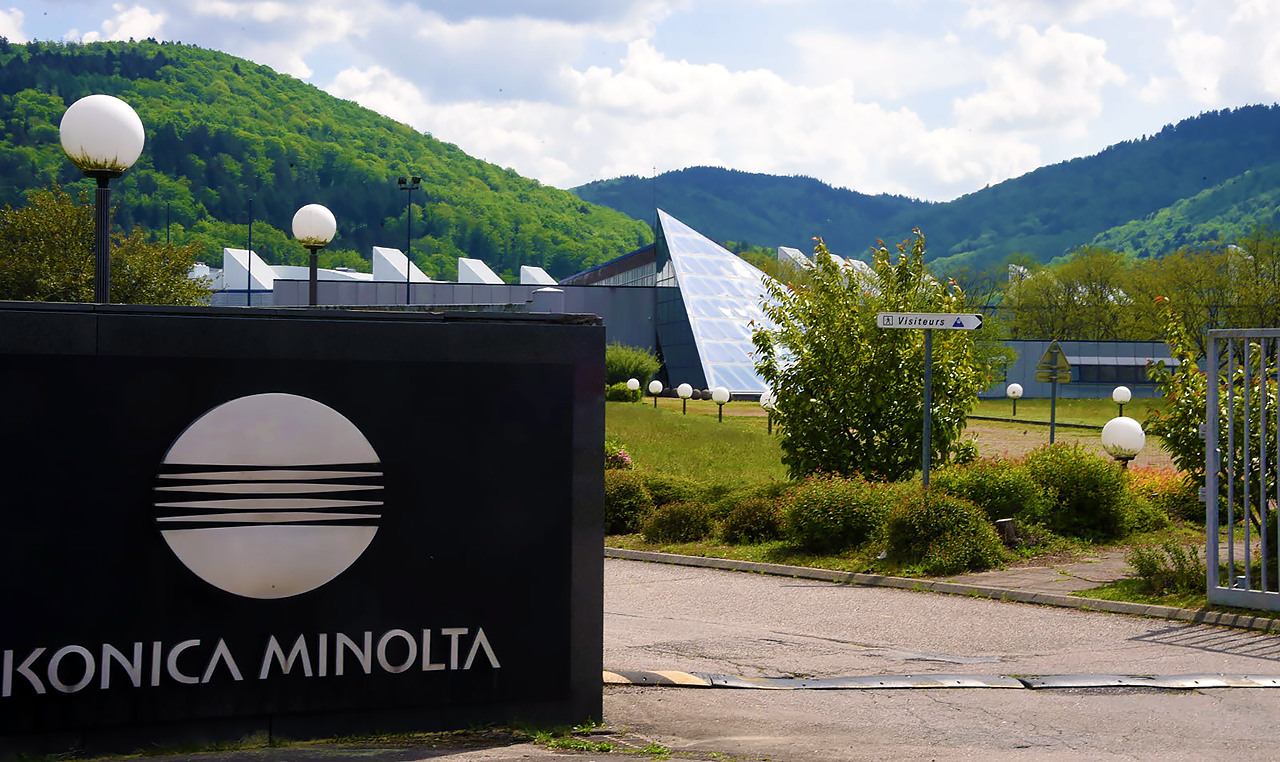
Minolta Lorraine S.A., France.
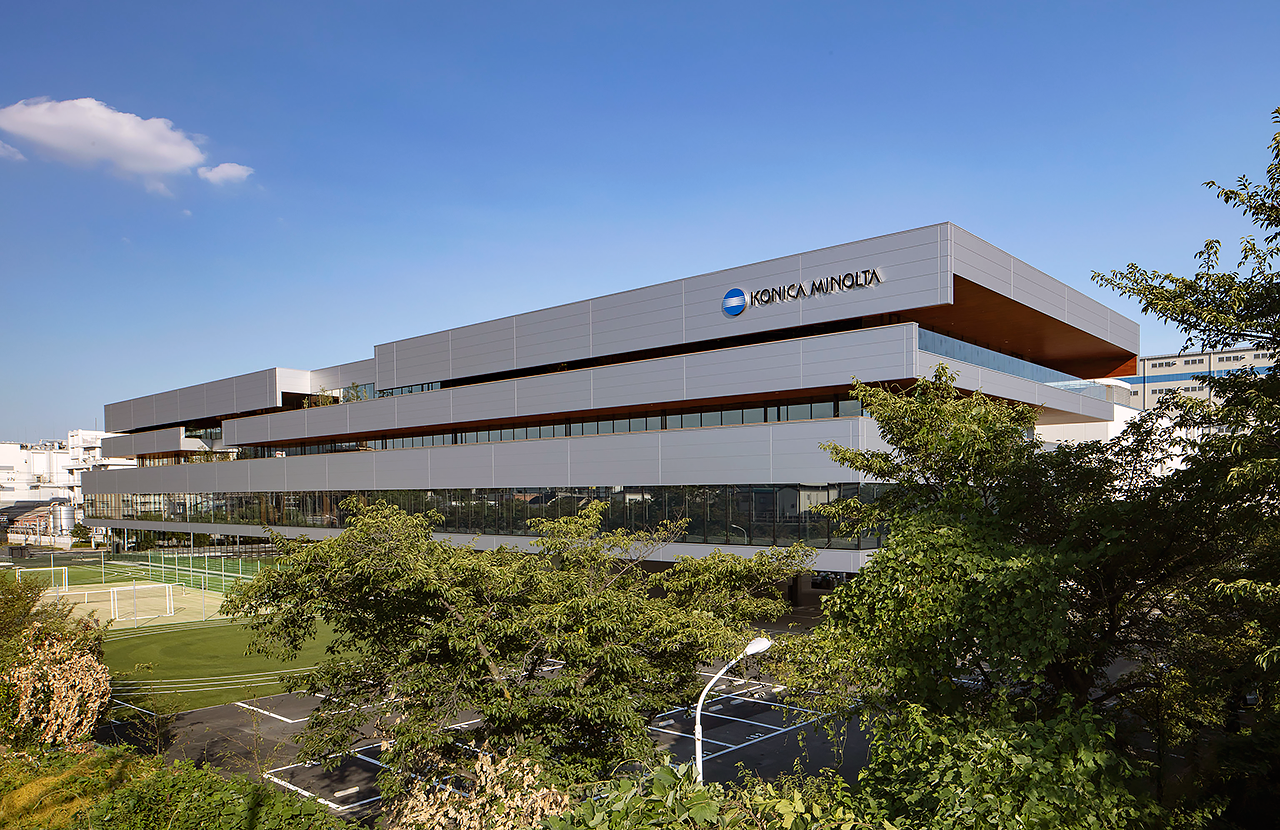
In August 2019, Konica Minolta opened the Innovation Garden OSAKA Front, an open innovation center for the development of imaging IoT in Japan’s western Kansai region, in Umeda, Osaka. The Innovation Garden OSAKA Center serves as a hub for imaging IoT/AI development and business creation in the Kansai area.

Japan suffered in the early 1990s of a prolonged recession
Comeback Complete by 1996
To turn the company around, Tashima and Kanaya pursued three main objectives: moving production out of Japan to lessen the effects of the strong yen, developing a camera to compete in the compact category, and continuing to diversify the Minolta product line and derive a smaller percentage of revenues from cameras. The first objective of moving production overseas began to be implemented in 1992 with the establishment of Minolta Lorraine S.A., based in France. This facility was set up to make toner, lenses, and other components for imaging products; low-end copiers were then added to its assembly lines, with these products sold mostly in the European market. In 1994 Minolta entered into two joint ventures in China for the manufacture and sale of cameras and copiers.
In early 1995 Minolta successfully entered the compact camera category with the launch of the Riva Zoom 70W (known in Japan as the CAPIOS and in North America as the Freedom).Minolta also joined the cooperative development effort brought together by Eastman Kodak Co.- the others were Fuji, Canon, and Nikon – which created the Advanced Photo System (APS), an effort to revitalize the stagnant still photography market.APS offered easy loading and the ability to select from three photo sizes (4 inch by 6 inch, 4 inch by 7 inch, and a panoramic 4 inch by 10 inch) as pictures are taken.Minolta introduced a full line of APS cameras in early 1996 under the VECTIS-brand.The VECTIS line included five compact models and a high-end SLR version that featured five interchangeable lenses.Later in 1996, Minolta launched a children’s camera tied to a new animated series.
The company’s desire for further diversification was highlighted in mid-1994 by the decision to change the company name to Minolta Co., Ltd., dropping “Camera.” The company soon showed a renewed commitment to innovative new product development. In 1995 digital cameras were added to the Minolta product family with the marketing of the RD-175, touted as “one of the smallest and lightest SLR-type digital cameras in the world.”
By 1996, Minolta had certainly begun to turn its fortunes around, although its profit margin of 1.2 per cent was significantly lower than that of the mid-1980s.The diversification program seemed to be working; camera sales made up 44 per cent of overall sales in 1991, but only 29.4 per cent in 1996.Along with its revitalized reputation for innovation, Minolta appeared ready to be a major player in the high tech world of the 21st century.
Minolta’s history in the late 20th century and early 21st century in brief until the camera market is said goodbye in 2007
- 1997: Minolta Camera Sales Co. Ltd. and Minolta Business Equipment Trading Co. Ltd are merged to form Minolta Sales Co. Ltd.
- 1999: Osamu Kanaya is replaced as company president by Yoshikatsu Ota.
- 2000: Minolta forms a partnership with Konica Corporation.
- 2001: Minolta sets up a joint venture with Fujitsu.
Since 2003: KONICA MINOLTA
- 2003: Konica Minolta Holdings, Inc. is established by integrating the management of Konica Corporation and Minolta Co., Ltd.
- 2004: Nassenger V — a next-generation inkjet textile printer is launched
- 2007: Konica Minolta withdraws from the photo and camera business
The company provided these cameras and other products:
The Minolta Alpha/Dynax/Maxxum (Alpha in Japan and China, Maxxum in the Americas, Dynax in Europe, Africa and Asia) is a line of 35mm film SLR cameras built from 1985 to 2000.
The last models appeared badged as “Minolta” despite of the merger with Konica in 2003.
interchangeable lens
- Minolta 35 / 35 Model II / 35 Model IIB
- Minolta Super A
- Minolta Sky
- Leitz Minolta CL
- Minolta CLE
fixed lens
- Minolta A / A-2 / A-2 LT / A3 / A5 / AL / AL2 / ALS / ALE / AL-F
- Minolta Electro Shot
- Minolta Hi-Matic/Ansco Autoset
- Minolta Hi-Matic 7 / 7sII/Revue 400SE / 9 / 11 / CS / E / ES / F / FP
- Ansco Autoset CdS
- Minolta Minoltina AL-S / S
- Minolta Minoltina-S
- Minolta Uniomat/Ansco Anscoset / Uniomat II/Ansco Anscoset II / Uniomat III/Ansco Anscoset III
- Minolta V2 / V3
fixed lens
- Minolta 24 Rapid
fixed focus
- Minolta Autowide
- Minolta F10 / F10BF / F12 / F15BF / F20R / F25 / F35 Big Finder
- Minolta Freedom 1 / 35R-FF / 50 / 100 / 101 / GT / Holiday
- Minolta FS-E/FS-E II / FS-E III / 35
- Minolta Hi-Matic 5 / C / CSII / G / G2 / GF / S / S2 / SD / SD2
- Minolta Memo
- Minolta Memory Maker / II / III
- Minolta Minoltina-P
- Minolta Repo / Repo-S (half-frame)
- Minolta Riva 35 / 35 ST / GT
autofocus
- Minolta Freedom AF-10R Date / AF 35, Mac 35 / 50N / 200 / Vista / Escort
- Minolta Riva 35 / 100 AF / AF 35 / AF 35c / AF 35 EX / Mini / Panorama
dual lens
- Minolta Freedom Dual Dual 60 / Dual C
- Minolta Riva Twin 28
zoom lens
- Minolta Riva AF 45 / AF5 / Pico / 70 / 70C / 70W / 70EX / 75W / 90c / 90W / 90EX / 105 / 105i / 105EX / 110EX / 115 / 115EX / 125 / 125EX / 130 / 130EX / 140 / 140EX Panorama Date / 150 / 150EX / 160 / 160EX
- Freedom Family Zoom / Zoom II / Sightseer Zoom / Apex 70 / Capios 25 / Capios 75 / Apex 90 / Traveller / Apex ZF900 / Apex 105 /Capios 115 / Capios 115S / Capios 125 / Capios 125S / Capios 130S / Capios 140 / Capios 140A / Capios 150S / Capios 160A /
- Freedom Action Zoom II / Zoom 60 / Autodate Zoom / Silver Streak Zoom / Zoom Explorer 70c / Zoom Explorer 70W / Zoom Explorer 70EX / Zoom Explorer EX / Zoom 90c / Zoom 90W / Zoom 9EX / Orion / 105i / 105EX / 110EX / 115 / 115EX / 125 / 125EX / 130 / 130EX / 135EX / 140 / 140EX / 150 / 150EX / 160 / 160EX / Supreme Freedom Zoom EX
zoom series
- Minolta Zoom 60 / 70 / 80 / 110 / 160C
autofocus other
- Minolta AF-101R / AF-101R Red Eye Reduction Date / AF25 / AF50 Big Finder / AF-C / AF-DL (Freedom DL) / AF-E (Auto Focus Freedom II) / AF-E II / AF Motor / AF-S / AF-Sv / AF-SP / AF-T / AF-Tele / AF-Tele 60 / AF-Tele Super / Leica AF-C1 / AF-Z (Minolta Freedom I) / AF-Zoom 65 (Mac Zoom 65) / AF-Zoom 90 (Mac Zoom 90)
- Minolta Hi-Matic AF / AF2 / AF2-M
- Minolta P-Twin
- Minolta Panorama Zoom 28
- Minolta Prod-20’s
- Minolta TC-1
- Minolta Weathermatic 35 DL (underwater camera)
Kodapak film
- Minolta Autopak 400-X / 500 / Ilford Monarch / Revuematic 500 / 550 / 600-X / 700 / 800 / Revere 3M Automatic 1064
- Konan-16 Automat
- Stereo Konan-16
- Minolta-16 / 16 Automat / 16 Cds / 16 EE / 16 EE II
- Minolta-16 II
- Minolta-16 MG / MG-S / P / Ps / QT
- Minolta Sonocon 16 MB-ZA
- Minolta Auto-Zoom-X
- CM-16 prototype (attribution is unsure)
110 film cameras
- Pocket Autopak 40 / 50 / 60 / 70 / 200 / 230 / 250 / 270 / 430E / 430Ex / 440E / 440Ex / 450E / 450Ex / 460T / 460Tx / 470
- Weathermatic-A underwater camera
- Minolta 110 Zoom SLR / SLR Mark II
126 film cameras
- Minolta Autopak 400X / 500 / 550 / 600X / 700 / 800
Disc film cameras
- Minolta ac 101 Courrèges / ac 301 Courrèges
- Minolta Disc-5 / 7 / S / K
digital cameras
- Vectis 10 / 20 / 25 / 30 / 40 / 100BF / 200 / 260 / 300 / 300L / 2000 / 3000 / GX-1 / GX-2 / GX-3 / GX-4 waterproof camera / UC / Weathermatic Zoom underwater camera
- Minolta SR66
- Minoltaflex (I) / Automat / Automat prototypes
- Minoltaflex II / IIB / III
- Minoltacord / Minoltacord Automat
- Minolta Autocord / CDS I / CDS II / CDS III /
- Minolta Autocord I / II / III / L / MXS / MXV / RA / RB / RG / RI
- Minolta Six
- Semi Minolta I / II
- Auto Semi Minolta
- Semi Minolta III A/B/C
- Semi Minolta P or Minolta Semi P
- Minolta Miniflex
- Minolta Vest or Best
- Baby Minolta
folding bed 6.5×9
- Nifcaklapp
- Nifcasport
- Sirius and Lomax
- Arcadia and Eaton
- Happy
strut folding 6.5×9
- Nifca-Dox
- Minolta
- Autofocus Minolta and Auto Minolta
- Auto Press Minolta
- Minolta Instant Pro
Smaller film formats
- Vectis S-100
- Vectis S-1
Cine cameras
- Minolta Autopak-8 D6
shutters
- Lidex
- Crown
- KTI-Tiyoko
- KOO-Tiyoko
lenses
- Rokkor
- Celtic
- Maxxum (Minolta AF)
- Vectis
bellows
- Minolta Auto Bellows 1 / II / III
- Minolta Bellows II / III / IV
- Minolta Compact Bellows
meters
- View Meter 9 (1964)
- Auto Meter Professional (1971)
- Auto Meter II (1976)
- Auto Meter III F (1981)
- Auto Meter III F (1983)
- Auto Meter IV F (1992)
- Auto Meter V F (2002)
- Space Meter 1 (1969)
- Space Meter 2 (1983)
- Spotmeter M (1980)
- Spotmeter F (1981)
- Color Meter (1970)
- Color Meter II (1980)
- Color Meter III F (1992)
- Flash Meter (1969)
- Flash Meter II (1976)
- Flash Meter III (1980)
- Flash Meter IV (1986)
- Flash Meter V (1995)
- Flash Meter VI (2002)
- Auto-Spot (1968)
- Auto-Spot II (1976)
- Auto-Spot II digital
some Minolta cameras
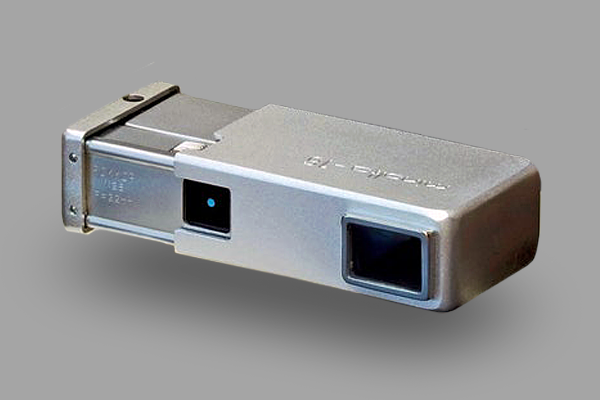
Subminiature camera 16-II
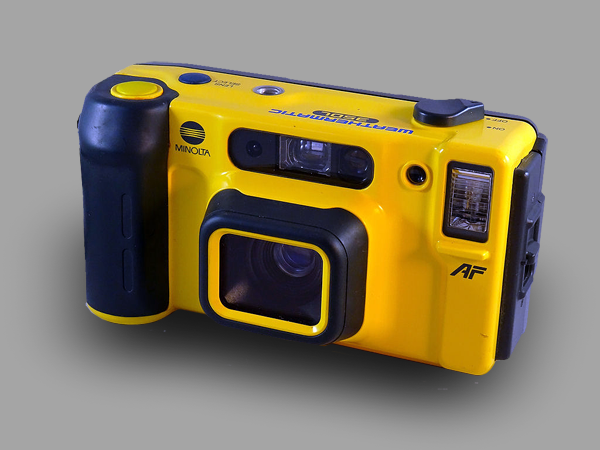
Autofocus Viewfinder Weathermatic 35DL camera
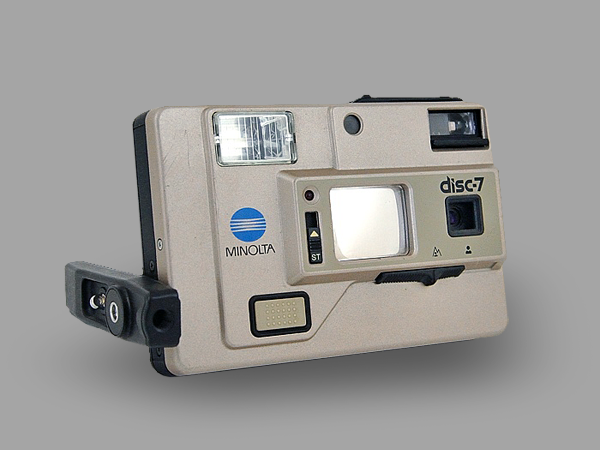
Discfilm-7 camera
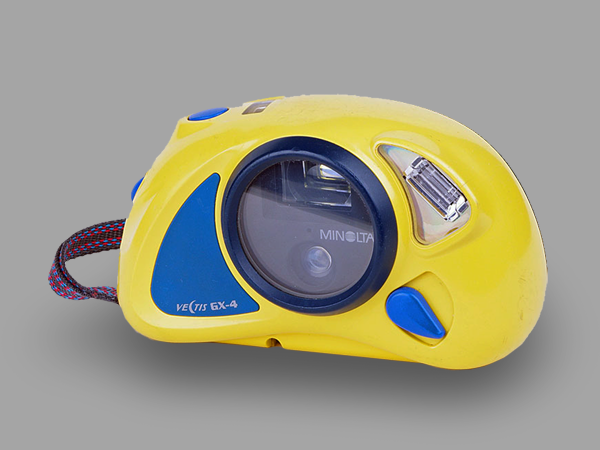
APS camera Vectis GX-4
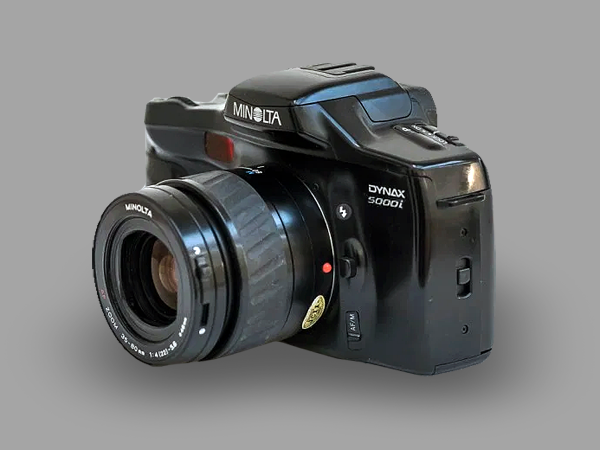
Minolta Dynax 5000i (also known as the Maxxum 5000i) camera
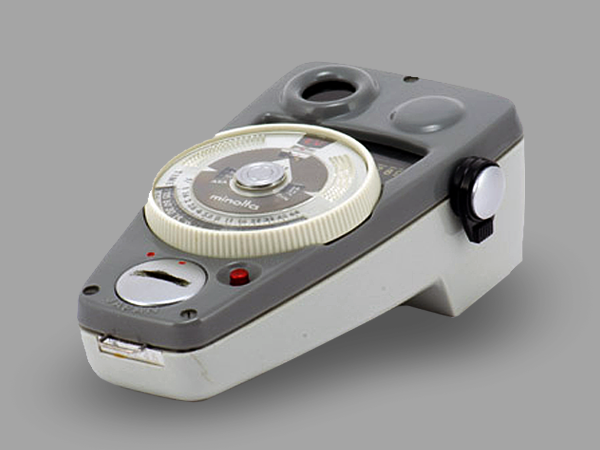
View Exposure Meter 9

FOUNDER: Walter Zapp
COMPANY NAMES:
in 1948 at a new company, Minox GmbH, in Giessen/Heuchelheim, West Germany
Minox continues to operate today, producing or branding optical and photographic equipment.
In 1996, Minox GmbH moved its headquarters from Giessen/Heuchelheim to Wetzlar and from there sells its product range worldwide.
Minox is a manufacturer of cameras, known especially for its subminiature camera. From the start the Minox also gained wide notoriety as a spy camera. Minox branched out into 35 mm film format and 110 film format cameras in 1974 and 1976, respectively. In addition to these classic subminiature cameras, Minox has also made a name for itself in the field of 35 mm viewfinder cameras, compact cameras, digital cameras and long-range optics. Compact dimensions, the highest quality, robust mechanics and an outstanding design are the characteristics of every Minox product.
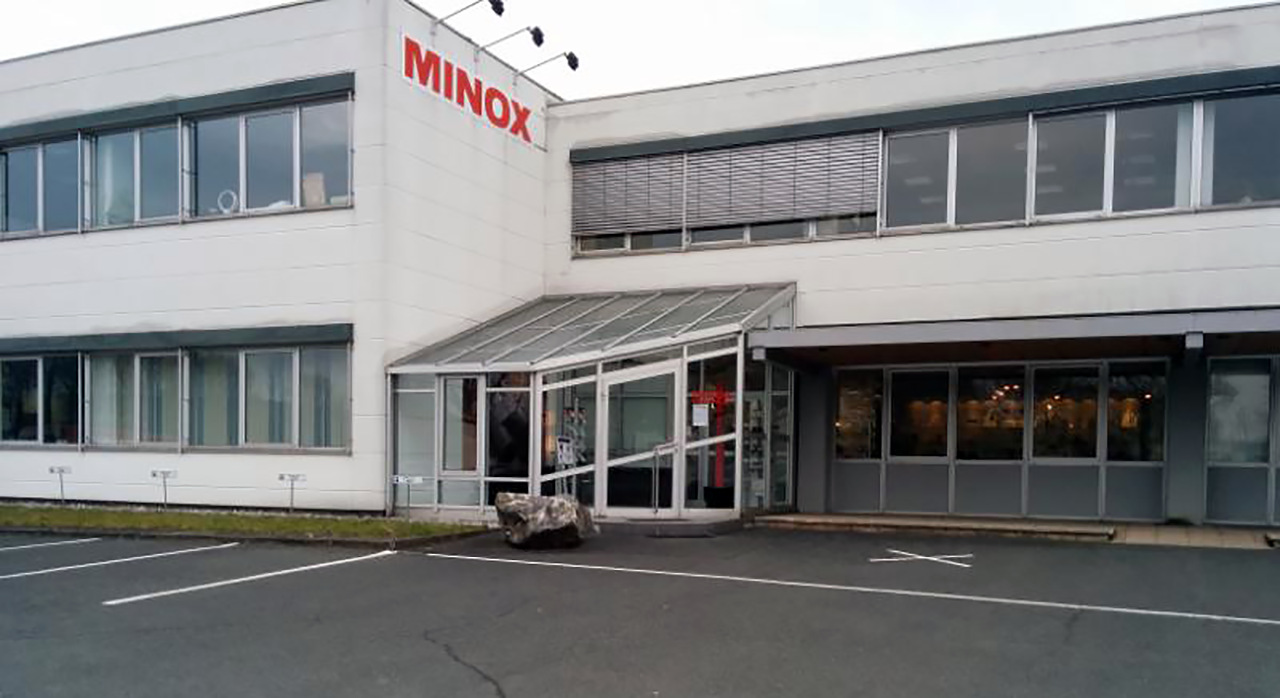
The Minox company at Wetzlar
The original Minox subminiature camera was invented by Walter Zapp in 1936. Zapp, a Baltic German, was born in 1905 in Riga, then part of the Russian Empire. The family moved to Reval (now called Tallinn, Estonia) where he first took a job as an engraver before finding a position with a photographer.
He became friends with Nikolai ‘Nixi’ Nylander and Richard Jürgens, and it was through discussions with these friends that the idea of a camera that could always be carried came to him.
 Nixi Nylander also coined the name “Minox” and drew up the Minox mouse logo.
Nixi Nylander also coined the name “Minox” and drew up the Minox mouse logo.
Jürgens funded the original project but was not able to get support in Estonia for production. Jürgens contacted an English representative of the VEF (Valsts Elektrotehniskā Fabrika) electrotechnical manufacturing business in Riga (by then independent Latvia) who then arranged a meeting where Zapp demonstrated the Minox prototype (UrMinox), with a set of enlargements made from Ur-Minox negatives.
Production began in Riga at VEF, running from 1937 until 1943. In the same time, VEF had received patent protection on Zapp’s inventions in at least 18 countries worldwide.
Shortly after its introduction, the Minox was widely advertised in The European and American markets.
 It did not surmount the popularity of 35 mm cameras (which were then referred to as “Miniature Cameras”), but did achieve a niche market. It also attracted the attention of intelligence agencies in America, Britain and Germany, due to its small size and macro focusing ability.
It did not surmount the popularity of 35 mm cameras (which were then referred to as “Miniature Cameras”), but did achieve a niche market. It also attracted the attention of intelligence agencies in America, Britain and Germany, due to its small size and macro focusing ability.
Ironically during World War II production of the Minox was put in jeopardy several times as Latvia fell victim to invasion by the Soviet Union, then Germany, and then by the Soviets again. Cameras were produced under both Russian and German occupation nevertheless, and the camera became both a luxury gift item for Nazi leaders as well as a tool for their spies. In the meantime, Zapp and his associates protected their interest in the product by searching for alternative production facilities in Germany.
The first product to carry the Minox name was a subminiature camera, conceived in 1922, and finally, starting with a piece of wood of the maximum allowed size, Baltic German inventor Walter Zapp developed his first subminiature camera in 1936.
 Walter Zapp originally envisioned the Minox to be a camera for everyone requiring only little photographic knowledge. Yet in part due to its high manufacturing costs the Minox became more well known as a must-have luxury item. From the start the Minox also gained wide notoriety as a spy camera.
Walter Zapp originally envisioned the Minox to be a camera for everyone requiring only little photographic knowledge. Yet in part due to its high manufacturing costs the Minox became more well known as a must-have luxury item. From the start the Minox also gained wide notoriety as a spy camera.
The Latvian factory VEF (Valsts elektrotehniskā fabrika) manufactured the camera from 1937 to 1943. After World War II, the camera was redesigned and production resumed in Germany in 1948.
From 1936 to 1975 the history of the Minox brand is essentially that of the Minox subminiature camera. From 1975 the Minox name also became associated with other products, most notably the Minox 35 mm compact cameras produced from 1975 until 2004.
Minox was acquired by Leica in 1996, but a management buyout on 25 August 2001 left Minox an independent company again. In 1996, Minox GmbH moved its headquarters from Heuchelheim near Giessen to Wetzlar and from there sells its product range worldwide.

Part of «Minox» manual cover, 1938. Source: VEF History museum
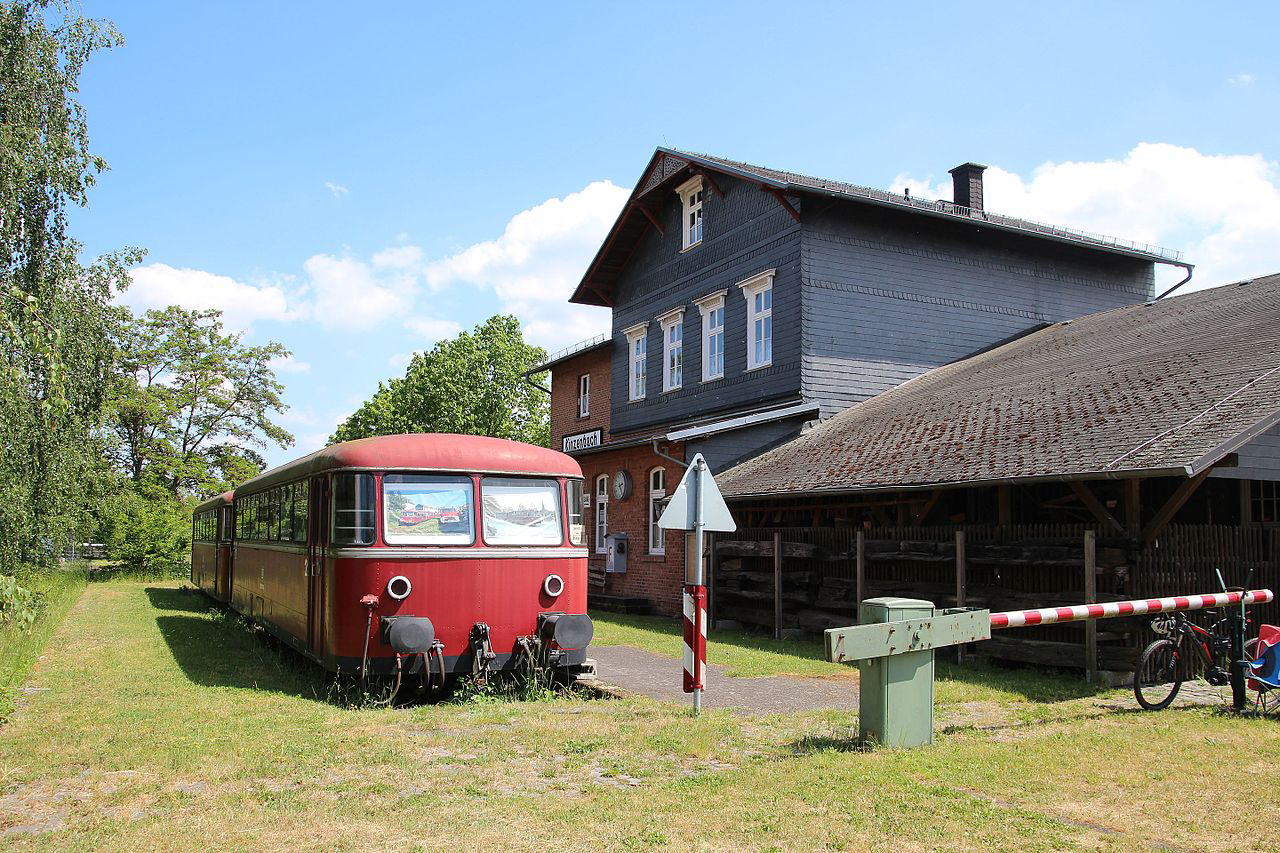
The Kinzenbach/Heuchelheim train station
 In 1969 the model C became the first camera of its kind to incorporate electronic exposure control. With the introduction of the LX came significant redesign of the camera’s basic controls. It was followed by the last production model, the TLX.
In 1969 the model C became the first camera of its kind to incorporate electronic exposure control. With the introduction of the LX came significant redesign of the camera’s basic controls. It was followed by the last production model, the TLX.
The production rate for these cameras was considerably slower than in former years, however, as high production costs and increasing competition from Japan sharply reduced sales and revenues.
Beginning in 1981, MINOX experienced increasing difficulties. A quarter of the original 750 employees had to be made redundant. A settlement request was filed with the District Court in Giessen on November 21, 1988. Under the direction of the receivership administration, the workforce was reduced to just under 300, and the business was extensively reorganized.
The MINOX TLX Camera was available until September 2014. Minox is now part of the Blazer Group GmbH, with its facilities in Isny im Allgäu in the south of Germany, with a service facility remaining in Wetzlar. Production of 8×11 film ended in 2015.
The company now produces high-quality sports optics and night-vision devices, its only camera models being trail cameras.
 Minox has produced two small digital cameras: the Minox DSC and the Minox DSC Silver, both known as Digital Spy Cam and suitable for inconspicuous photography. Although the DSC has an excellent lens and a resolution of 3.2 MP (Megapixels), it is unsuitable for document photography, as it has a minium focus distance of 1 metre.
Minox has produced two small digital cameras: the Minox DSC and the Minox DSC Silver, both known as Digital Spy Cam and suitable for inconspicuous photography. Although the DSC has an excellent lens and a resolution of 3.2 MP (Megapixels), it is unsuitable for document photography, as it has a minium focus distance of 1 metre.
The later DSC Silver however, is most suitable for document photography, as it has a minimum focussing distance of 50 cm and an improved resolution of 5.1 MP, whilst it is only slightly bigger than the old analogue Minox-B.
After World War II, production of the Minox II began in 1948 at a new company, Minox GmbH, in Giessen/Heuchelheim near Wetzlar, West Germany. The new camera very much resembled the original, but was made with a plastic chassis covered by an aluminium shell. This greatly reduced its weight and, to an extent, cost.
The camera continued to appeal to a luxury “gadget” market which broadened during the 1950s and early 1960s. It also continued to see use as an espionage camera by both sides during the Cold War.
 During this time, the Minox company continued to develop the camera, working with Gossen to develop a companion miniature exposure meter, as well as improved models such as the Minox B, which incorporated an even smaller Gossen-designed meter into the camera itself. In 1950 Josef Stüper suggested to Walter Zapp and E.Pfaffenberger that a special exposure meter be designed for the Minox. When it appeared in September 1951 the MinoSix was the smallest precision meter in the world measuring just 53 x 30 x 18mm.
During this time, the Minox company continued to develop the camera, working with Gossen to develop a companion miniature exposure meter, as well as improved models such as the Minox B, which incorporated an even smaller Gossen-designed meter into the camera itself. In 1950 Josef Stüper suggested to Walter Zapp and E.Pfaffenberger that a special exposure meter be designed for the Minox. When it appeared in September 1951 the MinoSix was the smallest precision meter in the world measuring just 53 x 30 x 18mm.
The Minox B became the most popular and widely produced model of the line. Further developments included auto-exposure, and the company developed an extensive line of accessories. These included flash guns, viewfinder attachments, tripod mounts, and copying stands, all increasing the camera utility in a variety of applications.
One accessory even allowed the camera to use a pair of binoculars as a telephoto lens. Limited editions of the camera were also produced in a variety of luxury finishes, such as gold plating. Standard cameras were also available in an optional black anodized finish. The Riga Minox camera, along with the luxury finish postwar cameras, are now collector’s items.
 The Minox subminiature camera attracted the attention of intelligence agencies in America, Britain and Germany, and most of the Eastern Bloc (East Germany, Romania) due to its small size and macro focusing ability. There is at least one document in the public record of 25 Minox cameras purchased by the US Office of Strategic Services intelligence organisation in 1942.
The Minox subminiature camera attracted the attention of intelligence agencies in America, Britain and Germany, and most of the Eastern Bloc (East Germany, Romania) due to its small size and macro focusing ability. There is at least one document in the public record of 25 Minox cameras purchased by the US Office of Strategic Services intelligence organisation in 1942.
The close-focusing lens and small size of the camera made it perfect for covert uses such as surveillance or document copying. Both Axis and Allied intelligence agents used the Minox during World War II. Later versions were used well into the 1980s. The Soviet spy John A. Walker Jr., whose actions against the US Navy cryptography programs represent some of the most compromising intelligence actions against the United States during the Cold War era, used a Minox C to photograph documents and ciphers.
An 18-inch (460 mm) measuring chain was provided with most Minox subminiature cameras, which enabled easy copying of letter-sized documents. The espionage use of the Minox has been portrayed in Hollywood movies and TV shows, and some 1980s Minox advertising has played up the “spy camera” story.
Over the years, Minox developed a wide range of accessories and add-ons for their subminiature cameras. Some of these were developed for a specific model, but others were suitable for more than one model, or even the entire range.
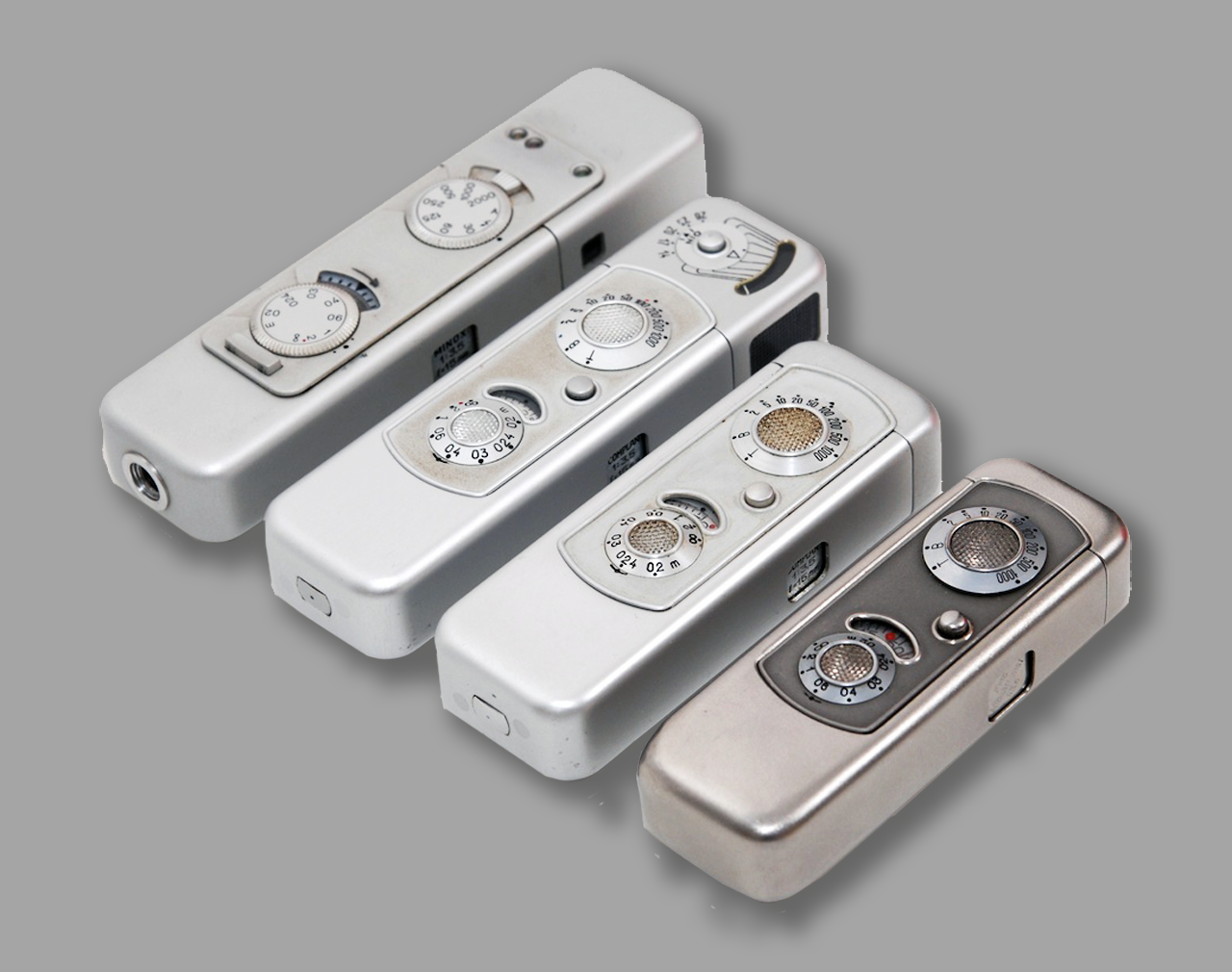
A set of Minox cameras varying in size and made in different years of manufacture in the last century.
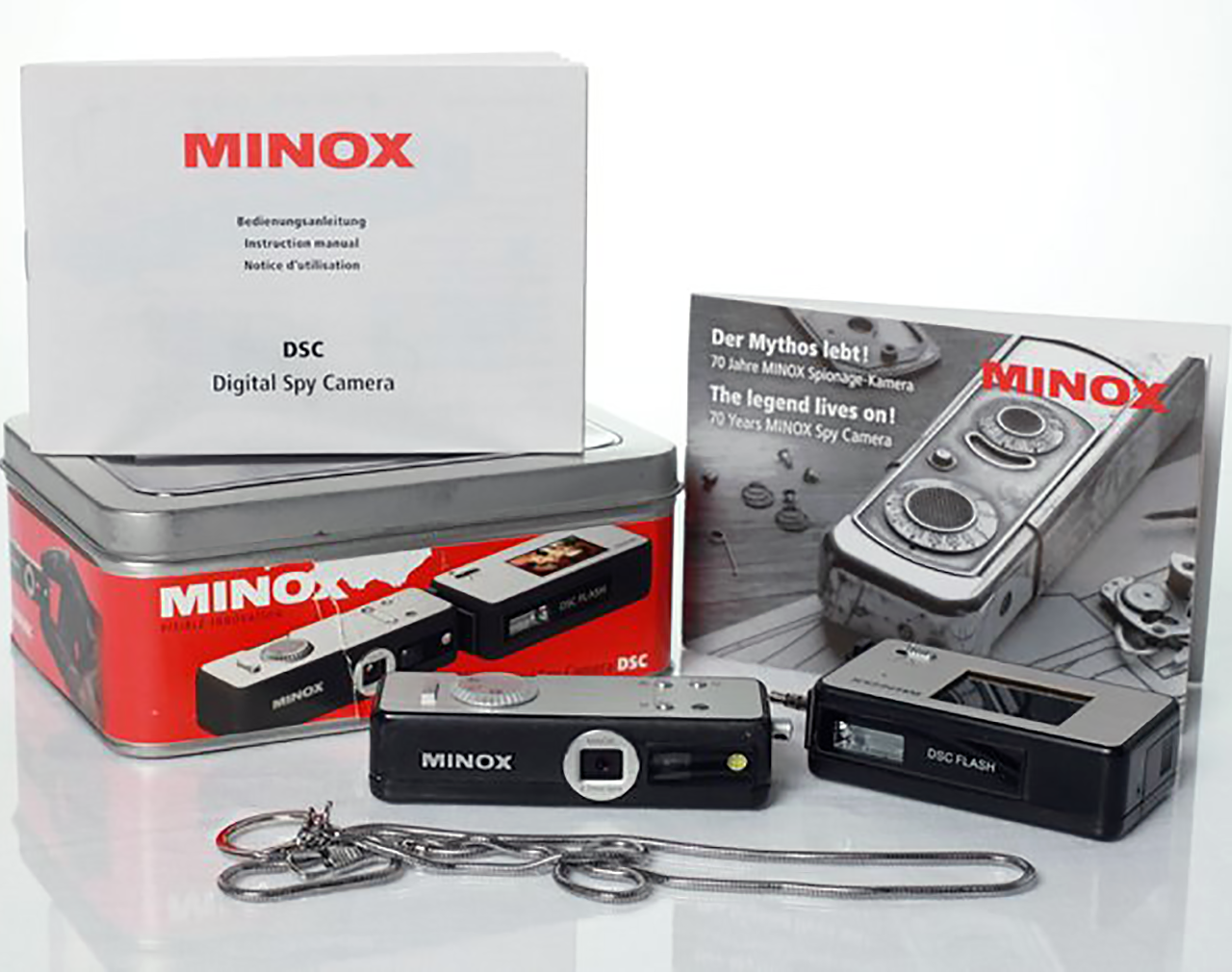
Digital Minox DSC in special metal gift box, complete with flash, neck strap, memory card, charging cable and documentation material.
Below an overview of the various miniature cameras produced by Minox.
- Minox Riga
- Minox A II
- Minox A III
- Minox B
- Minox C
- Minox BL
- Minox LX
- Minox EC
- Minox ECX
- Minox TLX
- Minox CLX
- Minox 35 EL
- Minox DSC
- Minix DSC Silver
FOUNDERS: Ogihara Akira and Ōtsuka Shintarō
COMPANY NAMES:
1947: Orion Seiki Sangyō Y.K. (Orion Precision Products Industries Co., Ltd.); 1955: Orion Camera K.K.; 1957: Miranda Camera K.K.; in 1976 Miranda stopped camera production.
COMPANY ADDRESSES:
Tokyo – Japan; (Allled lmpex Corporotion – 7 West – Zth Street; New York I ; New York 6918-20 Melrose Avenue; Hollywood Colifornia 215 West Ohio Street Chicogo; lllinois.
Miranda cameras were a line of quality 35mm single lens reflexes, a range of over 30 models between first prototypes in 1953 through to the last production model in 1978. Many had advanced or sophisticated features for their day. Almost all Miranda SLR’s shared the same basic lens mount, but the mount complexity increased over the years to accommodate more aperture and metering controls.
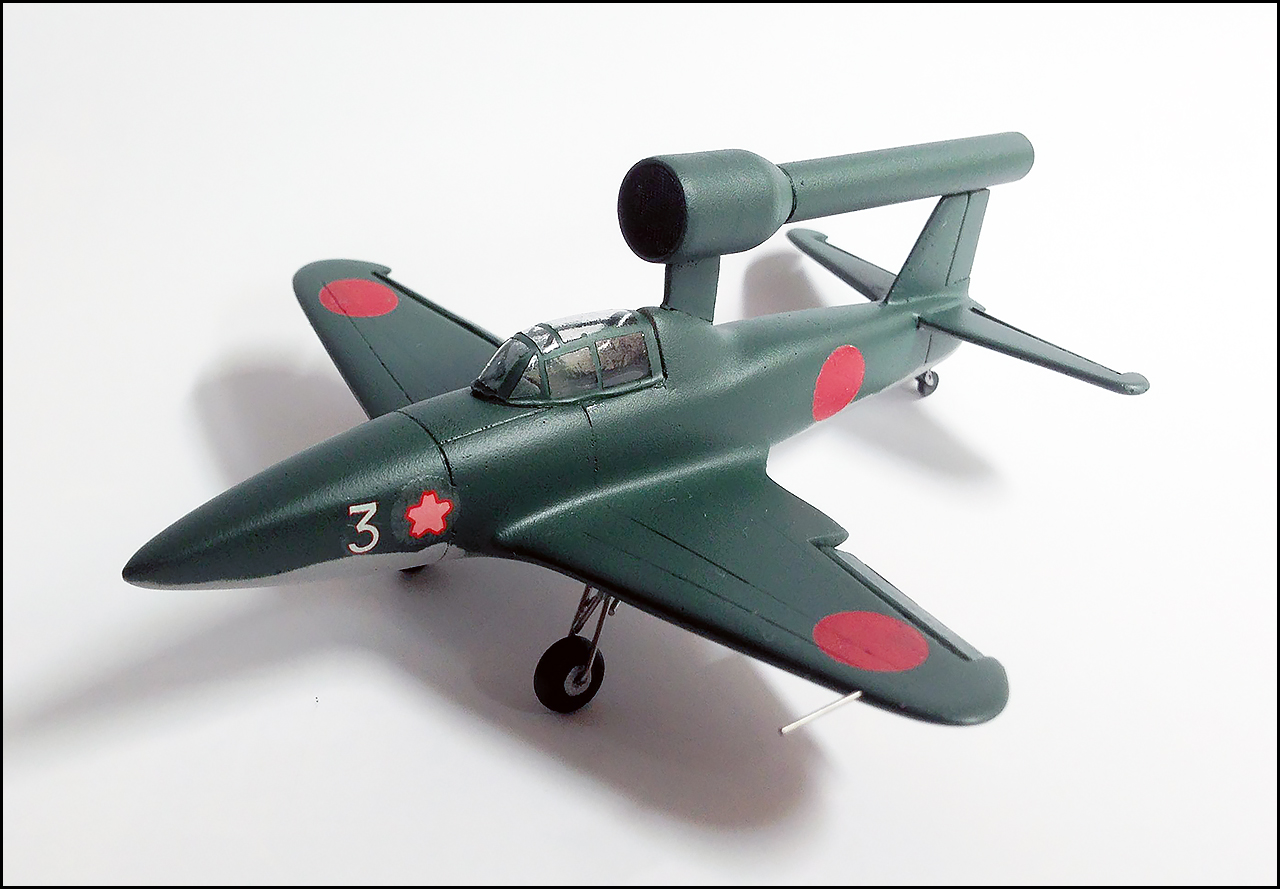
The Japanese Baika Fighter Jet.
From Orion to Miranda
In 1954, the company presented the Phoenix 35mm SLR prototype to the Japanese photographic press. Ogihara and Ōtsuka had been developing an SLR camera for several years, and the Phoenix was mainly developed as a promotional product to advertise their future camera. Ogihara visited various distributors to obtain funds for the development of the production camera, but the only one who accepted was Mikami, who provided financial support.
Orion Seiki was renamed Orion Camera K.K. in 1955, with an equity base of 3 million yen (it seems that the name “Orion Camera Co.” was already in use for some time as an English translation of Orion Seiki). The production SLR was released that same year and named the Miranda T, the first Japanese 35mm SLR camera commercially available with a pentaprism.
 The company finally named itself Miranda Camera K.K. after its main product in 1957. On the Japanese market, the early Mirandas were still distributed by Matsushima for some time, then perhaps by the company itself. The distribution was briefly taken over by Ricoh from early 1959, as prominently announced in early advertisements for the Miranda B. It is said that this decision to join with Miranda was directly made by Ricoh’s founder Ichimura Kiyoshi.
The company finally named itself Miranda Camera K.K. after its main product in 1957. On the Japanese market, the early Mirandas were still distributed by Matsushima for some time, then perhaps by the company itself. The distribution was briefly taken over by Ricoh from early 1959, as prominently announced in early advertisements for the Miranda B. It is said that this decision to join with Miranda was directly made by Ricoh’s founder Ichimura Kiyoshi.

 The agreement was however short-lived: the sales of Miranda cameras abruptly stopped in the domestic market in mid-1959 for an unknown reason, and for a few years Miranda cameras were made only for export.
The agreement was however short-lived: the sales of Miranda cameras abruptly stopped in the domestic market in mid-1959 for an unknown reason, and for a few years Miranda cameras were made only for export.
The US importer by Allied Impex (or AIC), owner of the Soligor brand, notably used on the lenses for the Miranda cameras.
In 1960, the company dropped the original dodecagonal body for a rounded body on the late-model Miranda D. It also released the Automex, with a built-in external selenium meter, and new lenses with internal diaphragm actuation and a cam transmitting the aperture setting to the body for meter coupling.
 The company’s founders were Ogihara Akira and Ōtsuka Shintarō. Ogihara studied aeronautical engineering in the Imperial University of Tokyo (later University of Tokyo) during World War II, and worked on pulse jet engines for the Japanese Navy in the University’s aeronautical research center. He notably developed the pulse jet engine of a manned flying bomb inspired by the German V1, certainly the Ka-10 engine for the Baika. Ōtsuka graduated from the same department one year after Ogihara, and worked on the compressor of the Ne-20 engine for the Kikka jet fighter.
The company’s founders were Ogihara Akira and Ōtsuka Shintarō. Ogihara studied aeronautical engineering in the Imperial University of Tokyo (later University of Tokyo) during World War II, and worked on pulse jet engines for the Japanese Navy in the University’s aeronautical research center. He notably developed the pulse jet engine of a manned flying bomb inspired by the German V1, certainly the Ka-10 engine for the Baika. Ōtsuka graduated from the same department one year after Ogihara, and worked on the compressor of the Ne-20 engine for the Kikka jet fighter.
When the war ended, all military research was halted in Japan, and Ogihara started a small camera workshop in a room of the former aeronautical research centre. He was offering repairs and modifications for professional cameras, notably making Leica mount barrels for older lenses or military camera lenses. At the time, Ōtsuka was working on gas turbines for civilian applications; he soon became aware of Ogihara’s activities and partnered with him.
Ogihara founded the company during the period, under the name Orion Seiki Sangyō Y.K., meaning Orion Precision Products Industries Co., Ltd., perhaps in 1947 — some sources say 1946 but this seems too early.
 The company was named after the constellation of Orion, because Ogihara had a special interest in astronomy. Its early logo consisted of the word ORION with three stars and an arc; the three stars correspond to Orion’s belt, and the arc is often associated with the figure of the mythological hunter Orion in drawing the constellation.
The company was named after the constellation of Orion, because Ogihara had a special interest in astronomy. Its early logo consisted of the word ORION with three stars and an arc; the three stars correspond to Orion’s belt, and the arc is often associated with the figure of the mythological hunter Orion in drawing the constellation.
The company’s first product was the Coupler, an adapter designed by Ōtsuka to use Contax lenses or Nikon lenses on Leica screw mount cameras while keeping the rangefinder coupling.
The next products, released in the early to mid 1950s, were the Mirax reflex housings, Supreme lenses and Focabell bellows. These were first distributed by Summit Shōkai, then by Matsushima, managed by Mikami Makoto. In addition to these early products, it is said that Orion Seiki worked as a subcontractor for Yashima Kōgaku on the production of microscopes.
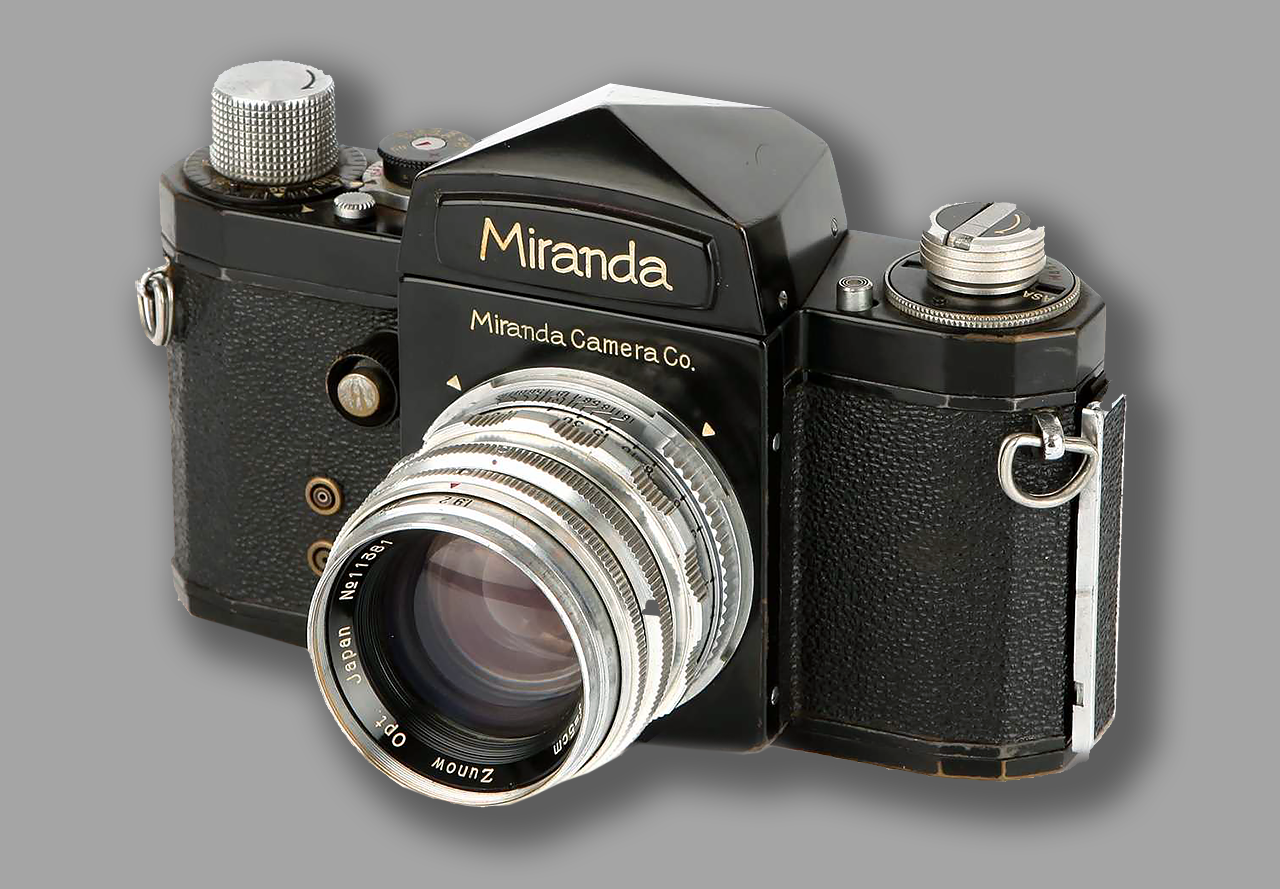
Miranda T, was the first Japanese 35mm SLR camera commercially available with a pentaprism. Several modifications were introduced in the Miranda T, the successor of the Phoenix camera.
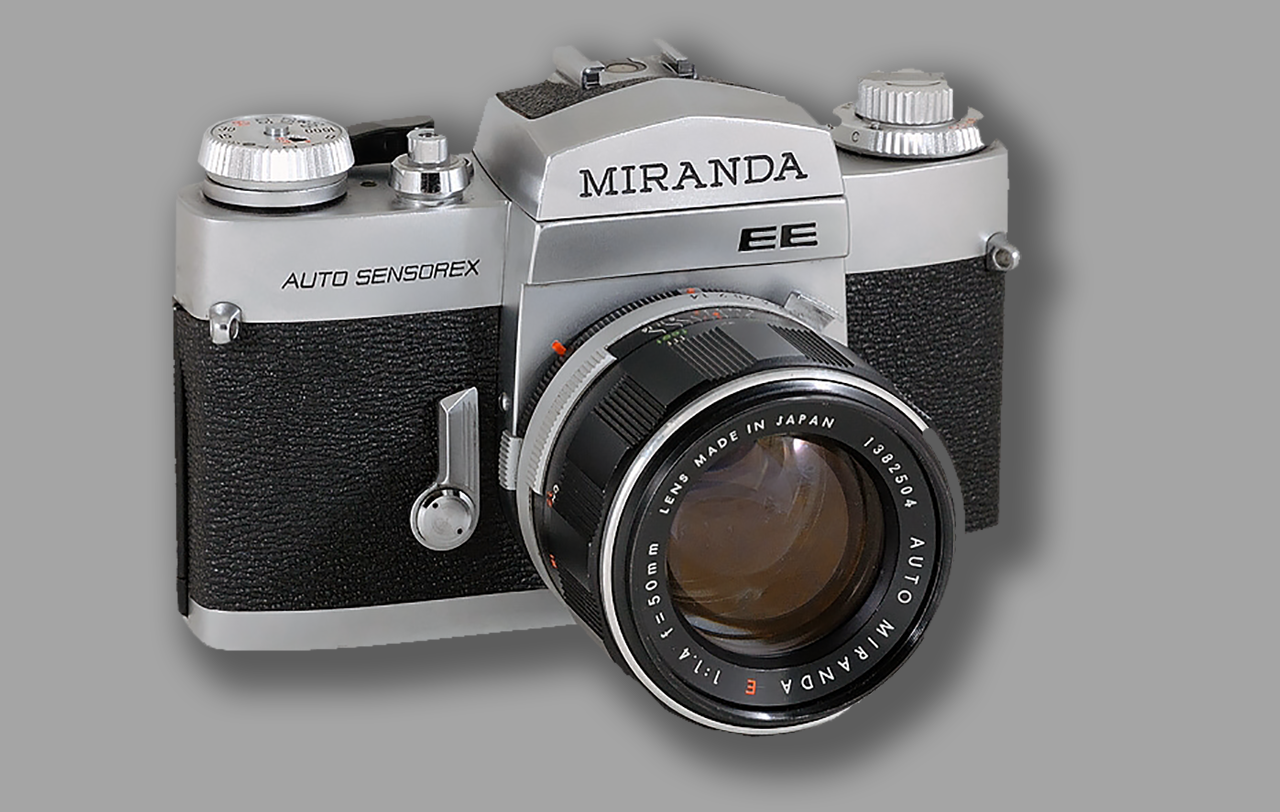
The camera you see here is the Miranda Auto Sensorex EE. It is a shutter-priority, auto exposure 35mm film SLR camera. It was launched in 1971 and was one of the most sophisticated cameras Miranda ever produced.
Later use of the Miranda brand
 After the 1976 bankruptcy of the historical Miranda Camera Company, its brand name was recycled by British retailer Dixons for various house-brand camera equipment.
After the 1976 bankruptcy of the historical Miranda Camera Company, its brand name was recycled by British retailer Dixons for various house-brand camera equipment.
The Miranda MS-1 and Miranda MS-1 Super are two models of 35mm SLR offered in the early 1980s, simply being rebadged versions of the Cosina CT1G and Cosina CT1 Super, respectively. The MS-1 lacks a self-timer and its top shutter speed is limited to 1/1000 sec., while the “Super” offers 1/2000. The model badging has been observed in a few different styles.
The Miranda MS-1N has a 1/2000 second top shutter speed, but lacks the self-timer of the “Super”; it is slightly restyled and was apparently sold in graphite grey only. It appears to be a rebadging of the closely-related Cosina CT1EX.
Both feature Pentax K lens mounts, and manual exposure settings using a three-LED meter display at the side of the viewfinder illuminated with a half press on the shutter release. Two LR44 or SR44 cells power the meter circuit, but the mechanical shutter functions at all speeds without battery power. The camera’s shutter and meter circuit are locked until the film wind lever is pulled outwards to its standoff position.
As of May 2011, Dixons Retail (later merged into Dixons Carphone which in turn became today’s Currys plc) still had the rights to the brand in several countries but no longer used it and planned to sell the brand off.
Into Allied Impex
It is said that the Miranda company set up its own lens factory in 1963 (earlier lenses were supplied by various manufacturers, except for the first Supreme). The company returned to the Japanese market in autumn 1964, but the US importer Allied Impex gradually took control, and fully owned the company by the late 1960s.
The Sensorex model was released in 1967, with TTL exposure metering. It is said that a new factory was opened outside Tokyo in 1970 or perhaps 1971. In 1971, the company introduced the Sensorex EE with shutter-priority automatic exposure and a new set of viewfinders. Upgraded as the EE-2 in 1976, it would be the last Miranda with interchangeable viewfinder.
In 1972, the company released its only non-SLR camera, the Sensoret compact rangefinder. In 1975, it made an attempt at a compact SLR with fixed prism and electronically controlled shutter, called the Miranda dx-3. Neither of these met with great success.
Unable to keep up with the increasing manufacturing automation of the larger manufacturers, and the increasingly sophisticated electronics of competing cameras, Miranda went bankrupt on December 10, 1976 and stopped camera production the same month.
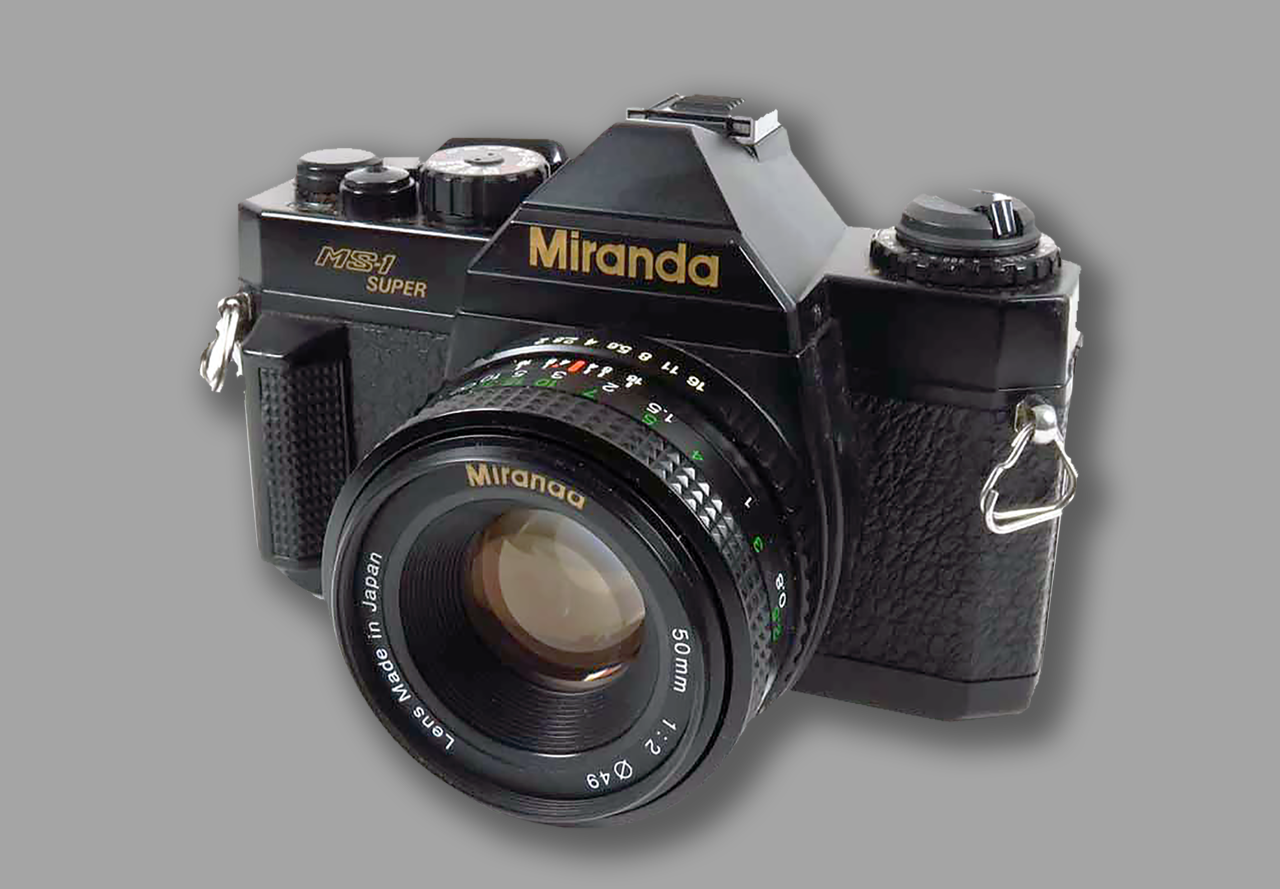
After the 1976 bankruptcy of the historical Miranda Camera Company, its brand name was recycled by British retailer Dixons for various house-brand camera equipment. The Miranda MS-1 and Miranda MS-1 Super are two models of 35mm SLR offered in the early 1980s, simply being rebadged versions of the Cosina CT1G and Cosina CT1 Super, respectively.
products made by Orion or Miranda Camera:
Early products by Orion and Miranda have six-digit serial numbers. The first two look as if they might indicate the year of production, but this is misleading: they might be related to the release year of the camera model or device, but do not give a precise indication of the production year of the particular example.
- Miranda A, AII
- Miranda Automex I, II
- Miranda Automex III
- Miranda B, C
- Miranda D (angled body, then rounded body)
- Miranda dx-3
- Miranda DR
- Miranda EE-2
- Miranda F (two models)
- Miranda FM
- Miranda Fv, FvT
- Miranda G
- Miranda GT
- Miranda Laborec
- Miranda Laborec III
- Miranda Pallas TM
- Miranda Pallas TM-II
- Miranda RE-II
- Miranda S
- Miranda Sensomat
- Miranda Sensomat RE
- Miranda Sensomat RE-II
- Miranda Sensomat RS
- Miranda Sensorex, Sensorex C
- Miranda Sensorex II
- Miranda Sensorex EE
- Miranda 35sf
- Miranda ST
- Miranda T and TII (including the early versions marked “Orion Camera Co.”)
- Miranda TM / Soligor TM
- Mirax Laborec
- Mirax Laborec II
- Mirax Laborec III
- Mirax Laborec Electro-D
- Miranda MS-1
- Miranda MS-2
- Miranda MS-3
- Miranda Memoflex
- Miranda Sensoret / Soligor Sensoret
- Miranda 35AF (similar to Konica 35AF)
- Miranda A-X
- Miranda MDS-1
- Miranda Sharp Shooter
- Miranda Solo Twin
The Orion Six was made in the second half of the 1950s by a company called Orion Seiki, perhaps a successor of Kyōwa Kōki. This company was probably not related to Miranda’s predecessor, but perhaps adopted the Orion name to draw on the good reputation of Orion/Miranda products.
- Mirax reflex housing, and Mirroscope and Mirabox name variants
- Focabell bellows system
- Supreme lenses
- Supreme and Cine-Noctar cine lenses
- Orion Coupler, to adapt Contax or Nikon lenses on Leica screw mount cameras
- various lenses to 44mm screw mount, for the Mirax, Focabell or SLR cameras
- 44mm screw mount to Exakta or Visoflex
- various lenses to Miranda bayonet
- Leica screw lenses to C-mount cine cameras (c.1955–8, ¥750);
- Leica screw lenses to D-mount cine cameras (c.1955–8, ¥1,000);
- Leica screw lenses to Filmo 127 and 134 cine cameras (c.1958);
- microscope adapter for Mirax or Miranda (¥3,500 in 1955);
- microscope adapter for Exakta (¥5,000 in 1955);
- extension tubes for Mirax or Miranda (¥2,000 in 1955);
- extension tubes for Exakta (set of five, ¥5,850 in 1955);
- adjustable extension tube for Leica (from 40mm to 59mm);
- tester for C-mount or D-mount lenses, for use with both eyes (c.1953).
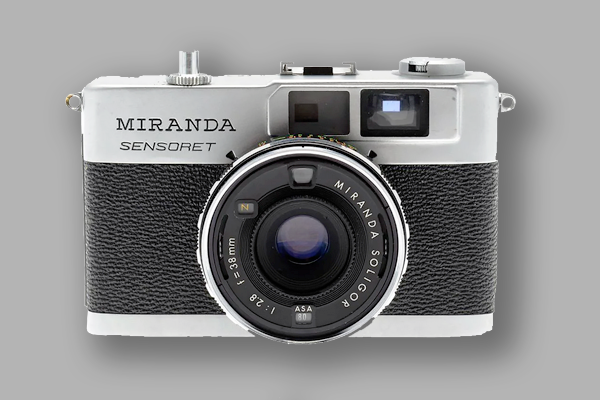
The Miranda Sensoret is small rangefinder camera introduced in 1972. It has fixed 38mm f/2.8 Miranda Soligor lens with fully automatic exposure controlled by the Seiko ESF shutter.
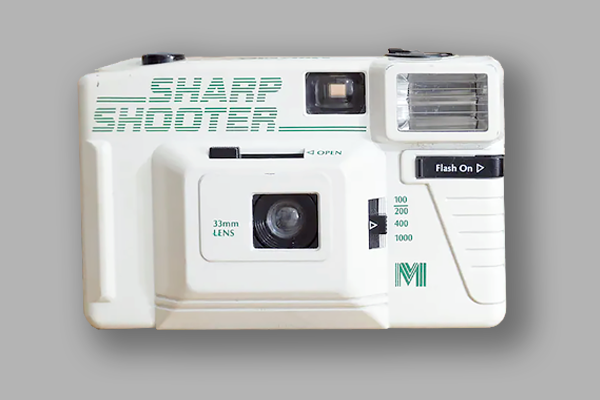
Made in Thailand for Miranda, this compact camera is unusual looking, but is fairly simple in usage. It takes 35mm film and has a 33mm lens with fixed focus. Possibly made by Halina, as it is functionally equivalent and looks very similar to the Halina 260.
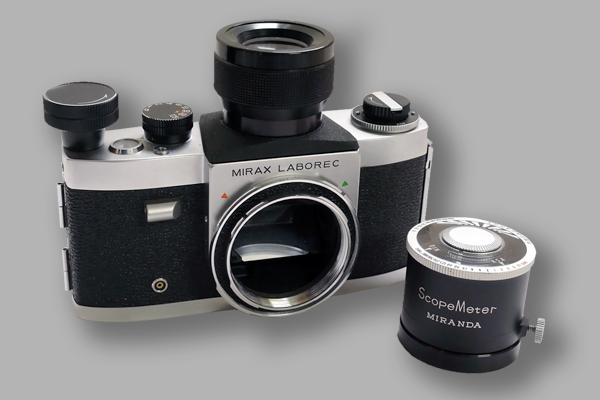
NAMED AFTER: the Soviet physicist Sergey Ivanovich Vavilov
COMPANY NAMES:
1957: MMZ Minskiy Mechanichesckiy Zavod imeni S.I. Vavilova (Minsk Mechanical Factory); 1971: BelOMO Belorusskoe Optiko-Mechanichesckoye Obyedinenie (Belorussian Optical and Mechanical Association).
COMPANY ADDRESS:
Minsk, 23 Makayonok Street.
As the Association, BelOMO took the leading position in the optical industry sector of the former USSR and included the following plants:
- • BelOMO (Minsk) – former Minsk Mechanical Works. It produced very sophisticated optical equipment like topographic and space equipment and systems, sights used for armored vehicles, laser-targeting apparatus and so on
- • “Diaprojector” (Rogachev) – produced different sighting and guidance apparatus, as well as slide projectors
- • “Zenit” (Vileyka) – produced cameras and scope sights used with small arms weapons
- • “Svet” (Zhlobin) – had such production as enlarging machines, reproduction equipment and optical equipment.
- • LEMT (Minsk) – this unitary enterprise was established in the 90s and specialized in producing medical instruments and laser equipment.
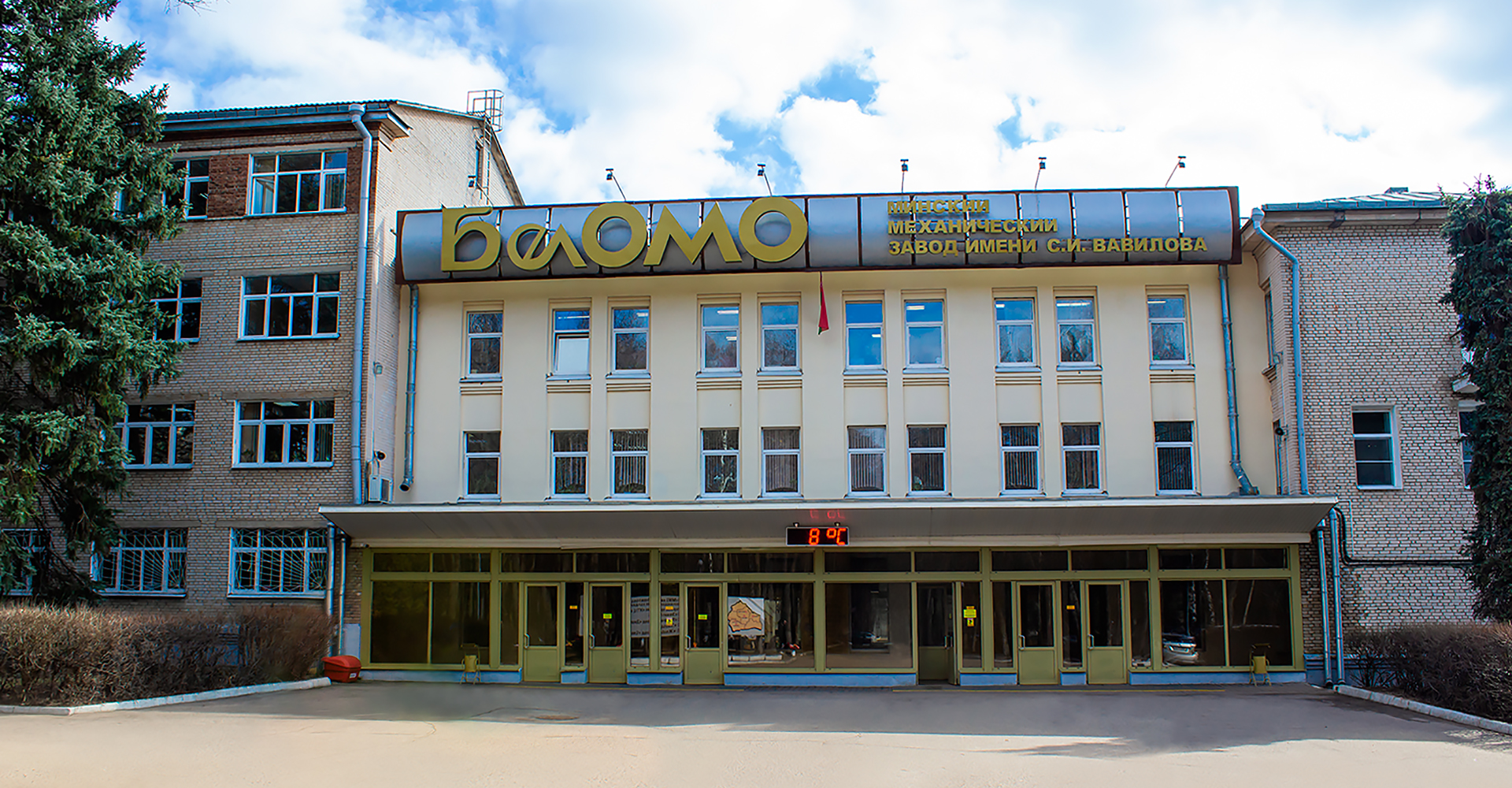
The Headquarters of BELOMO in Minsk.
BelOMO enjoyed leading position in the former USSR optics markets providing civil and military industry-specific solutions. The partnering plants specialized in specific equipment manufacturing.
Minsk Vavilov Machinery Plant offered a full range of high-complex opto-mechanical and electro-optical devices, including products for aerospace industry.
Zenith factory located in Vileika was the only camera manufacturer in the former USSR. Peleng series automatic slide projectors were fabricated in Rogachyov Diaproektor works in Rogachev. The plant Svet located in Zhlobin offered image reproduction equipment and photo enlargers.
To date the Belorussian Opto-Mechanical Association employs more than 5,000 highly qualified professionals. The BelOMO factories occupy territory of about 220,000 m2 with more than 52,000 m2 of workshops areas.
cameras
- Agat 18
- Agat 18K
- Chajka series
- Elikon 2
- Elikon 3
- Elikon 4
- Elikon 35C
- Elikon 35CM
- Elikon 535
- Elikon Automat
- Elikon Autofocus (Clone of the Konica C35AF)
cameras
- Estafeta
- Etude
- Lomo LK-A
- Orion EE
- Siluet Elektro
- Shkolnik
- Smena
- Smena-2
- Vesna
- Vilia
- Vilia-Auto
Lenses
- MC Peleng 3.5/8 Fisheye
- EWP Fisheye Lens 3.5/8
- MS 2.8/17
Flashes
- Peleng
Mini slide viewers
- Ogonyok
- Ogonyok 2
- Ogonyok 4
- Ogonyok 5
 MMZ Minsk Vavilov Machinery Plant (Minsk Mechanical Factory) was founded in 1957. It started making optical glass and producing cameras that were developed by GOMZ. As its product offering and production volumes expanded a Belorussian Opto-Mechanical Association (BelOMO) was formed on its manufacturing facilities in 1971. It was based in Minsk, the capital of the former Soviet republic Belarus.
MMZ Minsk Vavilov Machinery Plant (Minsk Mechanical Factory) was founded in 1957. It started making optical glass and producing cameras that were developed by GOMZ. As its product offering and production volumes expanded a Belorussian Opto-Mechanical Association (BelOMO) was formed on its manufacturing facilities in 1971. It was based in Minsk, the capital of the former Soviet republic Belarus.
At first, BelOMO made photographic equipment and lens-making machinery for state use. It now manufactures a wide range of products, including military and consumer optical products.
During the 1980s it produced the Agat-18 and Agat-18K half-frame 35mm cameras, still popular among Lomographic photographers. Its unique camera product was the Chaika half-frame camera.
A joint venture with German optics maker Zeiss was begun in 1995. The firm produces lenses and optical elements for microscopes and other optical equipment with ISO 9001 certification.
MMZ-BelOMO factory estimates its global market share in optical sights, rangefinders and NVDs at 2-3%, with 10% of Russian market and 80% of local market. The factory also produces gas meters, car units, infra-red emitters, juicers and other civil products.
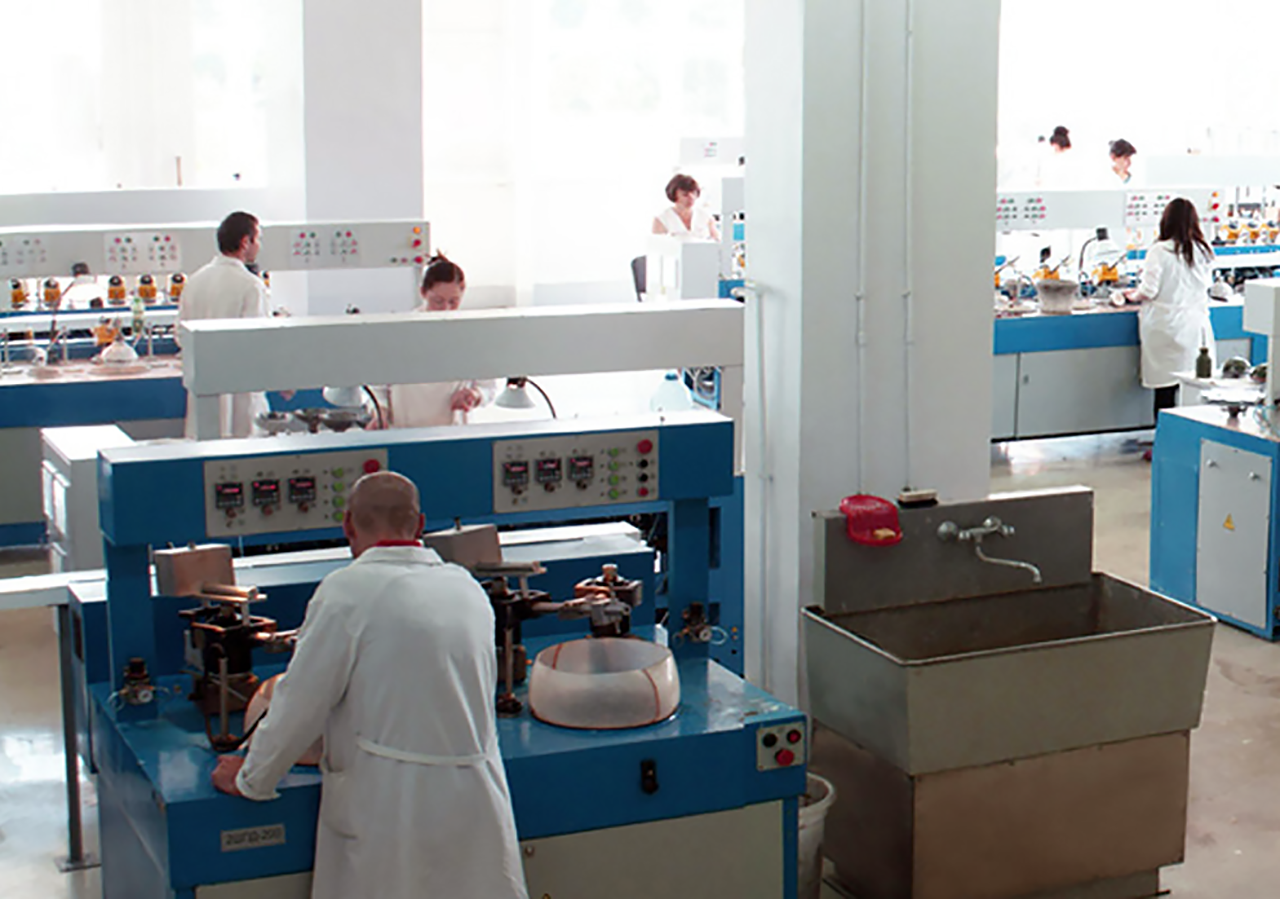
Manufacturing Optics in the Belomo Factory.
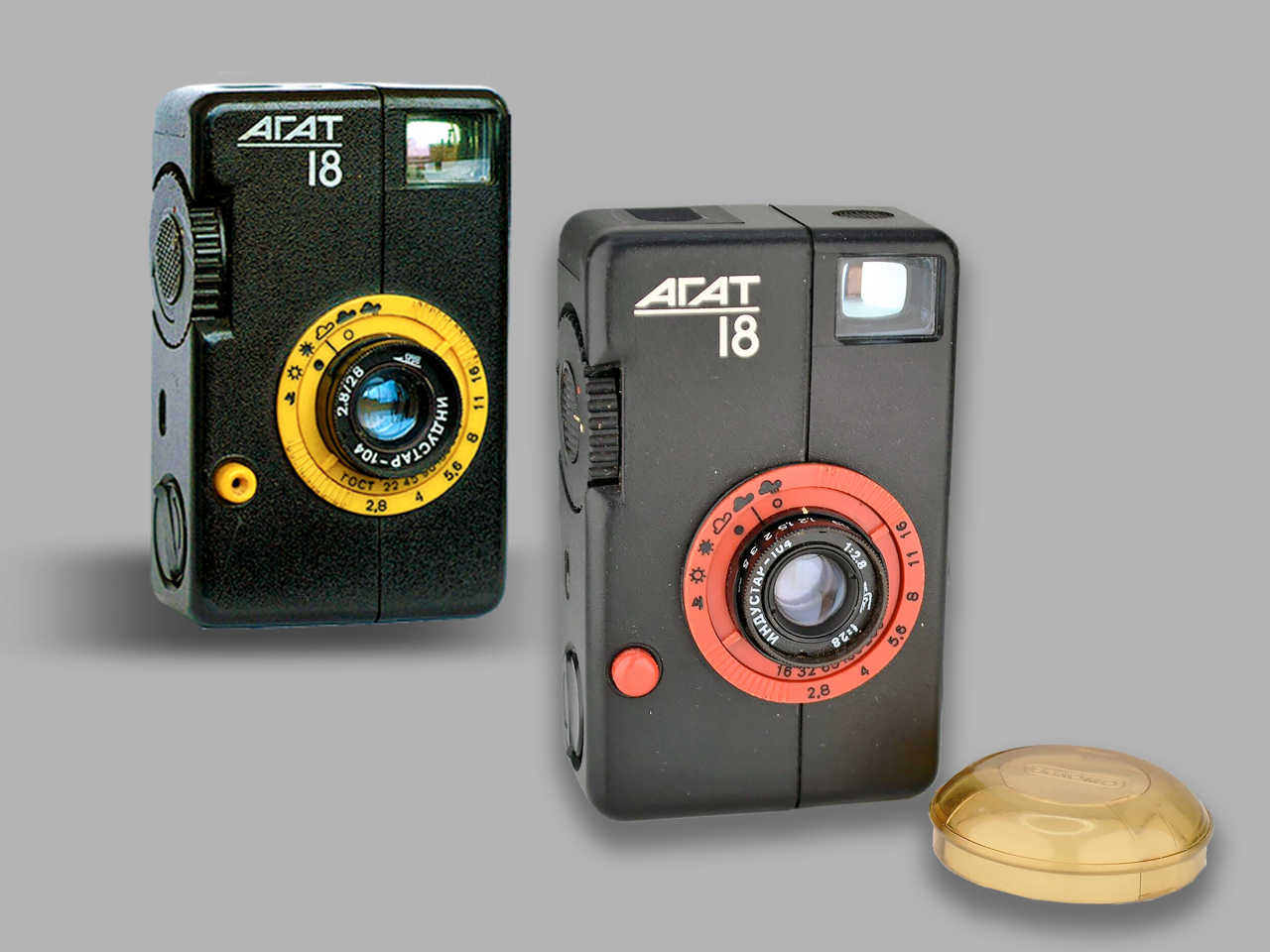
The Agat 18 is a small cheap all plastic Soviet-made half frame 35mm viewfinder camera produced by MMZ and later Vilejka for MMZ (Belomo) in Minsk, Belarus between 1983-1991.
This Soviet camera, and its successor, the Agat 18K, are touted as some of the smallest and lightest half-frame cameras ever made.
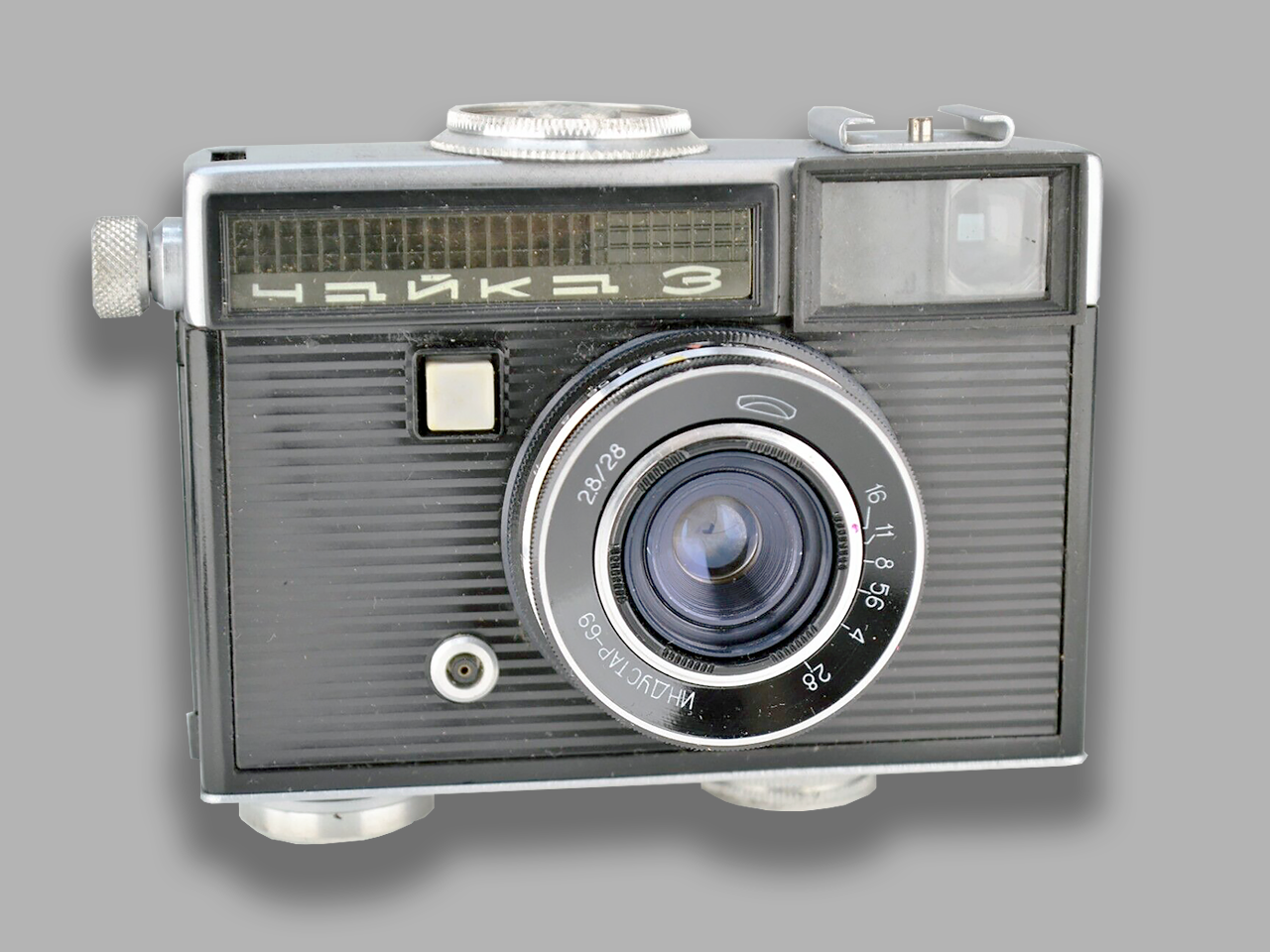
The Chaika 3 was a half-frame camera for 135 film, built between 1963 and 1973 by MMZ/BelOMO in Belarus. It is a manual half frame viewfinder camera. Beside the plastic covers on front and back, it is fully made of metal.
The camera measures the light without batteries, using a selenium light meter above the lens. A mechanical calculator on top of the camera helps to calculate the right aperture.
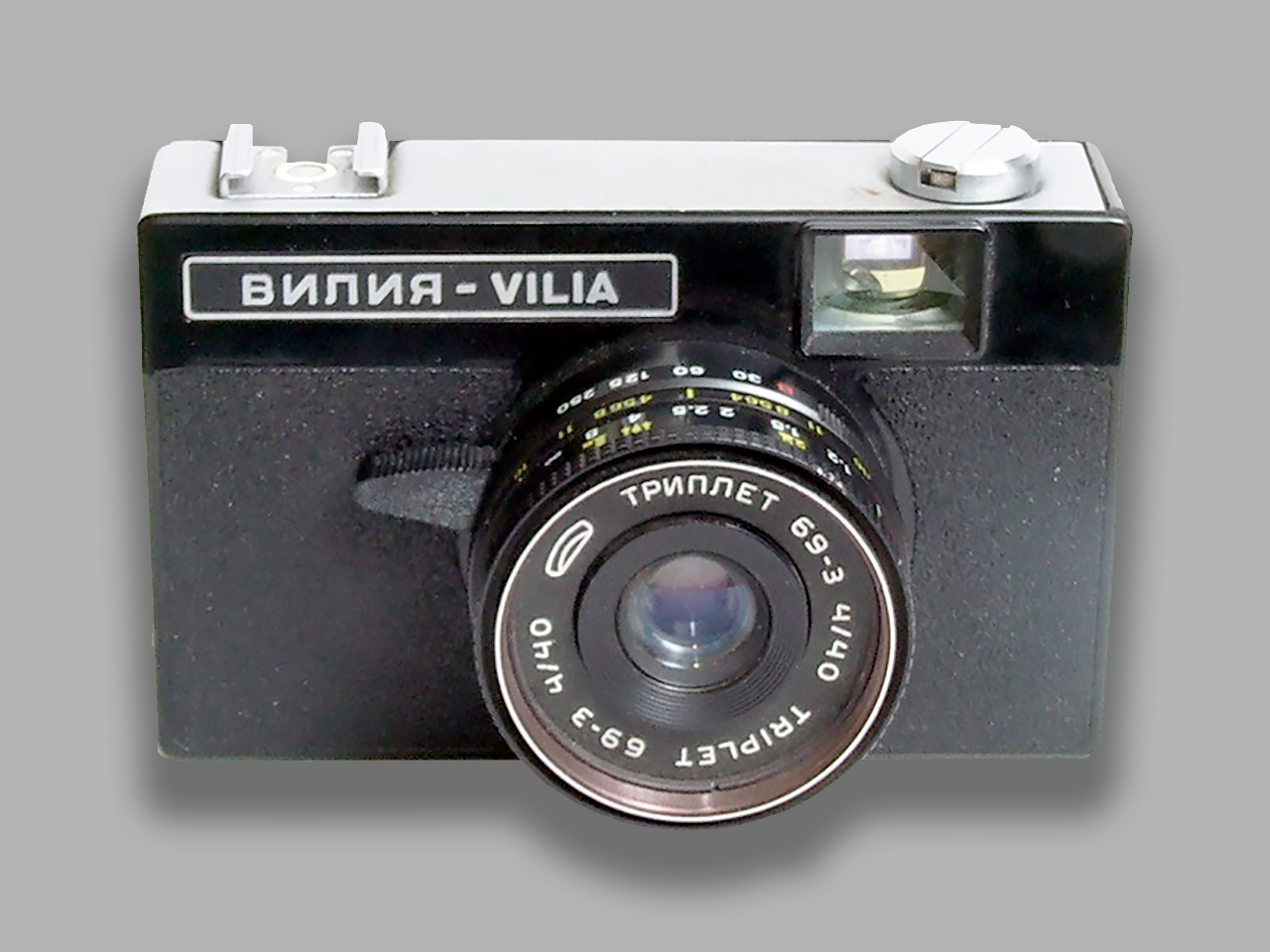
Vilia is a 35mm film viewfinder camera produced between 1973-86 with quantity of about 2.000.000 units. Vilia is a river flowing through Belorussia and Lithuania. Vilia is equipped with symbolic system of exposure setting. There are 4 types and 7 sub-types of the camera. A further developments of the Vilia, using the same body and lens, were the Vilia-Auto, this time equipped with automatic exposure setting based on a selenium meter.
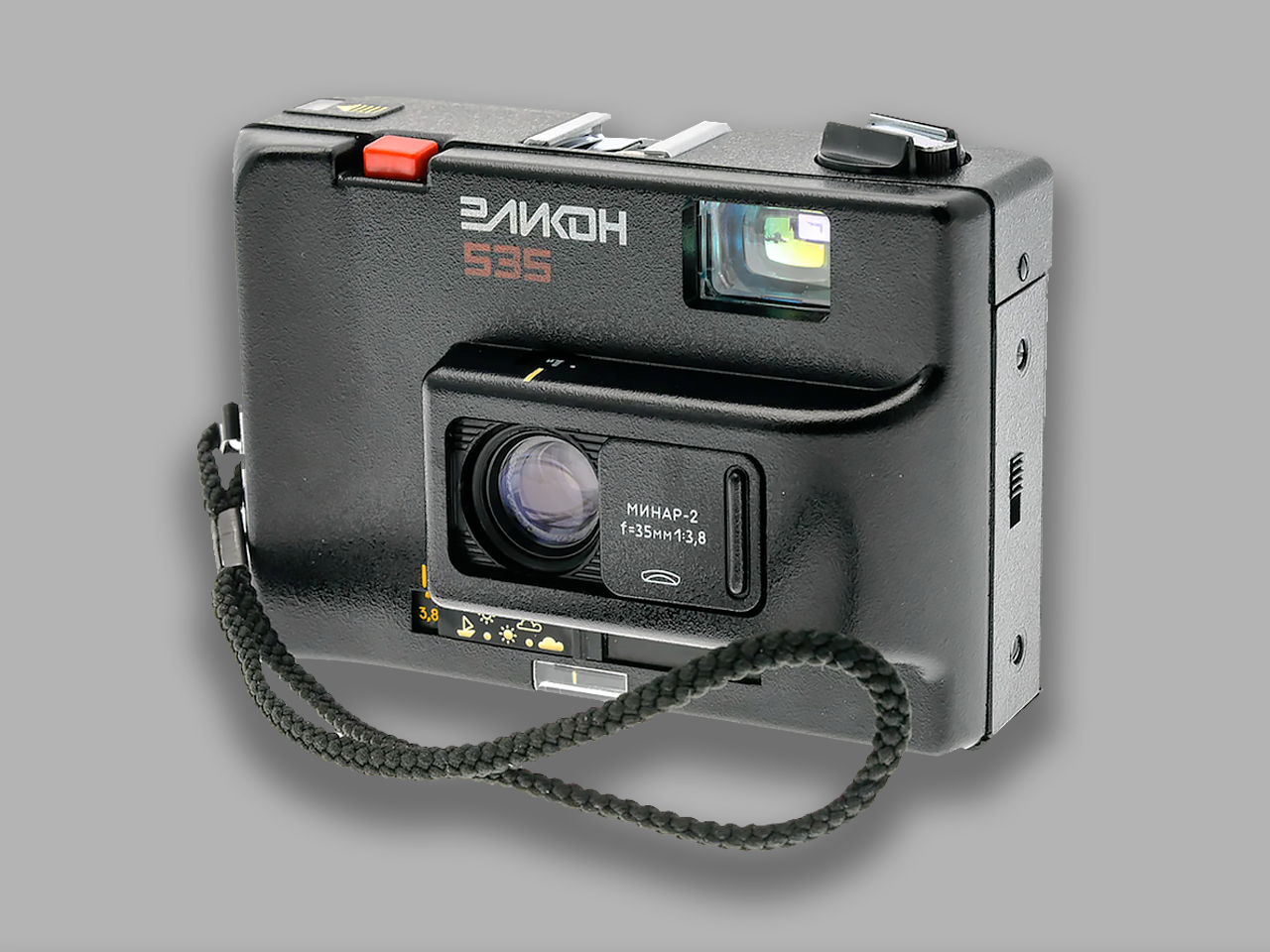
The Elikon 535 is a 35mm manual focus point and shoot camera that was made by Vilejka for MMZ introduced in 1990. The prototype version, with a rather different design, was called Elikon 5. It’s a compact camera but fully manual with a Zone focused Minar-2 f3.8/35mm lens and exposure calculator. It has a sliding lens cover that locks the shutter.It is found in black and grey color versions.
FOUNDER: Mr. Motodori
COMPANY NAMES:
1937: Motodori Shashin Kikai Kōgyō-sho; 1938: Victor Camera Works (this name was probably used for commercial and advertising purposes only); 1940/1941: the name Condor Camera Works was used in the advertisements; 1943: Motodori Kōgaku Kikai Kōgyō-sho; 1950: Tōkyō Seiki K.K.; 1955: Doris Camera K.K.; 1957: Condor Camera K.K.; 1959: the remaining stocks were cleared.
COMPANY ADDRESSES:
1937: Toshima-ku Ikebukuro 1–606; 1950: Tokiwadai (Tokyo);
This company description traces the history of a Japanese company which took many different names from Motodori to Condor Camera.
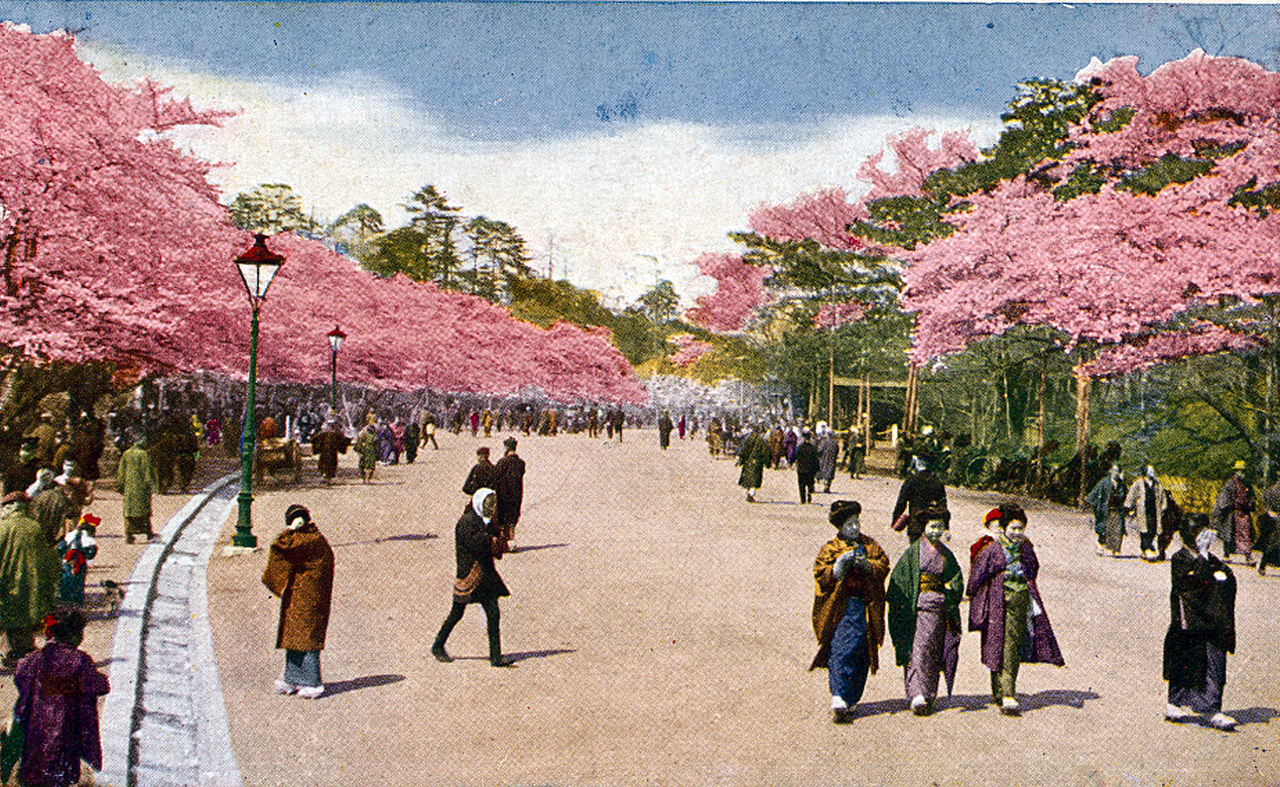
Before Tokyo matured into the gleaming, dense city it is today, it was a small fishing village called Edo. This Picture postcard gives an impression of the cherry blossoms at Ueno Park (Flower Season at Edo/Tokyo).
DURING WORLDWAR II
In 1940 and 1941, the name “Condor Camera Works”, written in Roman letters, was used in the advertisements, together with the same postal box address as before. This was certainly a dummy name again. The production of the Condor line continued until at least 1942.
The official price list dated November 1941 attributes the Victor, Condor and Zeitax cameras to “Motodori Kōgaku”.
The government inquiry listing Japanese camera production as of April 1943 mentions the companies Motodori Kōgaku Kikai Kōgyō-sho and Tokiwa Kōgaku at the same address: Toshima-ku Ikebukuro 1–606 in Tokyo. Tokiwa Kōgaku appears in some advertisements dated 1942 and 1943 as the maker of the Zeitax II and III, mentioning the same address. The company was obvious closely connected to Motodori, but the exact nature of their relationship is unknown.
The Semi Mulber 4.5×6 folder is also attributed to Motodori in the same government inquiry, as well as the Rifax 75/3.5 and Mulber 75/3.5 3-element lenses mounted on it.
PREWAR TIME
The company’s first records are advertisements dated 1937, showing the name Motodori Shashin Kikai Kōgyō-sho. The company was based in Tokyo, Ikebukuro and made Baldax copies called Semi Lester and later Victor.
In 1938, the name “Victor Camera Works” was used in advertisements, together with the address of a postal box. This English-sounding name was probably used for commercial and advertising purposes only, like most other prewar names ending in “Camera Works”, and it was certainly not the name of any actual company (see Camera Works).
In 1939, the Semi Victor and Victor Six and their successors the Semi Condor and Condor Six were advertised by a company called Nissan Kōgaku Kōgyōsha, with a different address. Its name sounds like a manufacturing company but the nature of its relationship with Motodori is unknown.
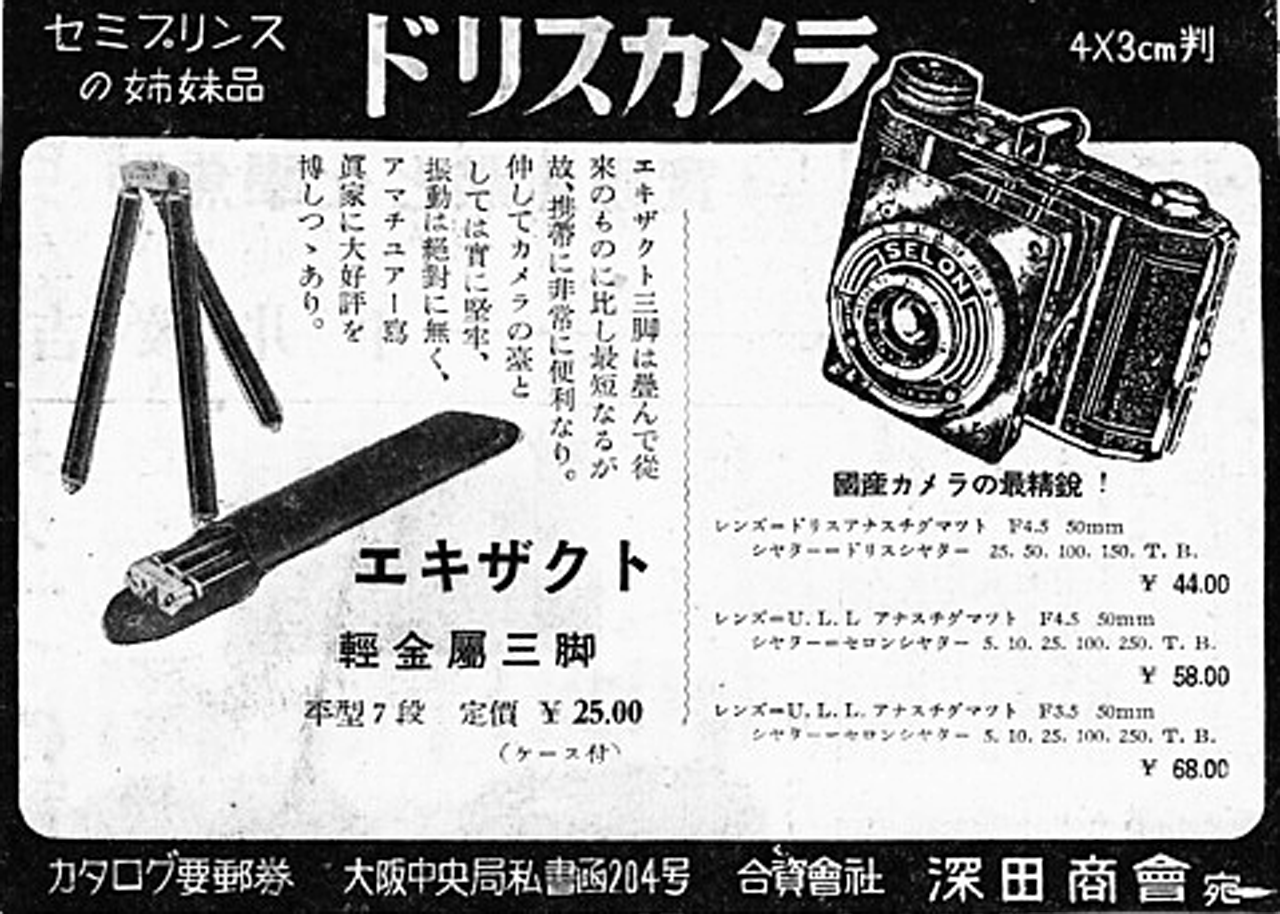
A Japanese advertisement of an early Doris folder from the early period of the Motodori company.
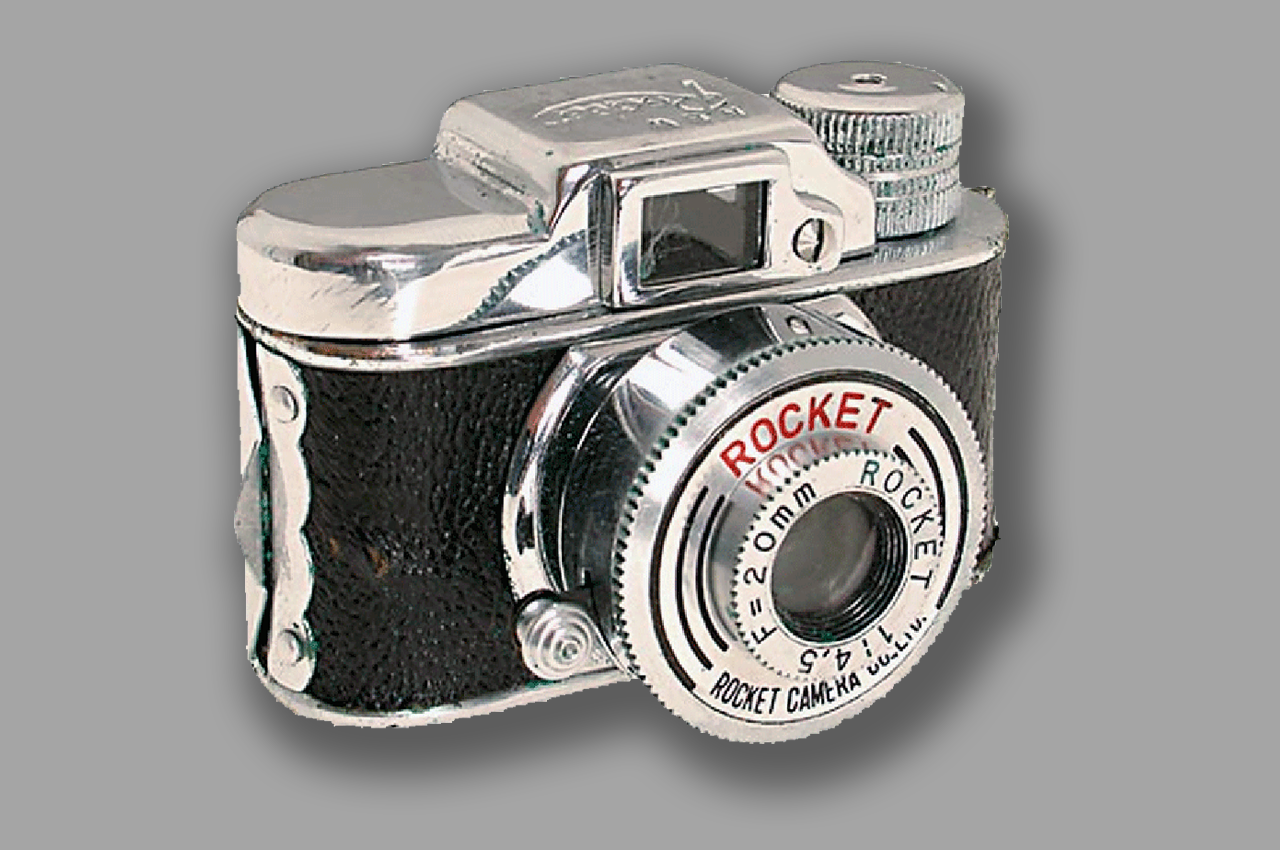
The New Rocket camera was made in the late 1940s or early 1950s by Tōkyō Seiki and perhaps by a Rocket Camera Co. The cameras are engraved “New Rocket” on the top plate and some on the front face-plate. Additionally some are marked “MADE IN OCCUPIED JAPAN”. It was a slightly better made than the average Hit-type subminiature camera that produced 14 x 14 mm exposures. It was available in both chrome and gold finish. The gold finish increases the value by 50%.
Again a new name
In 1957, the company had changed its name again to Condor Camera K.K., using the Condor name again. The address was still the same. It made a 35mm rangefinder camera called Condor, externally a close copy of the Nikon S2. The internals of the two cameras are very different: the Condor has a leaf-shutter and a fixed lens while the Nikon has a focal plane shutter and a bayonet mount. It seems that this camera soon caused a controversy with Nippon Kōgaku and that the company was forced to alter the design, that became the Condor 2S, V2 and IIIS.
We should keep in mind that the Nikon S2 itself was happily mixing design elements copied from the prewar Contax II and postwar Contax IIa. This was used by Condor Camera for its own defence: in a column of Asahi Camera dated June 1957, the company said that the Contax had been taken as a model and that the Condor was being developed for three years (implying that the first prototypes were thus made before the S2 publicly appeared).
The company also gave as an excuse the fact that, being a small company, it had no designer and was forced to get inspiration from the models of other makers. Indeed the earlier Doris 4.5×6 folder already showed some design similarity with the Pearl, while the prewar Lester, Victor and Condor folders were exact copies of the German Baldax.
It seems that the company was even accused of dismantling a Nikon S2 to duplicate the die cast body, to which the company answered that it had paid hard money to have the die-casting moulds specially made for the Condor.
The Condor IIIS and perhaps the V2 have a nameplate marked Sanyo Kōgaku-Kikai Co., Ltd. It is not known if Condor Camera was bought by this company or if it voluntarily changed its name once more. It is not known either if this Sanyo is related to the well-known company Sanyō Denki. An 8mm movie camera called Azomax Model 8A displays the same logo and company name, it was perhaps one of the last products of the company.
The last reference found to the Condor is dated 1959, and it seems that the remaining stocks were cleared under retailer brands such as Avigo or Rafuray.
POSTWAR TIME
The company appeared again in the early 1950s as Tōkyō Seiki K.K., based in Tokiwadai (Tokyo). It made the Semi Rocket 4.5×6 folder in 1951 and 1952, as well as its Convex shutters and Perfa lenses.
The company also made the New Rocket subminiature camera at an unknown date, aping the New Midget. The latter camera sometimes displays the company name “Rocket Camera Co., Ltd.”, which might be a dummy name, perpetuating the tradition inaugurated with “Victor Camera Works” or “Condor Camera Works”, or might be the name of the importer of the camera into the United States.
From 1952, the company made another 4.5×6 folder called Doris, essentially a viewfinder-only version of the Semi Rocket. It is said that this name comes from a Mr Motodori: “Dori’s camera”, thus “Doris”.
The original name Motodori Shashin Kikai Kōgyō-sho strongly suggests that this Mr Motodori was the founder of the company. (Between 1939 and 1943, two 3×4 cameras called Doris and Baby Doris were distributed by Fukada Shōkai. It seems that the Baby Doris was made by Shinkō, and it is not known if they were related with the postwar camera.)
By 1955, the company had been renamed Doris Camera K.K. , keeping the same address. The range of models was extended with the Dorisflex TLR and the Doris Six 6×6 folder.
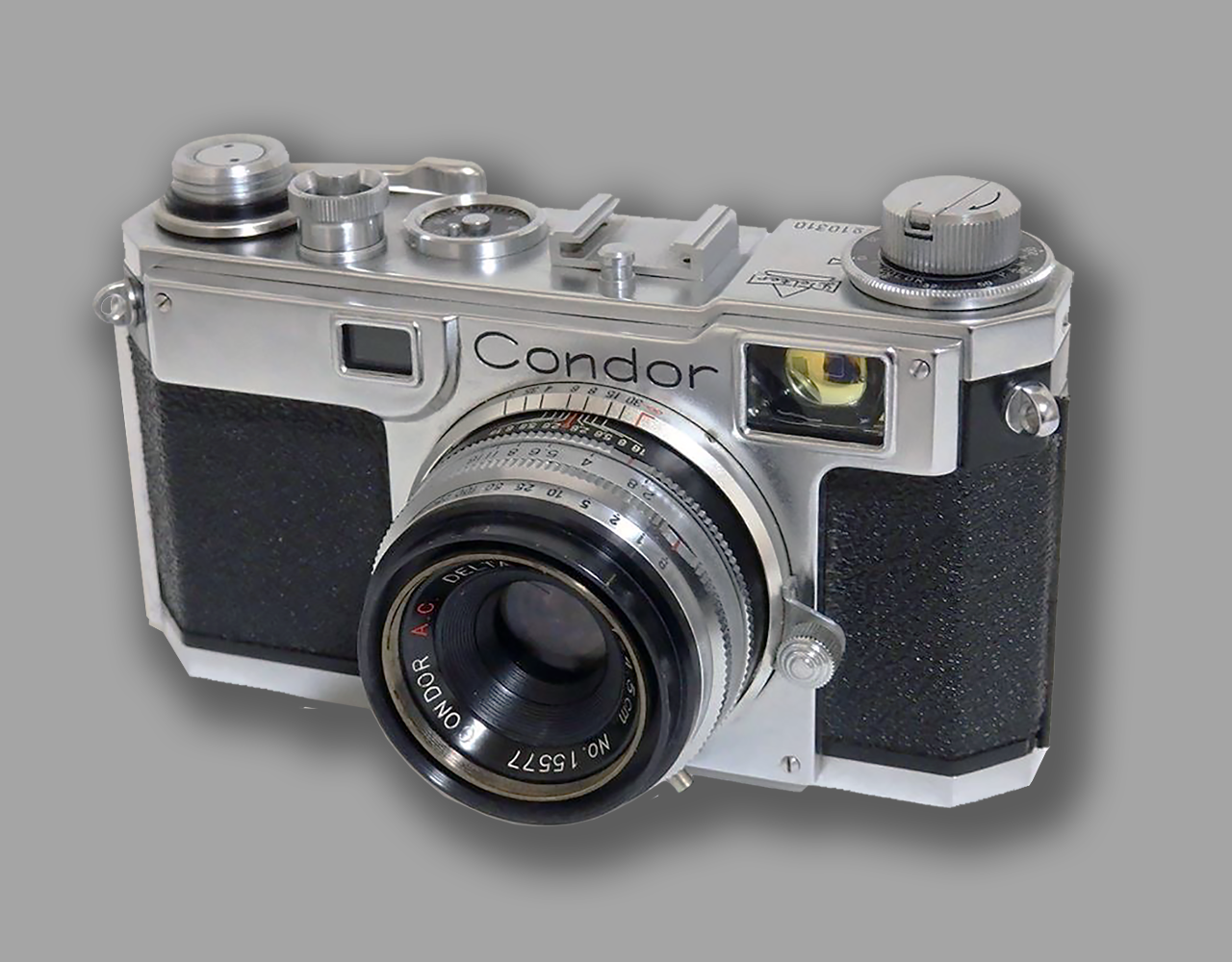
The Condor is a Japanese 35mm rangefinder series, made by the company Condor Camera between 1957 and 1959. The Rafuray and Avigo are less expensive rebadged versions, only equipped with a viewfinder. The original model of the Condor is a close copy of the Nikon S2, at least in its external aspect. Its internals are quite different from the Nikon S2 and less refined: the lens is fixed and it is mounted in a leaf shutter. The obvious copying by Condor of the Nikon S2 raised an immediate controversy in the Japanese public, a sign that times were changing and that shamelessly copying another maker’s model was no longer an accepted practice.
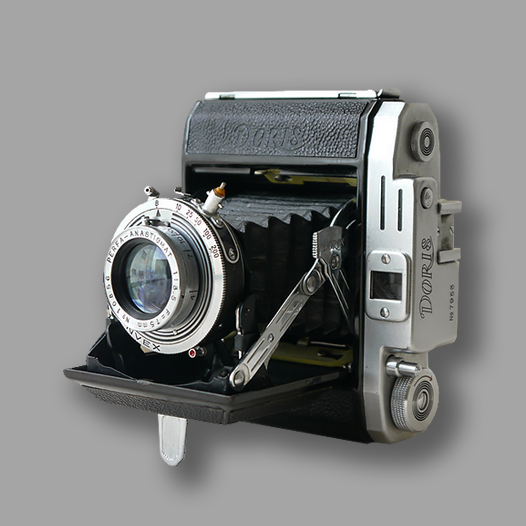
The folding Doris-P viewfinder camera from 1952-1954 is a simplified Doris for 120 film, 4.5x6cm exposures. The Doris-P was advertised in Japan from November 1952 to January 1954. The Semi Rocket and Doris are Japanese 4.5×6 folding cameras made between 1952 and 1955 by Tōkyō Seiki, later Doris Camera. The Semi Rocket and Doris are vertical folders. The viewfinder is contained in a top housing. The Doris-P is a cheaper model. Its appearance is similar except that the depth-of-field dial is replaced by a smaller decorative flange.
- Auto Victor
- Semi Lester (1937)
- Victor and Semi Victor
- Semi Condor and New Semi Condor
- Zeitax
- Semi Rocket
- Doris, Doris-P, Doris II and Doris IA
The attribution of the Zeitax is unsure.
The second version of the Semi Mulber, distributed by Kuwata, was reportedly made by Motodori
- Victor Six
- Condor Six
- Centre Six
- Doris Six
- Doris III and IIIA
The Centre Six was perhaps made by another unrelated Nissan Kōgaku company.
- Dorisflex
- Dorisflex A
127 film
The attribution of these two models is unsure:
- Doris 3×4 strut-folder (1939–41)
- Baby Doris 3×4 folder (1941–3)
The Victor Vest might have been made by Motodori.
- Condor
- Condor 2S
- Condor V2
- Condor IIIS
- Avigo
- Rafuray
17.5mm film
- New Rocket
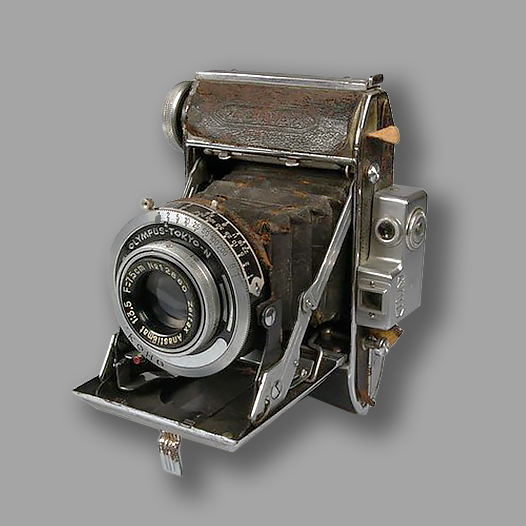
The Zeitax is a Japanese 4.5×6 folder, made from late 1940 or early 1941 by Motodori and related companies. The original Zeitax is a copy of the large Baldax model. The body is identical to the New Semi Condor, also made by Motodori. The back is hinged to the left and contains a single red window at the bottom left, protected by a vertically sliding cover. There is an exposure table on the back, written in Japanese. The name ZEITAX is embossed in the front leather in uppercase letters.


